https://www.blackgate.com/
When Satire is Overwhelmed by Reality: Moon Missing: Edward Sorel’s Report on Future Events
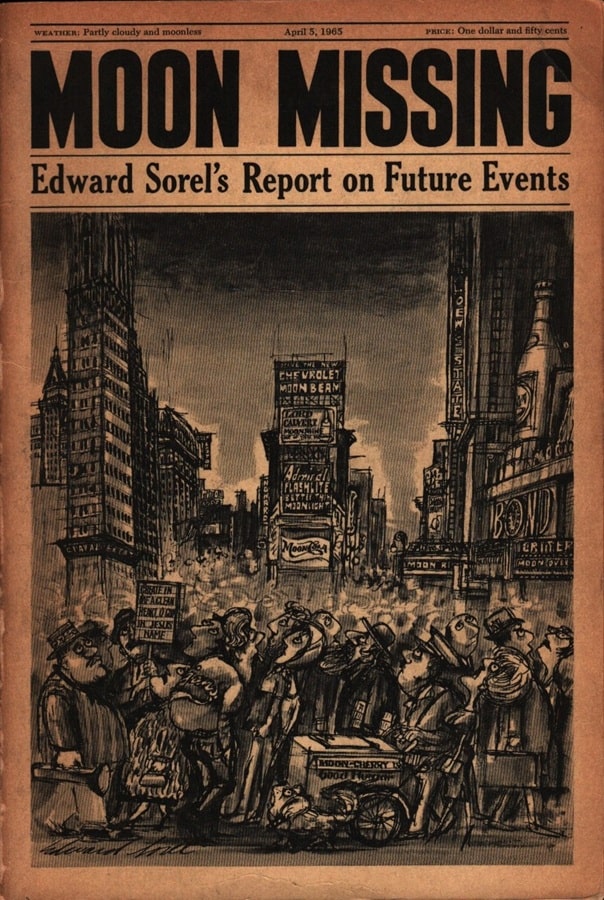 Moon Missing (1962)
Moon Missing (1962)
At about 1:46 am EST in the middle of the American night of April 4, 1965 the Moon disappeared. The American people were informed the next day at a Presidential news conference. President Kennedy was in no way responsible, said Allen Dulles, disgraced former CIA director but now Secretary of the Exterior, tapped to safeguard American interests in outer space.
Cartoonist, caricaturist, satirist Edward Sorel published Moon Missing in 1962. He had no need to prognosticate the future; the world around him gave him all the ammunition his ink Speedball B6 required.
So insistent are we today that the early Sixties were a more innocent time that the reality of the fear, paranoia, tension, and general unhappiness of the era can only be exhumed from period pieces. Sorel’s vision of the craziness ready to be let loose by a global event relied heavily on contemporary names in the news, but to find frighteningly many parallels in today’s world the names need only to be changed to modern equivalents.
 Edward Sorel in 1962
Edward Sorel in 1962
Born Edward Schwartz in 1929, Sorel found his artistic future while spending a year in bed as a child, much as young Richard Starkey found the drums as solace during a similar confinement. Still alive today and very much the Grand Old Man of caricature and cartoon satire with an endless catalog of important works, Sorel was a struggling freelancer in 1962. His early books for adults were such failures that even his own website doesn’t bother to mention them. To supplement the advertising work he was building a reputation for, he sent his satires out to every magazine that would accept such heresy, keeping his name before the public.
Moon Missing was excerpted in the motley foursome of Horizon, Sports Illustrated, Show Magazine, and Caterpillar. Caterpillar? Since the avant garde The Caterpillar Magazine didn’t debut until 1967 and the children’s magazine of that name was far in the future, I am forced to conclude he meant Caterpillar News and Views, the house magazine of the bulldozer giant. To imagine the improbability of that Venn diagram, try to conjure an appearance by R. Crumb in IBM’s THINK magazine. My brain boggles.
Moon Missing is set as a series of brief daily newspaper reports from the alternate future of 1965, the foundation Sorel uses for his plethora of illustrations. The double-page below sets the tone. New Yorkers parade down the sidewalk, oblivious to all but their smartphones – I mean, newspapers – while the news ticker accuses the Communists for the disappearance.
First to react is the Gallup Poll. The public is eternally divided on all issues.
And politicians are eternally hypocrites.
Clueless politicians can be found in every era, but the sweetener here is the reminder that J. Edgar Hoover used the FBI as a personal internal police, a part of the past we should never want revisited. “Involves national security.” Ring any recent bells?
Every bit of today’s battle of right and left wings already existed in 1965.
So much commentary is packed into these two pages alone.
Lest you think Sorel was himself nothing more than a muddle-headed liberal, be assured that he applied his gimlet eye to the Kennedy administration as well.
Fortunately for the economy, capitalists will always find a way to cope.
As world tensions soar, Kennedy and Khrushchev meet and sign a Mutual Moon Aid Pact, and talk about complete disarmament. And then the worst possible news.
 Look at the date. July 4. If you were Khrushchev would you think that was a coincidence? Or would even Americans? So much for world peace.
Look at the date. July 4. If you were Khrushchev would you think that was a coincidence? Or would even Americans? So much for world peace.
And Sorel, the old advertising guy, can’t help but add a coda that triggers the memories of us graybeards.
The book should have been a bestseller. Unfortunately for Sorel’s career, Moon Missing was published on the first day of the sensational and long-lasting New York newspaper strike. Few events speak more to New York’s absolute cultural dominance over the country in the early sixties. All other media took their cues from the New York papers. Anything not reviewed there had little chance of notice, much less success, elsewhere. The rave review in the Tampa Tribune didn’t save it. Kennedy’s assassination the next year thoroughly destroyed any chance of a later revival; reading about a living Kennedy presidency in 1965 would be little more than a sick joke, sicker than the ones Sorel actually told. (The hard-luck Sorel later created a poster attacking the war-mongering Cardinal Spellman of New York, but it was released the day the cardinal died. Live by satire, die by irony.)
The good news is that in 1963 Sorel was named art director of Monocle, a magazine of savage political satire that matched his sensibilities perfectly. From there he went to Ramparts, New York, and the National Lampoon, and was discovered by more mainstream magazines, seldom disguising his disdain for all that was wrong with society and politics. For me he will always be indelibly etched in my memory for his nsfw drawing of a rockette line of nude world leaders covering their private parts with large erect rockets pointed at the rest of humanity. If you dare, search for Robert Scheer’s Thinking Tuna Fish, Talking Death: Essays on the Pornography of Power, the most perfect title for a Sorel cover ever devised.
ETA: I have a coda as well and it may be less believable than Sorel’s satire. We live in a time when satire is overwhelmed by reality. Only datelines can differentiate them. While writing this article my eye was caught by a report on American First Policy Institute ambassador Kambree Nelson. Nelson was invited to the White House’s “new media” press conference for influencers where she gained attention for a particularly softball question, leading the curious to check her history. They quickly discovered that in October 2024 she sent a Xitter out to her 625,000 followers: “Has anyone seen the moon lately? I’ve been looking for 7 days.” When even some of her followers told her that the moon was right up there, she replied. “It’s not out. None of my friends in 4 states can find it.”
Tom Lehrer once proclaimed, “Political satire became obsolete when Henry Kissinger was awarded the Nobel Peace Prize.” Ironically, both he and Edward Sorel have lived to see this brave new world. Irony may not be dead, but satire is limping with both feet.
Steve Carper is the author of hundreds of articles on fascinating, if obscure and forgotten, tidbits of history, as well as the seminal book Robots In American Popular Culture. All of his websites are linked at SteveCarper.com.
Tubi Dive, Part VII
 Hellbenders (Lionsgate, October 18, 2013)
Hellbenders (Lionsgate, October 18, 2013)
50 films that I dug up on Tubi.
Enjoy!
Hellbenders (2012)I really should have saved this for later, for my exorcism watch-a-thon What Possessed You, but the mere thought of not watching a Clancy Brown movie kicked off my hives.
Hellbenders is an unholy romp written and directed by J.T. Petty (who brought us The Burrowers, among others) based on the graphic novel of the same name.
It concerns a secret order of multi denominational priests who are trained to defeat unbeatable demons. They do this by sinning as much as possible, then inviting the demon to possess themselves before committing suicide and dragging the entity to Hell. It’s a fantastic premise, and the numerous references to their sins (ranging from stealing newspapers and having disparaging thoughts, to committing adultery and colourful blasphemy) is a lot of fun. Priests aren’t sent out on exorcism missions if they’re not guaranteed to go to Hell.
Clancy Brown plays Father Angus, the leader of this motley troop, and possibly the greatest user of profanity I have ever seen. This film is worth it for his swearing alone, but for God’s sake don’t do a drinking game based on the number of times he says cocksucker — you will die.
Everyone in this cast does a great job, and I especially enjoyed Dan Fogel as a punchy priest, and Stephen Gevedon as ‘Clint’ (a hilarious animated segment reveals why “Clint’ shouldn’t be a superhero name).
The possessions are fugly, the violence is daft and bloody, and there’s lots of biting off of appendages.
I really enjoyed this one.
9/10
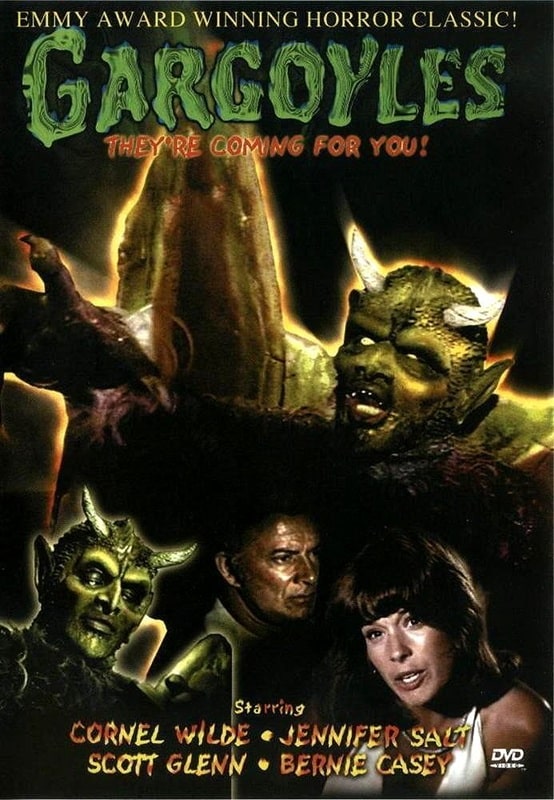
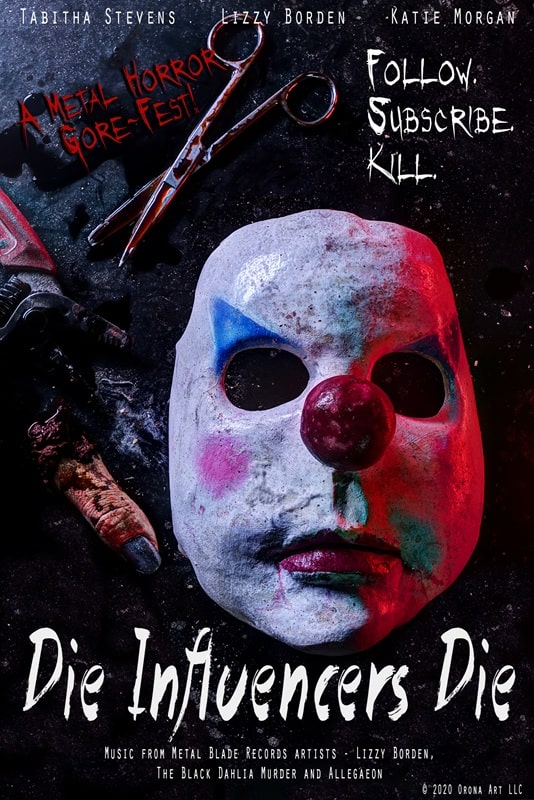
Gargoyles (CBS, November 12, 1972) and Die Influencers Die (Orona Art, 2020)
Don’t get excited, fans of the cartoon show (and potential Kenneth Branagh movie), this is a made for TV movie that was not bad for its time, and has developed something of a cult following.
Cornel Wilde and Jennifer Salt play Dr. Mercer Boley and his daughter, Diana. Dr. Boley is a leading authority on demonology, and his daughter feeds his obsession with trinkets she picks up around the world. They travel to a remote area in New Mexico called Devil’s Crossing — an area steeped in folklore and legend. There they encounter Uncle Willie, the owner of a roadside museum, who shows them a funky skeleton — before you know it, the gargoyles attack, and all hell breaks loose.
It’s a fairly tame flick, with a couple of slightly creepy moments, but the gargoyles don’t really stand up to scrutiny under the harsh lighting, and the action scenes are mostly choppy slow-motion. However, it licks along at a fair old pace, and it does feature Scott Glenn as a bad boy biker. You could say there’s an allegory blanketed under all of this regarding the treatment of indigenous peoples at the hands of settlers, but I ain’t here for no history lesson, mama.
Only recommended for the gargoyle-curious.
5/10
Die Influencers Die (2020)If you know me, there’s nothing I like more than seeing harm come to a) matadors, and b) internet pranksters, so this title obviously whetted my appetite.
Known in Germany as The Influencers, The (a Simpsons gag for loyal followers), this film is a low-budget schlock-fest with very little in the way of redeeming features. The nonsensical story concerns an abusive, toxic alpha-male influencer (a cross between Mr. Beast and Patrick Bateman) who wants to destroy the ‘careers’ of three rival influencers in order to ramp up his views. He does this by inviting them to a ‘haunted film studio’, then tries to give them dysentery with a made up energy drink that they are supposed to hawk for him. Little does he know that a malevolent demon is on site, and ready to chop up and eat anything in her path.
Said demon is the resurrected body of a model that was murdered by one of his assistants and stuffed in a fridge. She walks around at a jerky pace due to edited frames in a clown mask with duct taped nipples and a tutu. She’s apparently there for revenge, so why she kills the duped influencers (who did nothing to her) makes no sense. The whole thing is shot and edited like the most annoying music video you can think of, and is full of shock metal, partly due to the presence of Lizzy Borden as an illogical demon whisperer.
It’s annoying, grating and mean-spirited, and I can only recommend it to folks who like metal, plastic knockers and overacting.
3/10

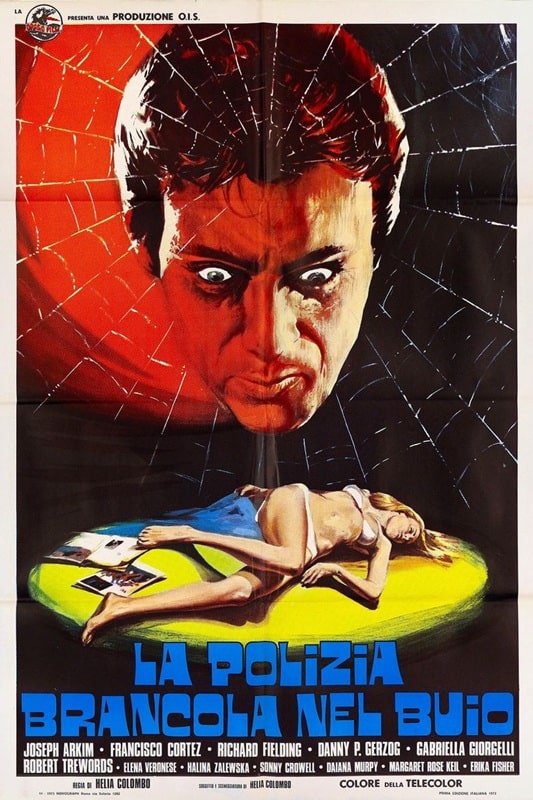
Monsternado (Uncork’d, November 14, 2023) and
The Police are Blundering in the Dark (O.I.S. Cinematografica, 1975)
Still on a kaiju high after Godzilla vs Kong, I foolishly tried to scratch my itch with this (potentially) fun flick. No sooner had it started, than I realized my mistake. It is an Uncork’d production.
Uncork’d makes The Asylum look like A24, but I bravely soldiered on.
Let’s get all the negativity out of the way. It’s not very good. The script is terrible, the acting is rubbish, and the effects are wonky at best.
I lied, here’s some more negativity. The thing that really irked me about this Sharknado knock-off was the filmmakers’ potential to do something really interesting with this idea. If you are going to have a plot reference mythical places like the Bermuda Triangle and Atlantis, then get some mythical monsters up in this windy shit.
As is, we are subjected to sharks, tentacles, gators, snakes, some token pterodactyls and aggressive scampi. If you’re going to spend the catering budget on CG, then at least make the monsters unique and fantastical.
I think it was supposed to take place in the US, but several shots of the Gherkin in downtown London, plus lots of dodgy American accents, gave up its true origins, and just keeping it set in England would have been a slight improvement.
It’s like I sometimes say to my children, “No, I’m not angry with you, just very disappointed.”
3/10
The Police are Blundering in the Dark (1975)Fancied a giallo, and this title caught my eye. It was originally titled The Salad Garden, and that would have made just as much sense, as there’s no actual coppers in this (ultimately rather dull) murder mystery.
The film has all the ingredients of a giallo, a POV killer dispatching young women, mandatory nudity, sexual repression, long talks around the dinner table, male hair product, but this one brings a science fiction twist to the proceedings. A wheelchair-bound photographer has invented a machine (the kind that goes wooo, woooo, and bathes the user in purple) that can photograph people’s thoughts — but this doesn’t really come into play until the end of the movie.
Instead we follow the apathetic investigation of a journalist looking for his missing friend while trying to pop the cherry of anyone he comes across. Being Italian and mid-70s, no one can be killed before their shirt has come off, in fact in the opening scene, the killer kindly tears his victim’s blouse so that she can gallop breastily through a copse before she becomes a corpse.
Possibly the most boring giallo I’ve ever watched, so I can only recommend it to fans of the Italian countryside, small cars, bosoms and lettuce.
4/10


Caddy Hack (Wild Eye Entertainment, December 10, 2023) and Blades (Troma Entertainment, 1989)
A double-bill, you lucky people. Here we have a pair of golf-related horror films that are on opposite ends of the quality spectrum.
Caddy Hack is bloody awful. It purports to be a comedy, but it is so desperately unfunny that I ended up hate-watching it for the final hour. The style of humor put me in mind of Mad Cow; self-referential, endlessly repeated (unfunny) jokes, deliberately rubbish effects, extreme mugging for the camera, horrible editing, and so on.
The story dispenses with the whole Caddy Shack plot, and instead focuses on the gophers, which in this steaming pile have been mutated by fertilizer. Throw in a Trumpy business owner, a thousand ‘ball’ jokes, and a Gremlins rip-off, and you have a recipe for a warm crap casserole. Avoid.
On the flip-side, Blades was an unexpected joy. I was honestly expecting a second-tier slasher featuring a lump of machinery, but I received a brilliant homage to Jaws, right down to the sound-alike music, story beats and set pieces. They played it straight, which elicited much more laughter from me than Caddy Hack, and a lot of thought was put into the direct adaptation of the original shark film. It gets better as the film goes on because you realize what’s coming up, and for this reason I wholeheartedly recommend Blades, especially for lovers of Jaws.
1/10 and 8/10 respectively.


Psycho Gothic Lolita (Pony Canyon, September 4, 2010) and Destroy All Neighbors (Shudder, January 12, 2024)
You did it! You’re about to read your 50th rubbish review of a film to be found in the bowels of Tubi!
It took me a while to settle on a final film. I started on Screecher of the Lagoon, but I’m tired of badly shot and acted efforts. I also started The Door in the Woods, but it was too serious for me to get into (I’ll return to it one day). So here we are.
Psycho Gothic Lolita (original title: Gothic & Lolita Psycho) sounded like a perfect fit. After all, I love psychos, I love ‘gothic’ and, um, I love psychos.
The film perfectly encapsulates the vibe of this entire watch-a-thon; bonkers action, extreme gore, body horror, dubious sexiness, and the sort of deadly umbrella that would make John Steed wet his pants.
It’s a revenge tale as old as time. Yuki’s mom is brutally killed by a gang of five ne’er-do-wells in black windbreakers, and so she dresses up as a ‘gothic Lolita’ (I just learned this is a thing) and exacts revenge Kill Bill style. Actually, there’s a lot of Kill Bill in this, right down to an eyepatch-sporting hit woman called ‘Elle’. There’s even a spoon-bender (who’s more proficient at lifting up skirts) called Yuro Gerao — which elicited a hearty guffaw from me.
It’s daft, bloody, and a heap of fun. A good way to go out.
8/10
Bonus Flick! Destroy All Neighbors (2024)Not a Tubi Dive (this is streaming on Shudder/Prime), this one is a deliriously fun throwback to the bonkers weird-a-thons of the 80s. Think Society, Brain Damage or Freaked.
Jonah (MST3K) Ray plays Will, a musician who just wants to finish his prog rock album. As he descends into madness, many unfortunate and bloody events occur, and he ends up in a world of wise-cracking corpses and insane riffs.
It’s obvious everyone is having a great time making this, and Alex Winter chews the scenery under 50lbs of rubber as an East-European nightmare, while Ray is an excellent straight man to the chaos. Daft, messy and entertaining.
8/10
Here are all 50 films I watched on Tubi, and my three favorites — a handy guide for purveyors of slop.
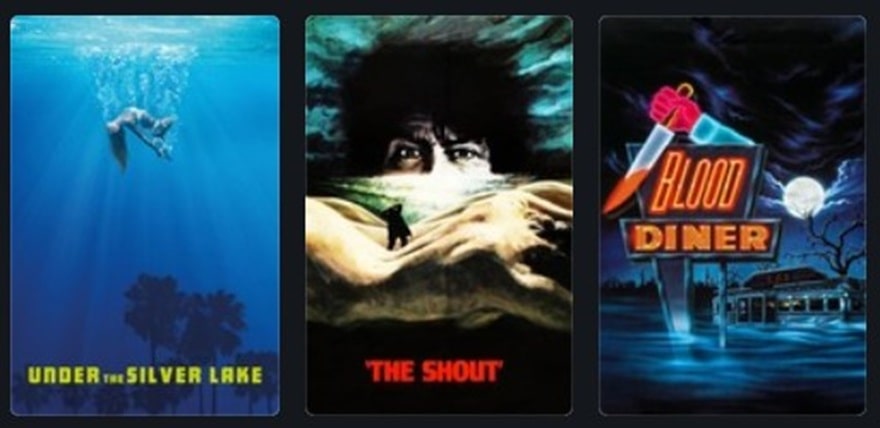 Tubi Dive — The Top Three
Tubi Dive — The Top Three
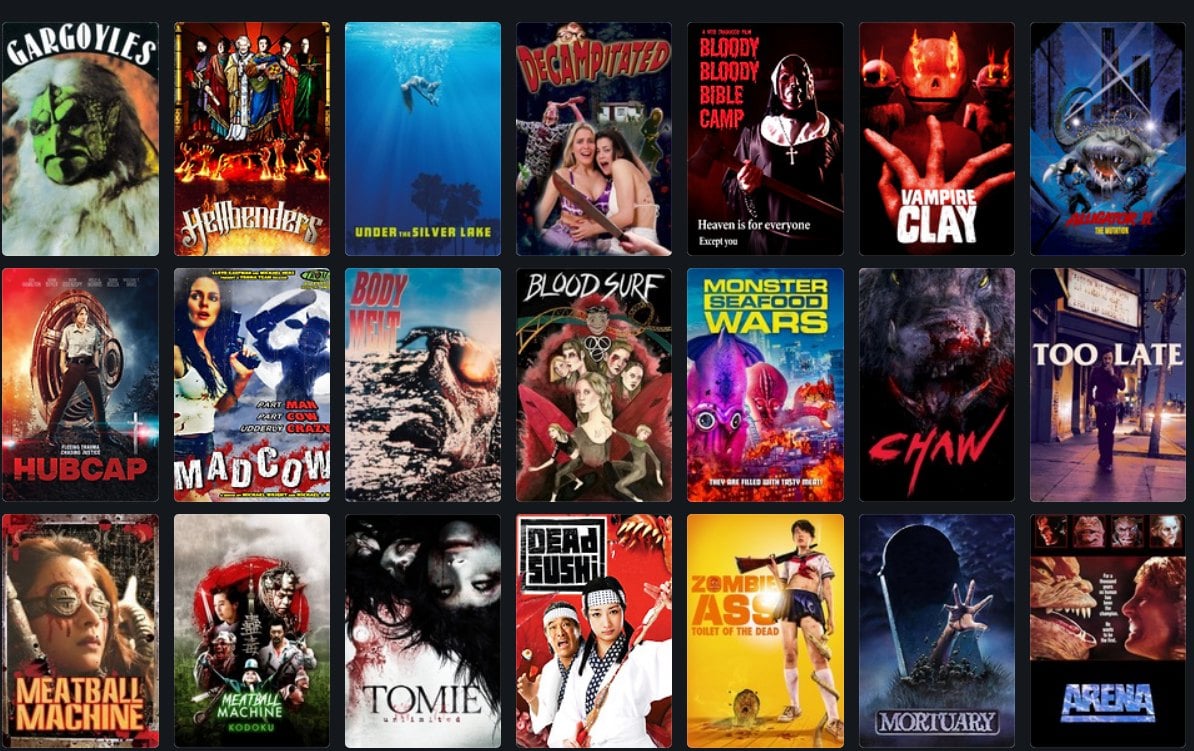 Tubi Dive 1
Tubi Dive 1
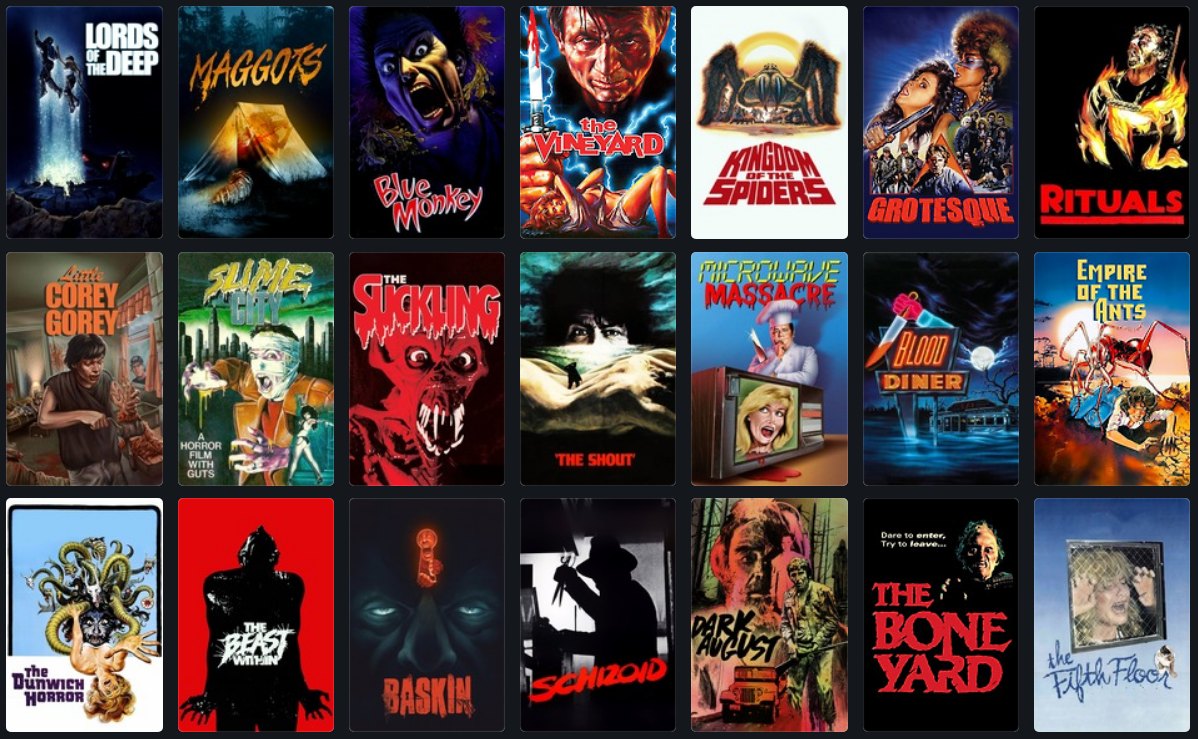 Tubi Dive 2
Tubi Dive 2
 Tubi Dive 3
Tubi Dive 3
Previous Murkey Movie surveys from Neil Baker include:
Tubi Dive, Part I
Tubi Dive, Part II
Tubi Dive, Part III
Tubi Dive, Part IV
Tubi Dive, Part V
Tubi Dive, Part VI
What Possessed You?
Fan of the Cave Bear
There, Wolves
What a Croc
Prehistrionics
Jumping the Shark
Alien Overlords
Biggus Footus
I Like Big Bugs and I Cannot Lie
The Weird, Weird West
Warrior Women Watch-a-thon
Neil Baker’s last article for us was Part VI of Tubi Dive. Neil spends his days watching dodgy movies, most of them terrible, in the hope that you might be inspired to watch them too. He is often asked why he doesn’t watch ‘proper’ films, and he honestly doesn’t have a good answer. He is an author, illustrator, teacher, and sculptor of turtle exhibits. (AprilMoonBooks.com).
Tor Doubles #7: James Tiptree Jr.’s The Girl Who Was Plugged In and Vonda N. McIntyre’s Screwtop
 Cover for Screwtop by Maren
Cover for Screwtop by MarenCover for The Girl Who Was Plugged In by Peter Gudynas
The seventh official volume of the Tor Doubles series offers two stories by women. Although the previous volume offered an excerpt from Gwyneth Jones’ novel Divine Endurance is addition to the selections from Barry B. Longyear and John Kessel, this is the first time women have provided the headlining stories in the series. James Tiptree, Jr.’s The Girl Who Was Plugged In and Vonda McIntyre’s Screwtop, both stories about women whose freedom was curtailed, are collected in this volume. As with the previous novel, this volume also includes an excerpt, in this case a three chapter piece from Ellen Kushner’s Swordspoint.
The Girl Who Was Plugged In was originally published in New Dimensions 3, edited by Robert Silverberg and published by Nelson Doubleday in October, 1973. It was nominated for the Hugo Award and the Nebula Award, winning the former.
James Tiptree, Jr. was a pseudonym for Alice B. Sheldon. Although known to be a pseudonym, it was long assumed that Tiptree was male, and Robert Silverberg, who edited this story before Tiptree’s real identity became known, famously declared “[i]t has been suggested that Tiptree is female, a theory that I find absurd, for there is to me something ineluctably masculine about Tiptree’s writing. The truth of Tiptree’s identity was revealed in 1977. The Girl Who Was Plugged In is the first of three Tiptree stories to be published in the Tor Doubles series.
Reading The Girl Who Was Plugged In in 2025, offers a very different experience from reading it when it was initially published in 1973 or reprinted as part of the Tor Double series in 1989. Although it seems clear that there was a satiric element in this when it was initially published, this it is one of those rare pieces of science fiction which looks prophetic in retrospect. The situation Tiptree described has come, in part, to pass.
Set at an indeterminate point in the future, Tiptree postulates a world in which advertising is illegal. Her story focuses on a young woman named P. Burke, who suffers from pituitary dystrophy, a disease which leaves her disfigured and, as Tiptree makes sure the reader understands, seem like a monster. Following a failed suicide attempt, Burke is placed into essentially a VR chamber and hooked up so she can manipulate a remote body, which becomes known as Delphi.
Delphi is designed to be an attractive woman and work as what we would now call an influencer. Her sole purpose is to be seen, make headlines, and have people wondering what clothing she’s wearing, what products she’s using, and where they might be able to purchase them.
Tiptree’s story is narrated by an unidentified voice who describes the way the world treats Delphi and her adventures mixed with the way the scientists who care for an manipulate P. Burke’s body and inputs. The narrative choice puts a distance between the reader and the characters, which serves to reinforce the isolation P. Burke is in and the faux reality through which Delphi moves, even as she finds herself in a relationship with playboy Paul Isham, who completely misunderstands the situation. As Isham falls in love with the Delphi he perceives, P. Burke, in her isolation chamber, is unable to separate the reality of her situation with the idea that Paul really sees and loves her and she falls in love with him.
Isham realizes something is wrong about the situation and he manages to figure out where the lab P. Burke is being held is located. Despite his failure to comprehend Delphi’s true nature, he attempts to rescue her from the clutches of the scientists who are holding her, resulting in a less than happy ending for nearly all of the story’s characters.
The Girl Who Was Plugged In offers a world of influencers and controllers. Delphi way be the influencer the world sees, but her content is provided by P. Burke, who remains hidden from Delphi’s adoring fans. As the story progresses, the language used to describe P. Burke becomes more and more harsh, removing layer after layer of her humanity. In the end, it is neither the consumer, the influencer, or the reality behind the influencer that benefits from the situation, but rather the powers the set up the situation, making The Girl Who Was Plugged In a cautionary tale for a world that didn’t exist when the story was originally written and published.
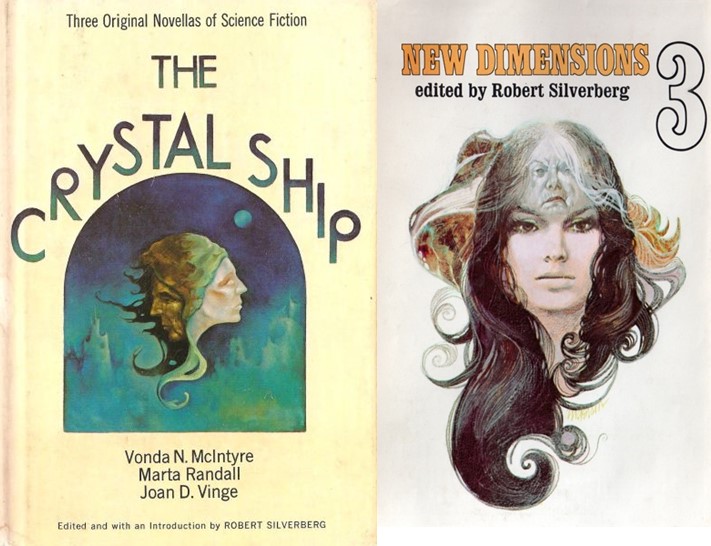 The Crystal Ship cover by Mike Mariano
The Crystal Ship cover by Mike MarianoNew Dimensions cover by Dennis Anderson
Screwtop was originally published in the anthology The Crystal Ship, edited by Robert Silverberg and published by Thomas Nelson in September, 1976.
Kylis is a spaceport rat, essentially a professional interstellar stowaway. A visit to the planet Redsun, however, ended her traveling days as she has been arrested and sentenced to penal labor at the Screwtop prison camp. Kylis strikes up a friendship, and eventually forms a family, with two other prisoners, Gryf and Jason, both of whom appear to be natives of Redsun.
Gryf is the product of tetraparents, a genetically crafted person who has the DNA of four separate parents. Meant to be highly intelligent, a glitch in the combination of DNA meant that he came out with strange coloring that set him apart from people. Gryf was also aware of Jason’s identity as a major philosophical author, which he shared with Kylis, although asking her not to let Jason know that they knew.
Focusing on Kylis, McIntyre depicts the horrors of the work camp. The throuple forced to the schedule set for them by the powers that be, represented in the camp by a guard called the Lizard. When their time allows it, they can seek solace in each other and form a family for themselves. This time almost makes their shifts working bearable.
The work is difficult. Screwtop is located on Redsun’s southern continent, which appears to be an uninhabited wilderness. Their job is to mine for geothermal energy, which is used to power the more massive and populated northern continent, where Gryf, Jason, and the majority of the prisoners are from. Naturally humid and hot, the mining process is even hotter and dangerous if precautions aren’t taken.
Once McIntyre establishes her setting and the characters’ relationships to each other, she is able to more fully explore the dynamics of the prison. Kylis reaches out to another woman prisoner, Miria, in a manner which may cause undue attention to be brought to her group. The Lizard approaches Kylis to extort not only sexual favors, but the implicit desire to have a child by her. The strength and purpose being in a supportive relationship with Gryf and Jason is demonstrated to have negative implications and it can be used against them.
In many ways, Screwtop feels as if it could be a prison story set anywhere, without the need for the science fictional elements. Kylis could merely be a runaway, Jason a dissident, and the workforce a regular mine. However, Gryf’s situation as the product of tetraparents becomes an important plot point. Although not fully explored, partly due to Kylis’s role as a narrator, his science fictional origin and upbringing, and his rebellion against it, focuses the story in him in the later pages as it becomes clear that his parents know of his whereabouts and may have the wherewithal to affect his release. More importantly, his way of dealing with the reality in which he finds himself is based on his unique situation.
Both Screwtop and The Girl Who Plugged In focuses on individuals who are trapped by other people, Kylis has more agency that P. Burke and the relationship Kylis has with Gryf and Jason, although not based entirely on reality of knowledge of the others, is a more authentic relationship than the one between Isham and Delphi. Similarly, McIntyre does not place a distance between the story and the reader by the expedient of having her narrator a participant rather than an observer.
The cover for Screwtop was painted by Maren. The cover for The Girl Who Was Plugged In was painted by Peter Gudynas. At only 136 pages, this volume is the shortest in the Tor Double series.
 Steven H Silver is a twenty-one-time Hugo Award nominee and was the publisher of the Hugo-nominated fanzine Argentus as well as the editor and publisher of ISFiC Press for eight years. He has also edited books for DAW, NESFA Press, and ZNB. His most recent anthology is Alternate Peace and his novel After Hastings was published in 2020. Steven has chaired the first Midwest Construction, Windycon three times, and the SFWA Nebula Conference numerous times. He was programming chair for Chicon 2000 and Vice Chair of Chicon 7.
Steven H Silver is a twenty-one-time Hugo Award nominee and was the publisher of the Hugo-nominated fanzine Argentus as well as the editor and publisher of ISFiC Press for eight years. He has also edited books for DAW, NESFA Press, and ZNB. His most recent anthology is Alternate Peace and his novel After Hastings was published in 2020. Steven has chaired the first Midwest Construction, Windycon three times, and the SFWA Nebula Conference numerous times. He was programming chair for Chicon 2000 and Vice Chair of Chicon 7.
The Suspension Bridges of Disbelief
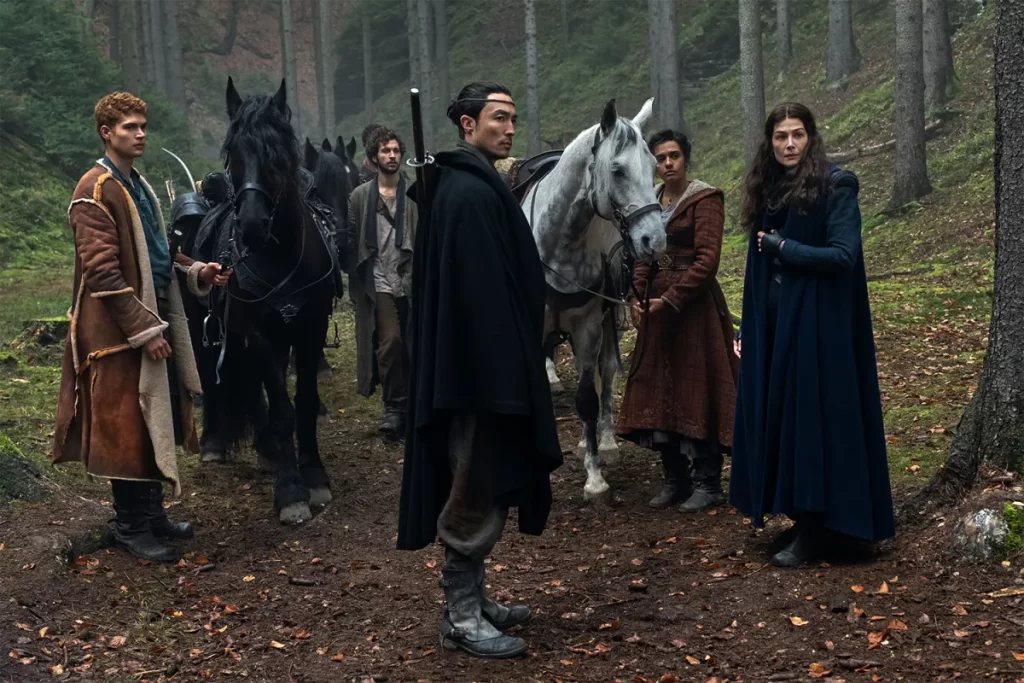 A friend and I have been watching The Wheel of Time adaptation on Amazon. Both of us expressed surprise not at the open casting, which we agree is wonderful, but at how that production choice plays out in small hamlets like Rand al’Thor’s “home town” of Two Rivers. After observing that every possible racial group is represented in this isolated, insular mountain community, my friend had an epiphany.
A friend and I have been watching The Wheel of Time adaptation on Amazon. Both of us expressed surprise not at the open casting, which we agree is wonderful, but at how that production choice plays out in small hamlets like Rand al’Thor’s “home town” of Two Rivers. After observing that every possible racial group is represented in this isolated, insular mountain community, my friend had an epiphany.
“I had to remind myself,” said my friend, “that if I suspend disbelief to accept that there’s magic in this world, then I might also have to suspend my disbelief in genetics.”
But isn’t it curious, how difficult this can be? The addition of magic in the Robert Jordan universe does not imply the generalized suspension of basic science, but the casting choices made in populating the Two Rivers absolutely does. Surely, under normal conditions, a group of people who initially look very different and then happily intermingle and intermarry over several generations would soon produce a population exhibiting mostly blended rather than outlying traits?
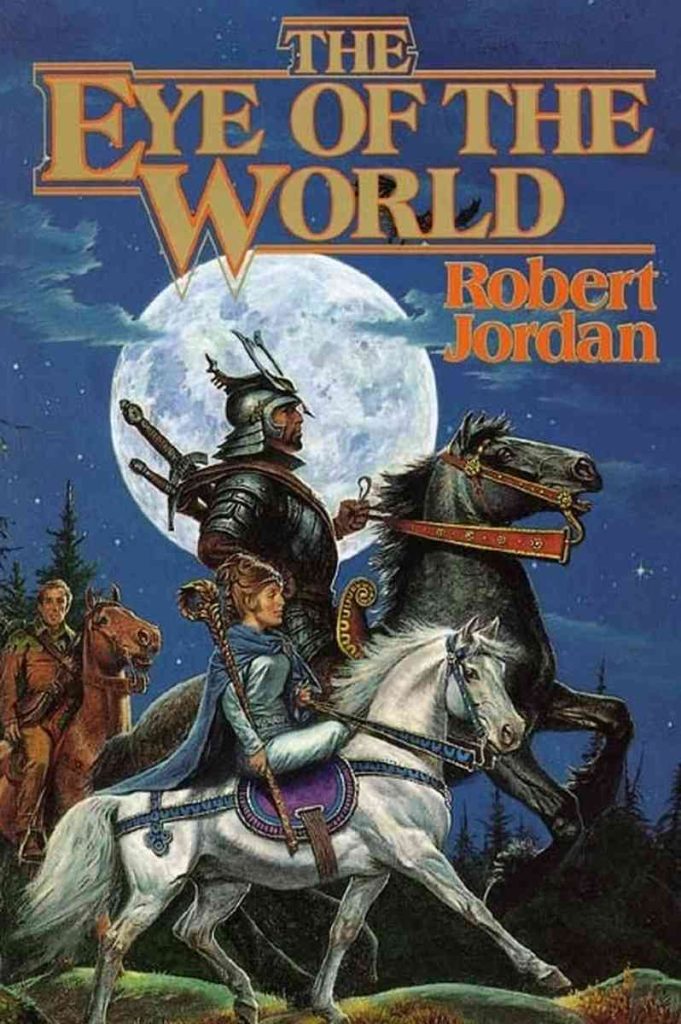 So, if genetics is getting tossed out the window, what’s next? Photosynthesis? The electron constant? Algebra?
So, if genetics is getting tossed out the window, what’s next? Photosynthesis? The electron constant? Algebra?
I once had a housemate who professed a hatred of musicals, both on stage and on film. He explained that he simply couldn’t get around the idea that when people feel a ton of emotion, they break into song. I thought (but did not quite say) that that’s exactly when people are most likely to spontaneously burst into song.
 Pro or con, musicals mark another instance where we either go along for the ride, suspending our disbelief when our heroes start warbling and trilling –– also when a brass band kicks in out of nowhere, playing (let’s say) “Seventy-Six Trombones”––or we cross our arms, huff and puff, and complain that musicals “aren’t realistic.”
Pro or con, musicals mark another instance where we either go along for the ride, suspending our disbelief when our heroes start warbling and trilling –– also when a brass band kicks in out of nowhere, playing (let’s say) “Seventy-Six Trombones”––or we cross our arms, huff and puff, and complain that musicals “aren’t realistic.”
But what is? Howard Shore’s exceptional score for The Lord of the Rings has nothing to do with realism. The Fellowship of the Ring is not accompanied on its journey by a traveling orchestra –– and if it were, wouldn’t we throw up our hands and declare the film to be entirely unbelievable?
 The easiest stunt to pull off when requiring readers or viewers to freeze-frame their disbelief is to offer up only a single element that’s not of this world. Lorrie Moore does exactly this in I Am Homeless if This is Not My Home (winner of the 2023 National Book Critics Circle Award) by asking us to accept that her hero’s deceased ex-girlfriend might want to embark on one final post-mortem road trip, bantering like a boss all the way. Everything else (well, almost everything else) is essentially normal, right down to the tarmac, the songs on the radio, and said girlfriend’s steady rate of decay.
The easiest stunt to pull off when requiring readers or viewers to freeze-frame their disbelief is to offer up only a single element that’s not of this world. Lorrie Moore does exactly this in I Am Homeless if This is Not My Home (winner of the 2023 National Book Critics Circle Award) by asking us to accept that her hero’s deceased ex-girlfriend might want to embark on one final post-mortem road trip, bantering like a boss all the way. Everything else (well, almost everything else) is essentially normal, right down to the tarmac, the songs on the radio, and said girlfriend’s steady rate of decay.
 Sometimes, one encounters a writer who appears to be sticking to the world as it is, but elements of dream or otherness are allowed to intrude, often with unpredictable results. The reader is themselves suspended, learning with every new-turned paged to be watchful, wary of what is real and what is not. Kathleen Jennings takes this approach in Flyaway, where disbelief is not so much suspended as it is actively cultivated. John Crowley’s Little, Big proceeds in much the same fashion.
Sometimes, one encounters a writer who appears to be sticking to the world as it is, but elements of dream or otherness are allowed to intrude, often with unpredictable results. The reader is themselves suspended, learning with every new-turned paged to be watchful, wary of what is real and what is not. Kathleen Jennings takes this approach in Flyaway, where disbelief is not so much suspended as it is actively cultivated. John Crowley’s Little, Big proceeds in much the same fashion.
But in general, suspension of disbelief works best in an additive sense. The story-teller allows for some new power, something that piggy-backs on the world already known. For example, in The Fifth Season, N.K. Jemisin allows for “orogenes” who control stone, a supernatural power built on what we already accept of geology and plate tectonics. Similarly, in Marvel Comics lore, the character known as Storm can control wind and weather –– but her powers depend explicitly on phenomena with which we are already familiar.
 Even the finest works of the fantastic have their awkward moments. In HBO’s Game of Thrones, there’s a scene in which the Onion Knight, Ser Davos Seaworth, breaks young Gendry out of prison and sets him in a rowboat. When Gendry faces the wrong way, Ser Davos asks, “Have you ever been in a boat?” and Gendry answers, “No,” but the very next moment, he’s feathering the oars like a pro. All I can do is shake my head. Rowboats require practice: you’re facing the wrong way while steering, and each oar (long and heavy) functions independently. In the ocean, as Gendry is, every single wave impacts the oars differently. I’m forced to say that, as written, this charming, comic scene swan dives right over the cliff of believability. If poor Gendry has never rowed, all the royal blood in the world won’t help him. He’ll never get past the breakers, much less to the supposed safety of some far and distant shore.
Even the finest works of the fantastic have their awkward moments. In HBO’s Game of Thrones, there’s a scene in which the Onion Knight, Ser Davos Seaworth, breaks young Gendry out of prison and sets him in a rowboat. When Gendry faces the wrong way, Ser Davos asks, “Have you ever been in a boat?” and Gendry answers, “No,” but the very next moment, he’s feathering the oars like a pro. All I can do is shake my head. Rowboats require practice: you’re facing the wrong way while steering, and each oar (long and heavy) functions independently. In the ocean, as Gendry is, every single wave impacts the oars differently. I’m forced to say that, as written, this charming, comic scene swan dives right over the cliff of believability. If poor Gendry has never rowed, all the royal blood in the world won’t help him. He’ll never get past the breakers, much less to the supposed safety of some far and distant shore.
And yet, I’m perfectly happy to believe in three-eyed ravens and the faceless men of Bravos.
 Perhaps the loftiest trick of all in the juggling game of disbelief is to remove some element that we have trouble imagining living without. Gravity, for example. The relative hardness and density of metal. Inertia. Strip away even one those three, and then try writing up a believable sword-fight. Good luck to ya’.
Perhaps the loftiest trick of all in the juggling game of disbelief is to remove some element that we have trouble imagining living without. Gravity, for example. The relative hardness and density of metal. Inertia. Strip away even one those three, and then try writing up a believable sword-fight. Good luck to ya’.
And this, perhaps, is why it is easier, when watching Amazon’s The Wheel of Time, to accept the One Power and way-gates and trollocs than it is to believe in a remote, mountainous outpost where the population covers just about every color of the human rainbow.
Magic, we buy (in part because it’s great fun to do so).
But reality?
Reality bites.
Onward.
Mark Rigney is a writer and long-time Black Gate blogger. His work on this site includes original fiction and perennially popular posts like “Adventures in Spellcraft: Rope Trick.” His new novel, Vinyl Wonderland, dropped on June 25th, 2024. Reviewer Rich Horton said of Vinyl Wonderland, “I was brought to tears, tears I trusted. A lovely work.” His favorite review quote so far comes from Instagram: “Holy crap on a cracker, it’s so good.” A preview post can be found HERE, while his website lives over THERE.
The Lost World
You may have heard about the recent statements made by Netflix CEO Ted Sarandos, a man who combines all the best qualities of Dr. Jack Kevorkian and Alaric the Goth in one natty package. As reported by Variety on April 28th, the streaming mogul declared that the precipitous decline in in-person movie attendance which began several years ago and has reached near-catastrophic proportions in the years following COVID is easily understandable; indeed, it communicates a clear message:
What does that say? What is the consumer trying to tell us? That they’d like to watch movies at home, thank you. The studios and the theaters are duking it out over trying to preserve this 45-day window that is completely out of step with the consumer experience of just loving a movie.
Relegating the theater experience that has defined the industry (to say nothing of wider American culture) for the past nine decades to the dustbin of history, Sarandos shined a dazzling light on our murky cultural landscape:
Folks grew up thinking, I want to make movies on a gigantic screen and have strangers watch them and to have them play in the theater for two months and people cry and sold-out shows… It’s an outdated concept.
Thank you, Ted, for clearing that up for us. I’m sure Scorsese and Coppola and Lee and Tarantino and Bigelow are happy to have the benefit of your sage counsel.
Lustily chomping his cigar and aggressively pounding his fist on the table (okay, I made that part up), the Netflix boss further said that the decline of movie theaters doesn’t “bother” him. He would be bothered, he added, if “people stop making great movies.”
Now I’ve seen the typical Netflix product, and you’ll forgive me if I think that Mr. Sarandos wouldn’t know a great movie if Bette Davis walked up with one in a steel film can and broke his nose with it.
 Fasten your seat belt, Ted — it’s going to be a bumpy night!
Fasten your seat belt, Ted — it’s going to be a bumpy night!
If you sense a certain bitterness in my remarks, you’re right, and that sourness stems less from my distaste for Mr. Sarandos and his cavalier attitude towards something that I love than from my suspicion that he’s right, damn it. Much as I might regret it, it does appear that the kind of moviegoing experience that many of us have taken for granted for our entire lives is rapidly — and probably irrecoverably — becoming a thing of the past.
Some hard-hearted realists might say that mourning the decline of moviegoing (as in actually going to the movies) is as silly, pointless, and socially and economically regressive as bemoaning the fact that the buggy-whip industry isn’t what it used to be.
As a practical matter, that might be so, but I still feel entitled to mourn the loss. Why?
To be moved, whether you are frightened or thrilled, brought to tears or to laughter, is an experience that you can certainly have in your living room, alone or with one or two other people, but that’s a fundamentally different experience than feeling those same emotions in a room filled with many other people, in a place dedicated (I almost said consecrated) to undistractedly watching the movie and nothing else, a unique space where no one (ideally) is chatting, looking at their phone, constantly moving around the room, or pausing the action while they stroll to the bathroom or go to the door to get the Grubhub order.
The darkness, the size of the space and the close physical proximity of so many other people, the scale of the screen and the depth of the sound, the sustained, even relentless nature of the experience (to say nothing of the fact that because you’re leaving the house to do it, it’s something that actually requires a degree of planning), and yes, the cash outlay — even if the movie itself is a negligible piece of fluff, these factors all combine to make the in-person experience itself larger and more weighty.
Of course, every difference I just mentioned is, for an increasing number of people, a bug and not a feature. In that, Ted Sarandos is right. More and more people do seem to prefer streaming at home over the older way of seeing movies. I know, I know, who has the time anymore? Who has the money? And what about the kids? Anyway, how many movies are good enough to warrant going through all the hassle?
I can’t argue with any of these objections; I feel their force myself. And yet I think we’re going to lose something precious if going to the movies becomes some sort of boutique experience limited to a few large urban areas. Sarandros himself pointed to this as a likely future, saying, “If you’re fortunate enough to live in Manhattan, and you can walk to a multiplex and see a movie, that’s fantastic. Most of the country cannot.” (I don’t know where Ted lives, but apparently he pictures the rest of the country as some sort of vast Hooterville where people wander among the cornstalks, desperate for entertainment.)
The “concept” dismissed as “outdated” by Ted Sarandos has played a major part in my life ever since I can remember. My parents loved movies and “going to the show” was one of my commonest experiences growing up; we literally did it all the time, and I continued to go on my own or with friends as I got older. I have countless memories connected with seeing movies in actual theaters or at the drive-in, and the record of my moviegoing forms a kind of alternate history of my life; it’s probably the same with you. Here are a few of my random moviegoing memories, and they’re all the more powerful because they’re not just mine; they’re collective memories shared in one way or another with the hundreds of people who were with me in the theater at those moments, and with the millions who experienced the same feelings when they saw the same movies in their own hometown theaters.
(You will notice that all of these movies are from the 60’s and 70’s. I have had memorable theater experiences in just about every decade of my life — Dead Ringers, anyone? — but these came to my mind first. Given my topic, it’s probably no surprise that I’m feeling excessively nostalgic right now.)
Summer, 1975. On vacation, visiting my cousins in Texas, we went to see something called Jaws. American movies and culture would never be the same. The shriek of delighted terror and terrified delight that burst from my fourteen-year-old mouth when that corpse’s head popped out of the submerged boat and scared the bejeezus out of Richard Dreyfuss, and me, and all the people surrounding me… well, I didn’t even hear myself, because my ears were too busy ringing from the identical sound that had just come from everyone else.
Quentin Tarantino has said that Jaws is the greatest movie (as opposed to the greatest film) ever made, because it delivers all those quintessential screaming/laughing movie pleasures more perfectly than anything else that’s ever been on the screen. If you were there in 1975, you can only agree with him.
Spring, 1979. My buddy Eddy’s mom said she would take us to the show to see a horror movie. She loved horror movies; she had already taken us to the drive-in to see The Brood and The Corpse Grinders. That’s what I call a great mom. When my mom (also a great mom) heard that Ruth was going, she said that she would join us. I told her that she really didn’t want to do that; the movie we were going to see was called Dawn of the Dead and it was not a Vincent Price campfest, which was what she was expecting from a horror movie. “You don’t understand, Mom — this movie has zombies that eat people!” She tsk-tsked me and insisted on coming along.
Five minutes in, in an apartment building infested with the living dead, a woman spots the shambling corpse of her husband; she runs up to him and embraces him, whereupon he takes a huge bite out of her neck as the blood gushes by the gallon. That woman was no more shocked than my mom, who grabbed her purse, stood up, and walked out of the theater. “I told you!” I shouted as she exited.
Spring, 1968. My mom gave me a day off from school. Why? She was going to drive me into Los Angeles so we could see 2001: A Space Odyssey at the fabled Cinerama Dome. (I told you she was a great mom.) She had told my teacher the day before that it would be “very educational.” The enormous curved Cinerama screen, the eye-popping special effects and overwhelming sound, the rapt enthrallment and utter bafflement of the audience — it has all stayed with me to this day.
As stunned people stood around on the sidewalk afterwards, there was a steady chorus of “What does it mean? Do you know what it means?” “I know what it means!” I recklessly piped up. As all those pairs of adult eyes focused on my seven-year-old self, I realized that I should have kept my big mouth shut. I didn’t know what the movie meant; I only knew that I had just had one of the greatest days of my life, and that I loved my mom.
Fall, 1979. At the Cinerama Dome again, my friend Sutton and I arrived at the last moment to see one of the first showings of Apocalypse Now, and the only seats left were in the first couple of rows. The Dome’s screen was eighty-six feet wide and thirty-two feet high; from our seats, it was like crouching at the foot of Mont Blanc. When the movie opened with a napalm strike, I felt like every millimeter of my optic nerves were on fire, and during the “Ride of the Valkyries” helicopter strike I crouched in my seat to keep from being eviscerated by a mortar round or decapitated by a helicopter blade, and I knew that everyone else in the theater was doing the same thing, even those who had more rational seats than we did (I told Sutton we should have left home earlier).
Every person in the audience knew that they were seeing something beyond the realm of the normal; we were witnesses to an outrageous, crazily ambitious, magnificent once-in-a-lifetime folly that no one there would ever forget. It was probably my supreme experience at the movies, and it wouldn’t surprise me if a lot of the people who were there that night almost forty-six years ago look back and think about it that way too.
One more. Fall, 1977. The movie is, believe it or not, Race for Your Life, Charlie Brown! This time Sutton and I left in plenty of time to get decent seats, and anyway, we didn’t have to drive as far to get to the theater. (The Cinerama Dome usually didn’t book Charlie Brown movies.) We had a Saturday with nothing to do and the only thing showing was this Peanuts movie. Well, why not? The theater was full to overflowing with kids — I didn’t see an adult in sight. We two high-school boys were apparently the oldest people present. Clearly this mediocre cartoon was a golden opportunity for parents to dump their spawn for a couple of hours and have a little time for… well, other stuff.
Things held fairly steady until the lights went down, and then pandemonium reigned. You’ve read Lord of the Flies? It was like that. The air was instantly full of flying popcorn boxes and other trash, and the soundtrack was drowned out by an insane cacophony of laughs, shrieks, yells, catcalls, arguments, profanities. You couldn’t see the movie; you couldn’t hear the movie. The aisles were filled with kids running up and down, falling, rolling, jumping, kicking, crashing. One kid sitting several rows forward took umbrage at something the urchin sitting directly in front of us said or did and came flying from his seat, and jumping astride the offender, pinned him in place and started whaling on him as the surrounding kids cheered; it was like having a ringside seat at Ali-Foreman. We were too stunned to intervene (others quickly did), and we bolted for freedom as soon as the final credits rolled, happy to escape with our lives, but I have never forgotten that kiddie matinee; it permanently darkened my view of human nature and blighted my belief in the possibility of building anything lastingly good in this world. And all it cost me was, what? Two bucks and a little gas money? Now that’s what I call a bargain.
Beat that, Ted Sarandos.
Thomas Parker is a native Southern Californian and a lifelong science fiction, fantasy, and mystery fan. When not corrupting the next generation as a fourth grade teacher, he collects Roger Corman movies, Silver Age comic books, Ace doubles, and despairing looks from his wife. His last article for us was Writ in Water: V.E. Schwab’s The Invisible Life of Addie LaRue
Get it While You Can: Manly Wade Wellman’s Cahena Going Out of Print
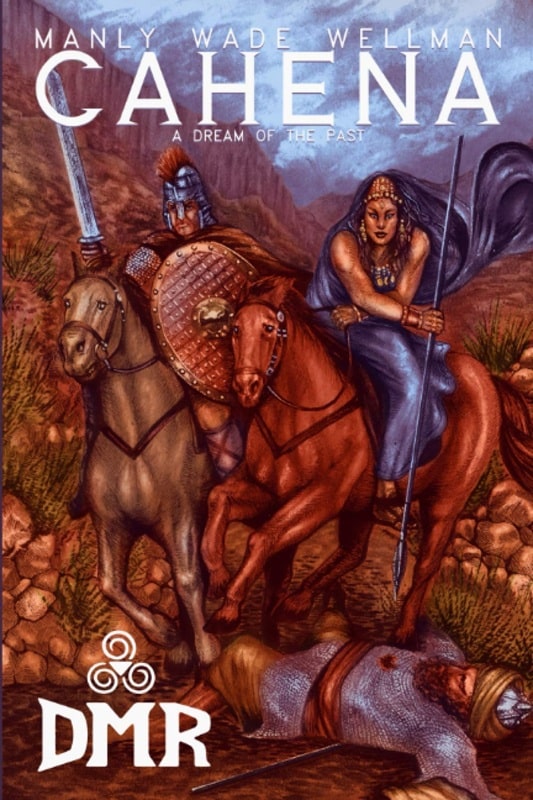

Cahena by Manly Wade Wellman (DMR Books, November 1, 2020). Cover by Lauren Gornik
I’m hearing reports that Manly Wade Wellman’s final novel Cahena, out of print for nearly 35 years until DMR released a handsome new edition in 2020 with a striking cover by Lauren Gornik, is on the verge of going out of print again.
Cahena is an overlooked gem in Wellman’s distinguished catalog. A historical novel with fantasy elements, it tells the tale of the legendary Berber queen who lived in the 7th Century in North Africa, and led her people against the Romans and later Muslim invaders. The Cahena, as she was known, was said to be both a sorceress and prophetess, and she led an army forty thousand strong in a valiant struggle to save her beleaguered people.
DMR’s rights to the book expire this month, and at the end of May it will not longer be available. Morgan Holmes says that with this final novel, “Wellman went out on top.” If you’re a Wellman fan, or a fan of quality adventure fiction, grab a copy while you can. Don’t wait another thirty-five years for the next reprint! Order directly from DMR Books here.
The Writer and the Boycott
 Image by Niek Verlaan from Pixabay
Image by Niek Verlaan from Pixabay
Good afterevenmorn!
Well, I’m talking boycotts again, as there is a lot of it going around. And they are absolutely kicking up all kinds of dust. This is great – making your voice heard with the only thing these companies seem to understand; their bottom lines. It’s not so great if you’re an innocent writer just trying to make a living who happens to be caught in the crossfire.
Some few writers like myself are trying to divest from unethical companies (I’m not going to name them, but we all know, right?). But we are quite few, and it’s only, at least in my case, quite a light boycott. My books are still available on sites I’d rather no be on, as I want to offer something for those readers who have no choice but to use that site. That’s the unfortunate thing a near monopolies like this. Some folks have no other option. I do have my books available in other places, too, and encourage folks to buy there instead if they can.
It is an unfortunate truth that writers are largely stuck with these behemoth companies. Many self-published or small press authors make (or made) quite a decent living selling through these companies, sometimes exclusively. Good for them, honestly. That’s great! Less great now, however. Buyers, you see, are also boycotting these large companies. And that spells trouble for writers.
 Image by Лариса Мозговая from Pixabay
Image by Лариса Мозговая from Pixabay
I’ve seen more than one post on social media of writers reminding readers that these big companies don’t really feel their absence, but we writers absolutely do. And they’re not wrong. When people stop buying books from one of the largest sellers of books, the folks who depend on that site to sell feel it first and hardest.
It’s not a an easy spot to be in. I’m incredibly proud of everyone who are now putting their feet down and refusing to give money to sites, and the people behind these sites who are actively making the world a harder place to be in. I’m also feeling for those who were making their livings by selling on the very sites that people are actively avoiding. It’s a tough situation all around.
 Image by PDPics from Pixabay
Image by PDPics from Pixabay
Before we go on, I do want to make a giant caveat to what I’m about to say next. I don’t make a living selling books on these sites. I don’t make a living selling books period. I’m a terrible marketer, and perhaps a mediocre writer, so I don’t make a living selling books. I’d really like to, and perhaps one day I’ll get there, but I do not currently. I work full time and am scraping by without having to rely on book sales. Everything I say here will probably feel hollow for those who are currently suffering for those who are caught in this fight.
With that said, I remain firmly on the side of the boycotters. I am also boycotting as much as I can. Book purchases are now made at the bookstore nearest me. It’s not always convenient, but a half hour walk to the shop is something that I’m willing to do in order to avoid using these sites. I don’t think readers should be guilted into abandoning their causes. I do think it’s up to us as writers to try and adapt to the changing landscape. There are a couple of ways to do this. Probably more, but if I do more than two, I’ll be writing this forever.
 Do not put all your eggs in one basket.
Do not put all your eggs in one basket.Image by Gerald Friedrich from Pixabay
The most important thing I think writers can do currently is diversify
Some sites have huge incentives for exclusivity. Make them the only site your book can be purchases or read from, and you get a bigger cut of the profits. It can be incredibly enticing. If possibly, avoid that temptation and put your books up on multiple sites – including your own. There are a lot of ways to create an online shop and start selling direct. It does require a lot more marketing work, as discoverability is a huge issue here.
But I do know book shoppers often are exposed to the marketing of these big sites, and then go hunting to see if the author is selling direct. This is especially since folks are being much more selective about where they source their goods and with whom they spend their money.
There is a further downside, and that is how bestsellers are counted. Personal sales don’t usually count towards the numbers. But if you care more about earning a living than making lists, then it’s not that much of an issue.
Plus there are other bookselling sites where you can sell, and those numbers will count.

Another thing to consider is a subscription model. This isn’t instead of diversifying, but in addition to. For those who are unaware of what this model means, essentially, that people will pay a small amount monthly in exchange for some exclusive content. There are quite a few companies that offer this service (for a cut, of course). The two big ones that I’m aware of are Patreon and Ko-Fi.
For both of these sites, you can set the monthly amount, and even charge different amounts for increasingly awesome exclusive stuff. This tiered subscription can be set to whatever amounts you wish. I know some folks who have subscription tiers at $20.00 a month or more. If you like, you can limit the number of those subscriptions, so you’re not spending all your time trying to fulfill your subscription obligations instead of writing. So perhaps you have a tier at $50.00, in which you provide a monthly handwritten letter, and an automatic awesome loot box with every book release a month, but only two slots for that tier. So you don’t end up spending a tonne of money and time getting those book boxes together and writing letters. The great thing about this is that you can structure it whatever way you want.
I have a Ko-Fi page (obligatory link here. That felt icky. Let’s move swiftly on). I chose it because they also offer an online shop, which has the option of selling to the general public or to one or more of your subscription tiers exclusively, and even an option to accept commissions if you want.
I am very limited on time and ability, as I work full time, so I know I don’t have a lot of time to create for my subscribers. For that reason, I’ve set the monthly amount very low ($1.00), and have only one tier. Subscribers get exclusive blog posts. They will be the only ones able to purchase the special editions of my books, when I get the time to create them (a special edition of The Dying God & Other Stories is currently in the works, with a subscriber exclusive cover and five all new full-colour illustrations). They also have first read of any of the serials I write. They were the first to read The New Haven Incident, and will be the first to read The Bear when I’ve finished writing it. They also get free recipes when I make something I feel is worth sharing. And I’m aiming to offer them free calendar print-outs with original artwork each year. It’s not much, because I cannot yet abandon the office job. Perhaps one day I will be able to, and I can start offering more to my subscribers.
I really like the functionality of Ko-Fi, and now use it as my shop, saving me the costs of hosting my own on my website. Other people choose Patreon because it has other features they find more convenient. I am a fan of being able to set a post as exclusive for a time period of your choosing before it becomes public. You have to do that manually on Ko-Fi.
 Image by christian schwartz from Pixabay
Image by christian schwartz from Pixabay
This isn’t to say that doing either of these things will go well for a writer. I am evidence of that. I don’t sell many books, and I don’t have many subscribers. Fortunate, then, I have full-time work, or I’d be in real trouble. I know that not everyone is fortunate enough to be in that position.
It’s a difficult journey, this writing thing, and should not be embarked on lightly. Boycotts are not making it any easier. We must muddle through as best we can in the weird, unstable world we find ourselves in. The important thing is not to give up. We need stories, perhaps now more than ever. So keep trying to find your way through. I’m here cheering you on. We can do it.
When S.M. Carrière isn’t brutally killing your favorite characters, she spends her time teaching martial arts, live streaming video games, and cuddling her cat. In other words, she spends her time teaching others to kill, streaming her digital kills, and a cuddling furry murderer. Her most recent titles include Daughters of Britain, Skylark and Human. Her serial The New Haven Incident is free and goes up every Friday on her blog.
The Public Life of Sherlock Holmes: 52 Weeks: 52 Sherlock Holmes Novels – Kurland’s The Infernal Device
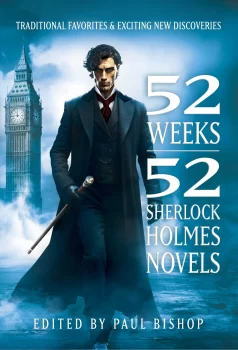 So, Paul Bishop is a friend of mine, and he wrote the very first post in Black Gate’s award-nominated Discovering Robert E. Howard. He talked about Howard’s boxing stories. Before those Pulps dried up, Howard wrote prolifically for them, with Sailor Steve Costigan his most popular creation.
So, Paul Bishop is a friend of mine, and he wrote the very first post in Black Gate’s award-nominated Discovering Robert E. Howard. He talked about Howard’s boxing stories. Before those Pulps dried up, Howard wrote prolifically for them, with Sailor Steve Costigan his most popular creation.
Paul is a major Westerns guy, and with Scott Harris, he put together 52 Weeks: 52 Western Novels, in which a slew of folks wrote about their favorite Westerns. It’s a cool format, and 52 Weeks: 52 Western Movies, and 52 Weeks: 52 TV Westerns, followed. The ’52’ number flows nicely with reading one a week, right? I have read the Novels, and Movies, books, and I think they’re cool for Westerns fans.
Paul reached out to me last year, and asked if I was interested in contributing a chapter to a 52 Weeks: 52 Sherlock Holmes Novels, project. Write about a non-Doyle pastiche? Heck yeah!!! In the end, I wrote four of them, so I’ve got a good 7.6% of the reviews. I covered Hugh Ashton’s The Death of Cardinal Tosca; John Gardner’s The Return of Moriarty; Michael Kurland’s The Infernal Device: and Frank Thomas’ Sherlock Holmes & The Sacred Sword.
We all followed the same format; well, we were supposed to. I know I did. So, to help promote this cool book, which came out last Friday (paperback and digital), here’s the first of the four I wrote. I’ve long been a fan of Kurland’s Moriarty books, and this is where it all started for me with him. Enjoy!
THE INFERNAL DEVICE
Michael Kurland
Published 1978
Contributor – Bob Byrne
BOOK FACTS
 Version 1.0.0
Version 1.0.0
James Moriarty is THE great villain of the Canon. Until financial considerations caused Arthur Conan Doyle to do some revisionist history, Moriarty was the man who killed Sherlock Holmes. The Professor has become a popular character in Holmes pastiches, with novels and entire short story collections dedicated to him.
It’s no surprise that it’s fun to flesh out the character: There are untold possibilities. Elsewhere in this book, I wrote about John Gardner’s The Return of Moriarty, with the professor being a Victorian Era Mafia Don, with a crime family doing his bidding.
Michael Kurland’s Moriarty is a scientist, always looking to solve nature’s mysteries. He undertakes criminal enterprises to pay the bills, as it were. He doesn’t search out crimes – people come to him and he decides whether or not to take on the job. Moriarty isn’t a spider at the center of a web of all London’s crimes, though Sherlock Holmes is (wrongly) obsessed with him. We learn that Moriarty was Holmes’ math tutor, but their different paths set Holmes after him.
The stories are told from the perspective of an American journalist named Barnett, who Moriarty frees from a Turkish prison (he was framed for murder) in exchange for two years of employment. Barnett runs a news service, selling local British and European news to American newspapers. The information he gathers is useful in his role as Moriarty’s assistant.
Holmes unsuccessfully tries to pin a kidnapping on Moriarty, but eventually teams up with him to stop an attempt on the Queen’s life. The ‘infernal device’ is a prototype weapon of destruction, and hot air balloons play a key role. Reminds of me of the recurring theme of ‘The coming thing’ from The Adventures of Brisco County, Jr..
Kurland writes a good Holmes, and his Moriarty is an interesting character. No saint, but not a devil, either. The follow-up novel, Death by Gaslight, is at least as good, and the Moriarty series got off to strong start.
AUTHOR FACTS
Kurland has written five Moriarty books, as well as four novella/short stories. He also wrote two Lord Darcy novels after the original author, Randall Garrett, passed away. Kurland is active on Facebook.
BEYOND THE FACTS
Before the turn of the century, Holmes pastiches were not easily available, like they are now. Self-publishing, and online booksellers, weren’t common. The Doyle Estate had more influence/rights over the Holmes copyright. The Infernal Device (1978) was followed in 1982 by Death by Gaslight. They were hard to find after the initial printing, though. In 2001, Kurland wrote a new short story, “The Paradol Paradox,” and his three Moriarty titles were issued as one book: The Infernal Device and Others (A Professor Moriarty Omnibus). That same year, a new novel, The Great Game, came out. Kurland’s Moriarty stories have been readily available since then.
FUN FACT
One of the great joys of being a Sherlockian is speculating on the ‘untold tales’ which Watson mentions. In “A Scandal in Bohemia,” he tells that Holmes had been summoned to Odessa (Russia) ‘in the case of the Trepoff murder.’ Trepoff is the villain in this first Moriarty tale.
MOVIE FACTS
There have been no on-screen (or radio, that I’m aware of) adaptations of Kurland’s books. Moriarty, of course, has appeared many, many times. Ernest Maupain played the Professor opposite William Gillette’s Holmes when the great actor filmed his famous play, in 1916. I like Eric Porter, in Jeremy Brett’s Granada series. Lyn Harding played the two great villains of the Holmes Canon. He was twice a Moriarty, facing off against Arthur Wontner’s classic Holmes. But before that, on screen and stage, he was the terrible Grimesby Rylott (Raymond Massey, Jeremy Brett’s future father-in-law, was Holmes on screen), in The Speckled Band.
FAVORITE QUOTE
“It’s hard, almost impossible, properly to verbalize the complicated and complex chain of interrelated data that allows a genius to arrive at the correct inductive answer,” Moriarty said.

Bob Byrne’s ‘A (Black) Gat in the Hand’ made its Black Gate debut in 2018 and has returned every summer since.
His ‘The Public Life of Sherlock Holmes’ column ran every Monday morning at Black Gate from March, 2014 through March, 2017. And he irregularly posts on Rex Stout’s gargantuan detective in ‘Nero Wolfe’s Brownstone.’ He is a member of the Praed Street Irregulars, founded www.SolarPons.com (the only website dedicated to the ‘Sherlock Holmes of Praed Street’).
He organized Black Gate’s award-nominated ‘Discovering Robert E. Howard’ series, as well as the award-winning ‘Hither Came Conan’ series. Which is now part of THE Definitive guide to Conan. He also organized 2023’s ‘Talking Tolkien.’
He has contributed stories to The MX Book of New Sherlock Holmes Stories — Parts III, IV, V, VI, XXI, and XXXIII.
He has written introductions for Steeger Books, and appeared in several magazines, including Black Mask, Sherlock Holmes Mystery Magazine, The Strand Magazine, and Sherlock Magazine.
You can definitely ‘experience the Bobness’ at Jason Waltz’s ’24? in 42′ podcast.
Belated Movie Review #9: Corey Feldman’s The Birthday
The Birthday (Arcadia Motion Pictures, November 10, 2006)
What are you doing right now? Whatever it is, stop it. Stop it and watch the Corey Feldmen vehicle The Birthday. Watch it. Right! Damn! Now!
“Woah, Simmons,” you may be saying to yourself. “Where’s the fire? What’s the rush?”
The rush is twofold. Fold First — while this is a belated movie review, it isn’t my fault that it is so late! We are lucky that this move is viewable at all. Forces, dark forces, have tried to keep The Birthday down, to keep you, the peoples, from seeing it.
Second Fold. How can I say this… I’m a man of a certain age, I don’t usually get fired up about movies anymore. Some of my generation get bees in their bonnets and burrs ‘neath their saddles with remakes and reboots and whatever. Myself? I have a very zen-like attitude toward the whole thing. Hollywood made movies for me for like 40 years. It would be poor form to ask for more.
That said, in the early 90s it seemed that Hollywood was pulling movies straight from my subconscious. Robert Sarandon starring in The Resurrected, and the Fred Ward powerhouse To Cast A Deadly Spell. The former being a stab at filming Lovecraft’s “The Case of Charles Dexter Ward,” the second a Lovecraftian 40s noir comedy — yes, please! And I’m not casting any shade at its sequel, Dennis Hopper and Julian Sands’ Witchhunt. My friends, Tremors was like putting a quarter in a slot machine and winning $100!
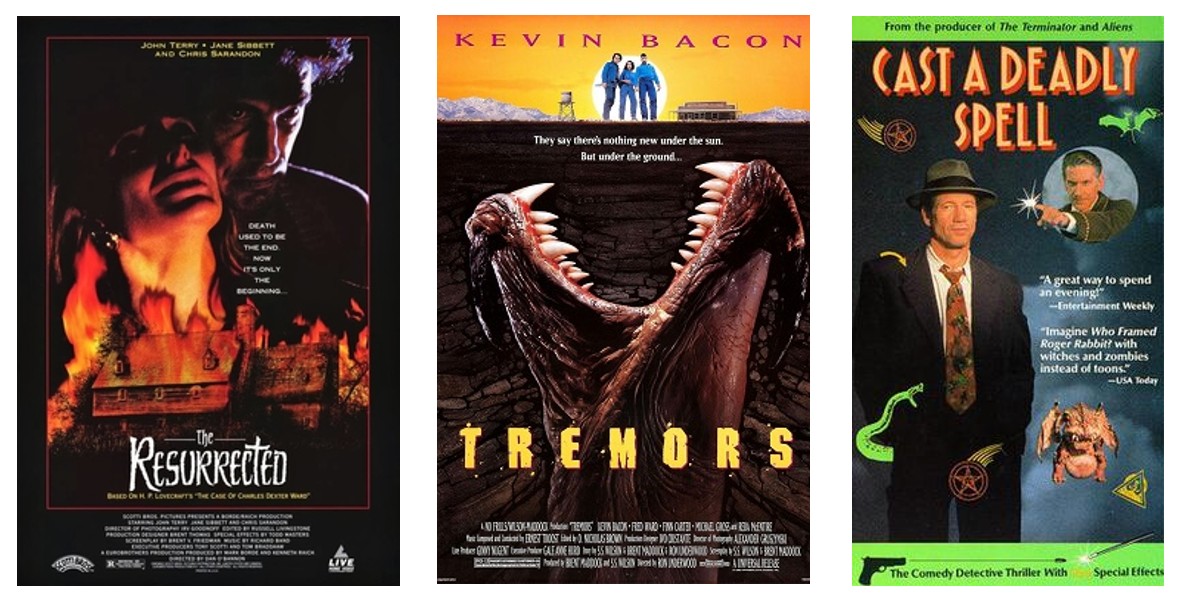 Another Holy Trinity!
Another Holy Trinity!
The Birthday falls into that kind of thing. A guy walks into the wrong damn place at the wrong damn time and things spiral out of hand. Way out of hand.
Feldman’s Norman Forrest is a decent guy, but he’s a schlub: nervous, nasal-y, and he’s trying his best to put on a brave face at his girlfriend’s father’s birthday party. These are not his people; they are wealthy (her father owns a string of hotels — including the venue for the party), his girlfriend has just gotten back from a trip to Europe — a long one it would appear.
Norman is trying to make his feelings for her known, but he’s constantly getting sidetracked. Last minute party issues, the fact some of his high school friends are having a corporate party on another floor, and then, well, there is something really weird going on in the background of the hotel. The wait staff, the cooks, something, several somethings, are going on.
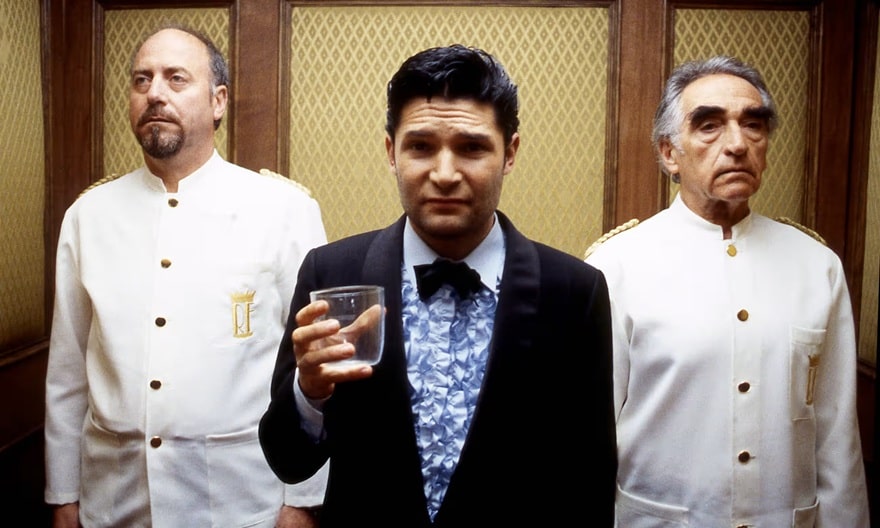 There’s something weird going on in the hotel
There’s something weird going on in the hotel
Cults? Secret Agencies? Murder in the sub-basement? A hero needs to step forth, and lord help us, the only guy who even matches that description is certainly not Norman Forrest. The hero that steps forth is Theodore, who claims to a secret agent, the point of the spear of a… well, a counter-cult maybe? But he can’t do much on his own and Lord help us, the only person he can rely on is Norman Forrest. But then, Theodore may be so crazy that in reality he’s the real threat.
Norman is a lot of things, but he’s not a fool. He’s open minded enough to ask questions, but not so open-minded that his brain’s gonna fall out, or that he’s going to let someone fill it with nonsense. But he’s in one of those situations where, by the time you get the proof you really need, it may well be too late.
 Erica Prior and Corey Feldman in The Birthday
Erica Prior and Corey Feldman in The Birthday
I only heard about the movie because one of my lefty-liberal websites had an interview with Feldman discussing it:
That is what that experience is with Norman. He has his high school buddy [Vince] around and he remembers being a kid and talking about girls in the locker room. There was a time when Norman wasn’t so neurotic. But maybe he also felt he wasn’t the best athlete and didn’t fit in because he didn’t like taking a shower with all the guys. I put him back in his school days whenever he interacted with his friend Vince. Juxtaposing that with this Indiana Jones character, Theodore, who may be a kook or savior. Is Theodore out of his mind and wandering in here with this fantasy, or is he really there because there is something going on, and this is Norman’s calling? Is Norman going to warn everyone there’s a crazy person running around the hotel, or is he going to believe this guy and take his gun and go on this adventure too? There is a whole side Norman develops that he didn’t know existed.
The movie is claustrophobic and at times muddy, but then if you’ve ever been stuck in a building with multiple parties and conflicting goals, you know that it can feel tight and muddled.
Check it out!
Adrian Simmons is an editor for Heroic Fantasy Quarterly, check out their Best-of Volume 4 Anthology, or support them on Patreon!
Tubi Dive, Part VI
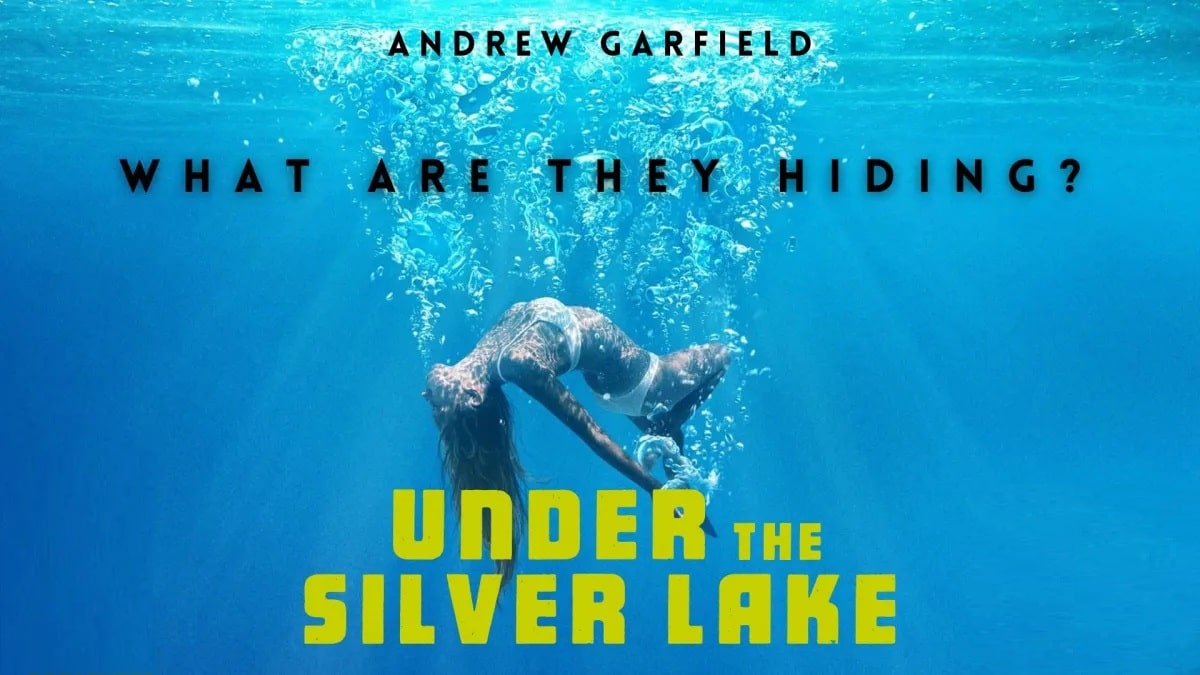 Under the Silver Lake (A24, April 19, 2019)
Under the Silver Lake (A24, April 19, 2019)
50 films that I dug up on Tubi.
Enjoy!
Under the Silver Lake (2018)Just in case you’re getting the wrong impression, Tubi isn’t all hidden schlock from around the world, there’s actually some proper* movies on there too.
Under the Silver Lake is the follow-up film from It Follows director David Robert Mitchell, and it seems the suits loved his horror film so much that they gave him free rein to do whatever he wanted to do.
What Mitchell wanted to do was make a two-hour, surreal, ‘slacker-noir’ type mystery film, with plenty of sex, violence, conspiracy theories and Andrew Garfield’s bottom.
I’m acutely aware that this is one of those films that sharply divides its audience. Some will bemoan the two hours they just lost on something they don’t understand, while others will wallow in its dreamlike narrative and unhinged tangents. I loved it.
Garfield plays a 30-something man who sits around doing nothing except smoke and watch his topless neighbour feed her parrots. When he falls for another neighbour his life is turned upside down, and leads him on a wild trail of hobo codes, murder, mysterious maps, secret codes, the truth behind pop culture, an urban legend, and a possible dog killer. Garfield is excellent as he drifts in and out of every scenario, looking increasingly worn down with each new revelation, and the supporting cast (mostly made up of attractive women there to feed his pervy addictions) are all great.
This was one of those films that drew me in and carried me along — I’ve seen comparisons to Mulholland Drive, but for me it felt like watching Mystery Train or Exotica for the first time.
Wonderful stuff.
10/10
*Proper to some. Everything I watch on there is proper.
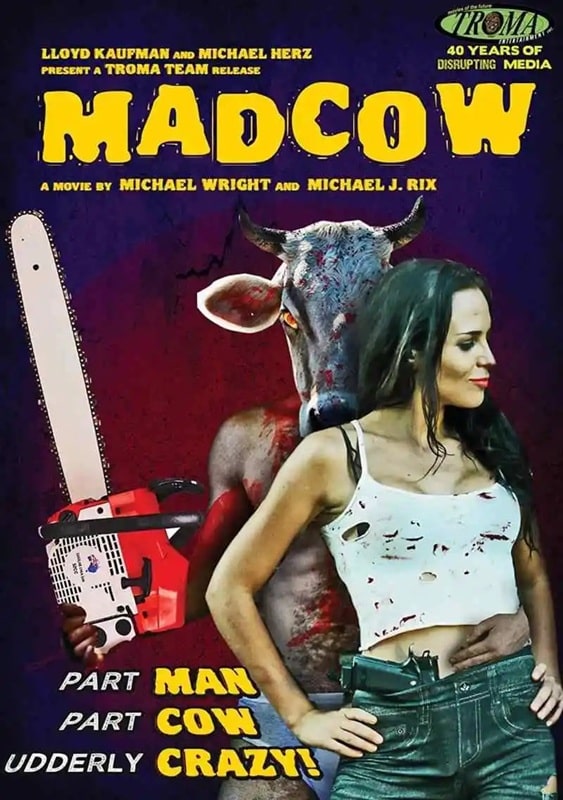
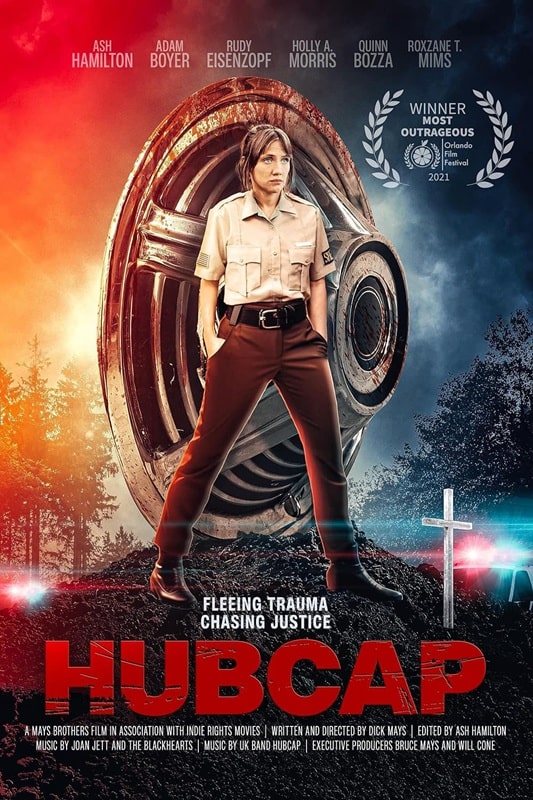
Mad Cow (Troma Entertainment, 2010) and Hubcap (Hubcap Film, 2021)
Watched a couple of sensible films recently, so I had to find a palate cleanser, and a Troma film usually does the trick.
Not strictly a Troma production (this was made by Funny How Films), Mad Cow was shot on a shoestring budget in 12 days (it shows), and is billed as more of a comedy than a horror film.
The story, for what it’s worth, concerns a scientist who transplants a cow’s head onto a human body. Said beastie then grabs a chainsaw and hilarity ensues. Actually, no it doesn’t. The deeply self-referential script is childish at best, deeply homophobic at worst, and I think I laughed twice at the Zucker Brothers-lite attempt at humor.
The funniest part might have been when I recognized most of the music as being stuff I had used myself for my student films, and when Kevin MacLeod’s name popped up in the end credits the film got a third titter out of me. So well done, I guess?
4/10
Hubcap (2021)Hoping for a spiritual successor to Quentin Dupieux’s Rubber (which I love), I settled down for this slice of road rage, and soon got, ahem, tired.
It’s a story of abusive relationships, PTSD, and political shenanigans, all tied together by a sentient hubcap possessed by the vengeful spirit of a war veteran.
What could have been highly silly, and somewhat enjoyable, becomes a bit of a slog from the midpoint once the main baddie has been dispatched and the hubcap stops its killing spree.
Oh well, plenty more fish* in the sea**.
4/10
* daft and gory films
** on Tubi
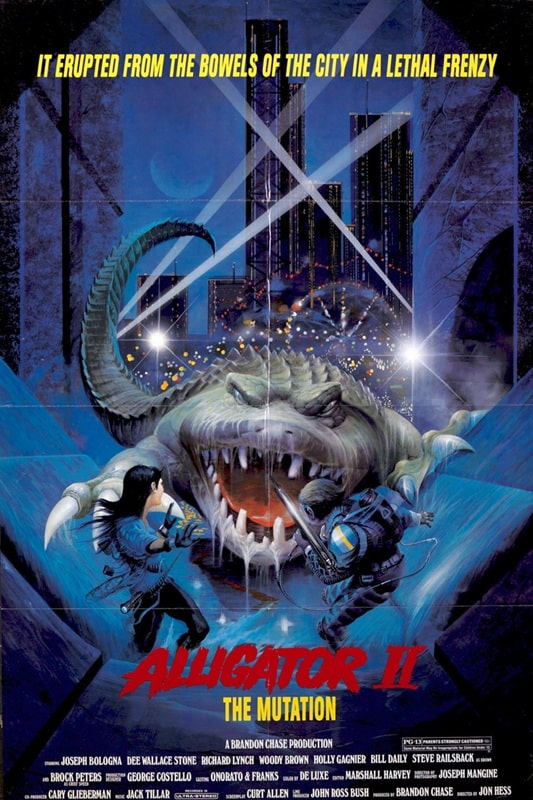

Alligator 2: The Mutation (New Line Cinema, June 5, 1991) and Vampire Clay (King Records, 2017)
Now then, I made a soft and slow rule that all the films I do these rubbish reviews for are first time watches, and yet I really think I’ve seen this one before. However, all I have is a sketchy memory of Richard Lynch in an underground alligator nest, so I can only assume that I caught a snippet one day on TV, or was very drunk at the time. Either way, here we are.
The first Alligator is awesome, but this one comes nowhere near to recapturing that magic. Instead we get another Jaws rehash with one-dimensional characters and dull kills. Joe Bologna is fine as the spiky detective who ain’t gonna follow the rules, but he’s no Robert Forster, and it’s fun to see Dee Wallace and Steve Railsback. The titular beastie is hardly a mutation though (just larger than normal).
They keep it light-hearted and there’s a couple of fun set pieces, but on the whole it’s a bit soggy.
5/10
Vampire Clay (2017)This is the feature-length debut of Sôichi Umezawa, who was responsible for the stop-motion insanity that was ‘Y’ in The ABCs of Death, so naturally I was quite excited.
The premise is great — a lump of clay is possessed by a disgruntled artist, which then goes on a blood-sucking spree when resurrected by an art student. The clay just needs moisture, any moisture, to reconstitute itself, and it dispatches art students and a hamster in a variety of slippery ways. Lurking in the background of this nuttiness is a commentary on modern art attitudes, a smattering of jealousy, and a dash of redemption, but we didn’t come here for drama and lectures. We came here for vampire clay.
Unfortunately, Umezawa is a way better short-form director, because this was unforgivably dull. The animatronic rubber and stop-mo effects were plentiful, but lit and shot so badly that they had no real impact, which was a pity. He does allow himself a gloopy animated sequence at the end (which really reminded me of a film I made about earwax a while ago), and the final clay creature is terrifyingly cute, but I was ultimately a little disappointed at what might have been. Oh well.
5/10
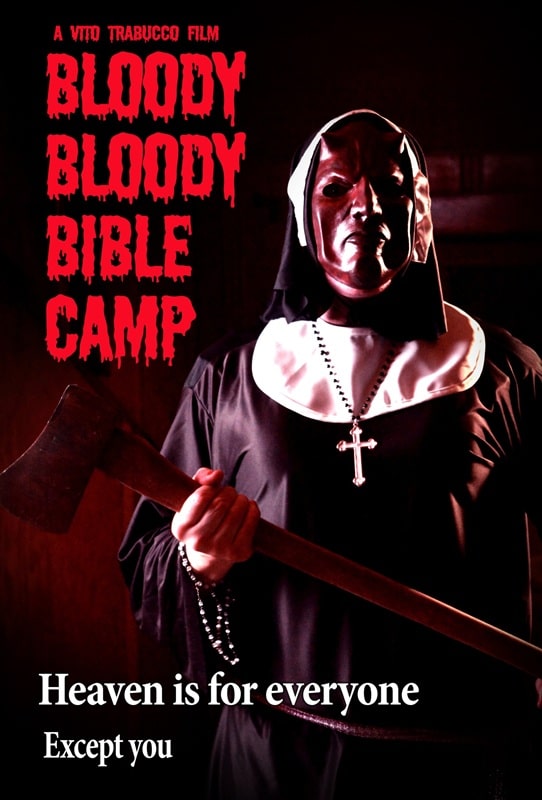
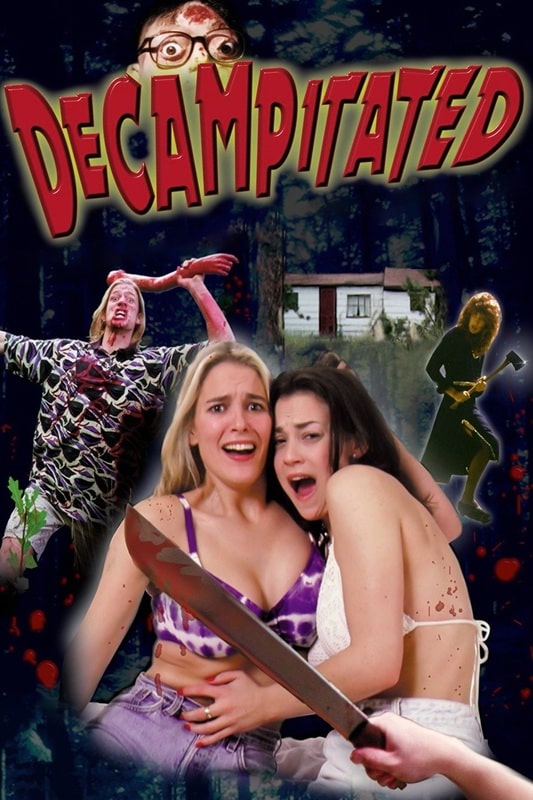
Bloody Bloody Bible Camp (Maltauro Entertainment, May 5, 2012) and
Decampitated (Troma Entertainment, 1998)
It’s 1977 (we know this because the characters are talking about Star Wars, Smokey and the Bandit, and the death of Elvis, all while sporting mustaches and/or short shorts), and the horniest bunch of Christians to ever walk God’s green earth are figuring out how to shag each other without upsetting the big man. Luckily, all this tediousness is put to a stop by a killer nun with a dagger crucifix.
Flash forward to 1984, and a new group of horny Christians are on their way to the same camp, led by ‘Father Cummings’, played by Phantasm‘s Reggie Bannister with some seriously dyed hair. As his name suggests, this isn’t as high-brow as you might expect (the mad nun’s name is Sister Chopper), and the filmmakers not only managed to adhere to the fodder-tropes for the characters, but also managed to make them hugely unlikeable.
There’s actually the germ of a decent slasher movie lost in here, but it is squandered in a maelstrom of unfunny dick jokes and a smorgasbord of hugely offensive moments, ranging from homophobic and transvestite ‘gags’, to anti-Semitism and sexual abuse. A shame really, as this has a fun (if a little hackneyed) premise. By the way, Ron Jeremy plays Jesus. JFC.
4/10
Decampitated (1998)Keeping with the campsite slasher theme, I decided to take a look at another Troma-backed effort, this one directed by Matt Cunningham. I thought I knew what I was in for after the excellent opening (but I was wrong).
The film starts with a woman fleeing for her life through the woods as she is pursued by a hunter wearing an apiary hood. She steps on a bear trap and saws her own foot off to hobble on her way. Then she steps on another trap and cuts the other foot off before dragging herself through the trees. Unfortunately, she puts her hand in a third trap and saws that off too. When her last limb is trapped, the hunter catches up to her and finishes her off. It’s absurd, mean and played for laughs, and I thought the tone would remain the same.
Sadly, the resulting film (unlikeable youths crash car, try to survive hunter) is so desperately unfunny, horribly shot (an over-reliance on fish-eye lenses) and horrendously over-acted in an effort to be ‘wacky’, that the whole thing soon becomes a chore. Plus, for the second film in a row, there is some major transvestite-bashing going on — what’s with these films? A smattering of fun, practical gore, but nothing to recommend.
4/10
Previous Murkey Movie surveys from Neil Baker include:
Tubi Dive, Part I
Tubi Dive, Part II
Tubi Dive, Part III
Tubi Dive, Part IV
Tubi Dive, Part V
What Possessed You?
Fan of the Cave Bear
There, Wolves
What a Croc
Prehistrionics
Jumping the Shark
Alien Overlords
Biggus Footus
I Like Big Bugs and I Cannot Lie
The Weird, Weird West
Warrior Women Watch-a-thon
Neil Baker’s last article for us was Part V of Tubi Dive. Neil spends his days watching dodgy movies, most of them terrible, in the hope that you might be inspired to watch them too. He is often asked why he doesn’t watch ‘proper’ films, and he honestly doesn’t have a good answer. He is an author, illustrator, teacher, and sculptor of turtle exhibits. (AprilMoonBooks.com).
Tor Doubles #6: Barry B. Longyear’s Enemy Mine and John Kessel’s Another Orphan
 Cover for Enemy Mine by Maren
Cover for Enemy Mine by MarenCover for Another Orphan by Tom Kidd
The sixth Tor Double not only includes the two title stories, Barry B. Longyear’s Enemy Mine and John Kessel’s Another Orphan, but also includes an excerpt from Gwyneth Jones’s novel Divine Endurance. Divine Endurance was originally published in Britain in 1984 and in the U.S. as a hardcover by Arbor House in 1987. Tor was scheduled to publish a paperback edition of the novel in May of 1989, two months after this Tor Double hit the shelves. With the two title stories totaling only 158 pages, the decision was made to add a twenty page excerpt of the forthcoming novel.
Enemy Mine was originally published in Isaac Asimov’s Science Fiction Magazine in September, 1979. It won the Hugo Award and the Nebula Award, as well as the Locus poll. Enemy Mine kicked off Longyear’s “Dracon” series and was the basis for the 1985 film Enemy Mine, starring Dennis Quaid and Louis Gossett, Jr.
The year after the initial publication and success of Enemy Mine, Longyear published an extended version of the story, which has generally superseded the version that won the Hugo and Nebula Award. It is this revised version that is included in this volume.
Enemy Mine is set during a war between humans and the lizard-like Drac, both of whom see the other race as trying to impinge on their own nascent interstellar hegemonies. It is clear from the beginning that there is little communication between the races and the war has been taking place for quite some time and there is no end in sight.
When the novella begins, a human, Willis Davidge, and a Drac, Jeriba Shigan, have crashed on the planet Fyrine IV while a battle rages on in orbit above them. Seeing each other as alien and enemies, they continue in their attempts to kill each other, until they realize that the inhospitable nature of the planet means they have to work together in order to survive.
Over the course of a year, Jeriba and Davidge begin to understand each other and learn each other’s language. Jeriba taught Davidge about the Talman, the closest thing the Drac have to a religious text, as well as about their culture. The Drac are hermaphroditic and when Jeriba explains that it is expecting, the teaching opens up to the ancestor respect the Drac have for their hereditary line.
Had Longyear ended the story with the two enemies coming to terms with each other, and it is clear that Jeriba is more open to the idea of learning about humans than Davidge is with learning about the Drac, Enemy Mine would have been a typical science fiction story. However, the fact that Jeriba is expecting adds a twist to the story that elevates it.
When Jeriba dies in childbirth, it is up to Davidge to raise its child, Zammis, and protect it from the elements. Davidge does this to the best of his abilities, creating a person who is a mix of human and Drac philosophies and who loves the dangerous world upon which it was raised, even as Davidge continues to only see the dangers of Fyrine IV.
Eventually, rescue comes and Davidge finds himself back on an Earth following an armistice with the Drac. Trying to find work and living with his parents, he suffers the sort of disorientation many former soldiers find and is not fully able to fit into his society. When he realizes that despite the truce with the Drac, humans are still as prejudiced against the Drac as they had been during the war, Dravidge decides to attempt to rectify that by translating the Talman into English, although his primary goal is to earn enough money to travel to the Drac homeworld to see Zammis.
While Dravidge’s time with Jeriba and Zammis had taught him about the Drac and the philosophy espoused by the Talman, it gave him a very specific view of the Drac, specifically Jeriba’s own interpretation of Drac culture and philosophy. Upon his arrival at Draco, he learns that their society is every bit as complex and narrow minded as human society. His initial meeting with Jeriba’s father, Gothig, does not go at all as he expects and he learns that the Drac authorities can not be trusted to do the right thing.
Desptie the moment of truce following Dravidge’s rescue, it becomes clear that it is a temporary thing in Longyear’s world. The racial tensions and prejudices of the humans and Drac may be overcome on an individual basis, but they cannot be address on a societal level unless a new society, built apart from mainstream humanity or Drac culture, is allowed to be built.
Although Enemy Mine offers a roadmap to break the cycle of hatred, it does so with an understanding that it can only be done by disregarding the majority of people who may not be able to put aside the slights and atrocities, real or perceived, committed in the past.
I previously discussed Enemy Mine on September 3, 2019 as part of the “Golden Age of Science Fiction” series.
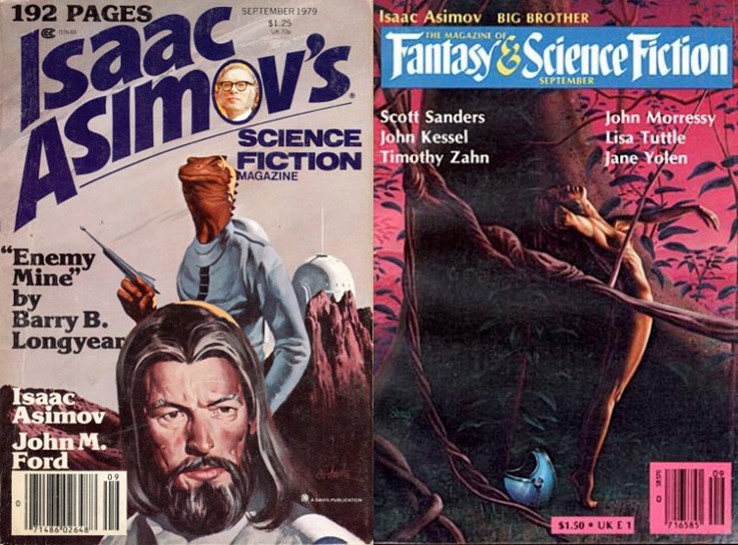 Isaac Asimov’s Science Fiction Magazine 9/79 cover by Vincent di Fate
Isaac Asimov’s Science Fiction Magazine 9/79 cover by Vincent di FateFantasy and Science Fiction 9/82 cover by Barclay Shaw
Another Orphan was originally published in F&SF in September, 1982. It was nominated for the Hugo Award and the Nebula Award, winning the latter.
Patrick Fallon has become unstuck in time, well, perhaps not, but there is a certain feel that he has given that he wakes up one morning and instead of finding himself working at the Chicago Mercantile Exchange he is on a sailing ship, with no memories of how he got there, but clear memories of his life in Chicago and his recent argument with his girlfriend, Carol.
However, Fallon belongs on the ship. The other sailors accept him and know his name. If they question his lack of knowledge of how do the he most basic tasks on the ship, they ignore their doubts, figuring he’ll work his way through it. And he does, with a small amount of help from shipmate Bulkington.
As he begins to figure out how to handle tasks, life on board the ships begins to gain a familiarity to Fallon, but not because he remembers life on the ship. Instead he begins to realize that he hasn’t slipped through time, but instead has slipped through realities, finding himself aboard the whaling ship Pequod, as described in Herman Melville’s Moby Dick.
Having read Moby Dick, Fallon knows that in the end the ship and its crew are doomed with the exception of Ishmael, who he can’t find among the crew. Although he entertains the idea that he may be fulfilling Ishmael’s role, Fallon decides he can’t rely on that hope for survival. After talking with Ahab and learning how much the captain is focused on killing his white whale, Fallon decides he needs to take matters into his own hands.
Fallon talks to other crewmen, including Starbuck, Stubbs, and Bulkington, trying to get them all to understand that Ahab’s focus threatens them all. While they may agree with Fallon, they also understand their place aboard the ship and can’t fathom the idea of mutiny, which is the only way to accomplish the action Fallon is calling for.
Even as he acclimatizes to life on board the Pequod, Fallon recalls his life in Chicago and yearns to return to the comfort and safety of life as a trader. His wife appears to be granted when he suddenly finds himself back in Chicago, preparing for a day of work, and finding that he is as lost there as he was when he first awoke on the Pequod. However, His two lives bleed into each other and Fallon realizes that whether he is in Chicago or the Pequod, the crew he has been living with are moving toward the inexorable climax of the novel which seemingly means Fallon’s death as well as the rest of the crew, with the exception of the enigmatic and undiscovered Ishmael.
Kessel appears to be having fun torturing his main character and the reader by showing them the parallels between the Pequod of Moby Dick and the Pequod of Another Orphan. Because the novel was written by Melville 130 years before Kessel’s story, the events of the story would seem to be set, but Kessel subverts that with the ideas, put forth by both Fallon and Ahab, that events can be fluid and are not predestined. While Fallon is hopeful that the destiny he sees can be averted, Ahab sees an outcome that involves the death of Moby Dick, but doesn’t necessarily mean the destruction of his ship or crew, and until that occurs, the results are undecided.
Fallon’s story is not neatly wrapped up. The final encounter with the whale is still in his future and Ahab is still his captain. Their future has not yet been written, but Kessel leaves them with a sense of dread that they won’t be able to avert the ending Melville has written for them and Fallon may never be able to turn his back on the Pequod and return to his life in Chicgao.
The cover for Another Orphan was painted by Tom Kidd. The cover for Enemy Mine was painted by Maren.
 Steven H Silver is a twenty-one-time Hugo Award nominee and was the publisher of the Hugo-nominated fanzine Argentus as well as the editor and publisher of ISFiC Press for eight years. He has also edited books for DAW, NESFA Press, and ZNB. His most recent anthology is Alternate Peace and his novel After Hastings was published in 2020. Steven has chaired the first Midwest Construction, Windycon three times, and the SFWA Nebula Conference numerous times. He was programming chair for Chicon 2000 and Vice Chair of Chicon 7.
Steven H Silver is a twenty-one-time Hugo Award nominee and was the publisher of the Hugo-nominated fanzine Argentus as well as the editor and publisher of ISFiC Press for eight years. He has also edited books for DAW, NESFA Press, and ZNB. His most recent anthology is Alternate Peace and his novel After Hastings was published in 2020. Steven has chaired the first Midwest Construction, Windycon three times, and the SFWA Nebula Conference numerous times. He was programming chair for Chicon 2000 and Vice Chair of Chicon 7.
Goth Chick News: Oh Deer – Bambi Goes Berserk in The Reckoning
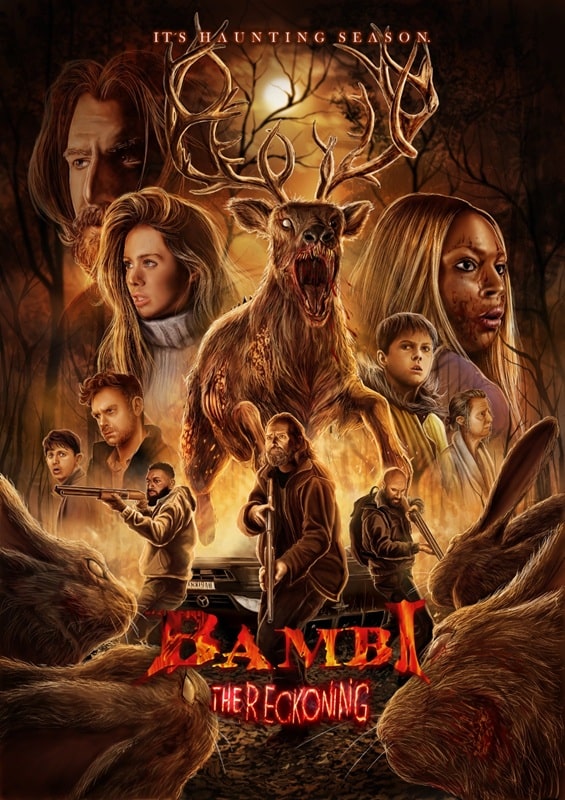 Bambi: The Reckoning (ITN Studio, July 25, 2025)
Bambi: The Reckoning (ITN Studio, July 25, 2025)
File this one in the “Why the F?” folder.
Bambi: The Reckoning is a British indie horror flick directed by Dan Allen and written by Rhys Warrington. It marks the fourth disturbing entry in The Twisted Childhood Universe (TCU), which brought us Winnie-the-Pooh: Blood and Honey and is now turning Felix Salten’s beloved deer into a forest-dwelling force of vengeance.
The Brits must really hate us.
Starring Roxanne McKee, Tom Mulheron, Nicola Wright, Samira Mighty, Alex Cooke, and Russell Geoffrey Banks, The Reckoning twists the tale of Bambi into a blood-soaked revenge story. The premise? A grieving, mutated Bambi — yes, you read that right — goes on a rampage after his mother’s untimely demise, targeting a hapless mother and son caught in his antlered crosshairs.
Though I’m not suggesting you do it, here’s the trailer if you want a look.
The project was first teased back in November 2022, when Bambi: The Reckoning was announced as the latest horror romp to traumatize a generation raised on wholesome animated classics. Helmed by Jagged Edge Productions, the film takes inspiration from the eerie creature design in Netflix’s The Ritual, because apparently, we all needed Bambi to double as nightmare fuel. Producer Scott Jeffrey described the flick as “an incredibly dark retelling” of Salten’s 1928 book, with our once-gentle deer transformed into a “vicious killing machine that lurks in the wilderness.”
Production kicked off in London on January 6, 2024, and filming wrapped just twenty days later — let me show you my shocked face.
Bambi: The Reckoning is set to hit U.S. theaters on July 25, 2025, so mark your calendars and prepare to binge-watch the Disney Channel that day instead.
Writ in Water: V.E. Schwab’s The Invisible Life of Addie LaRue
How many times have you heard (or even repeated) the old adage, “Be careful what you wish for?” Of course it’s a cliché, a commonplace beloved of parents and primary school teachers the world over, but such chestnuts sometimes actually contain the distilled wisdom of the human race, and you ignore them at your peril, as is demonstrated (or not, maybe) in Victoria Elizabeth Schwab’s 2020 dark fantasy, The Invisible Life of Addie LaRue. It’s a spirited, stimulating read that gives you something to think about.
The story begins in a small French Village, Villon-sur-Sarthe, on a summer evening in 1714. A young woman named Addie LaRue is “running for her life.” Her family has affianced her to an inoffensive but crushingly dull young man. Addie, however, doesn’t want her life to be yet one more colorless copy of the bland existence that her mother (and her mother before her, and her mother before her, and her mother before her…) has led.
Addie has occasionally gone with her carpenter father (who she is closer to than she is to her unsympathetic mother) on business trips to a neighboring town, and these all-too-rare glimpses of the world outside have sparked something in the young woman. She wants to see Paris, she wants to see the world, she wants to go where she will and love who she will. Looking around the well-known, changeless streets of her home, they look more and more like the bars of a prison; she knows that’s not what she wants. She knows she wants more.
Addie’s dreams and ambitions have been (somewhat equivocally) encouraged by an old woman of the village, Estelle Magritte, who is considered by some to be a witch. Estelle talks to Addie about the ancient, elemental, unpredictable gods of the fields and the forest, but she gives the girl one piece of very serious advice:
The old gods may be great, but they are neither kind nor merciful. They are fickle, unsteady as moonlight on water, or shadows in a storm. If you insist on calling them, take heed: be careful what you ask for, be willing to pay the price. And no matter how desperate or dire, never pray to the gods that answer after dark.
It’s counsel that Addie might have been better off heeding.
Fleeing her wedding, Addie plunges into the woods; as she goes deeper into them, the voices of her pursuing family grow fainter and fainter until they disappear. Addie falls to the ground, exhausted, and desperately begins to pray to the only source of help that she can think of, the old gods that Estelle has told her about, but more time has passed than she thinks; she doesn’t realize that the sun has set and that she is calling into the darkness.
Her plea is answered by one of the capricious, compassionless gods that Estelle warned her against, and though he may be inhuman, he at least has an ironic sense of humor, as he comes in the form of the fantasy lover that the lonely Addie “has conjured up a thousand times, in pencil and charcoal and dream.”
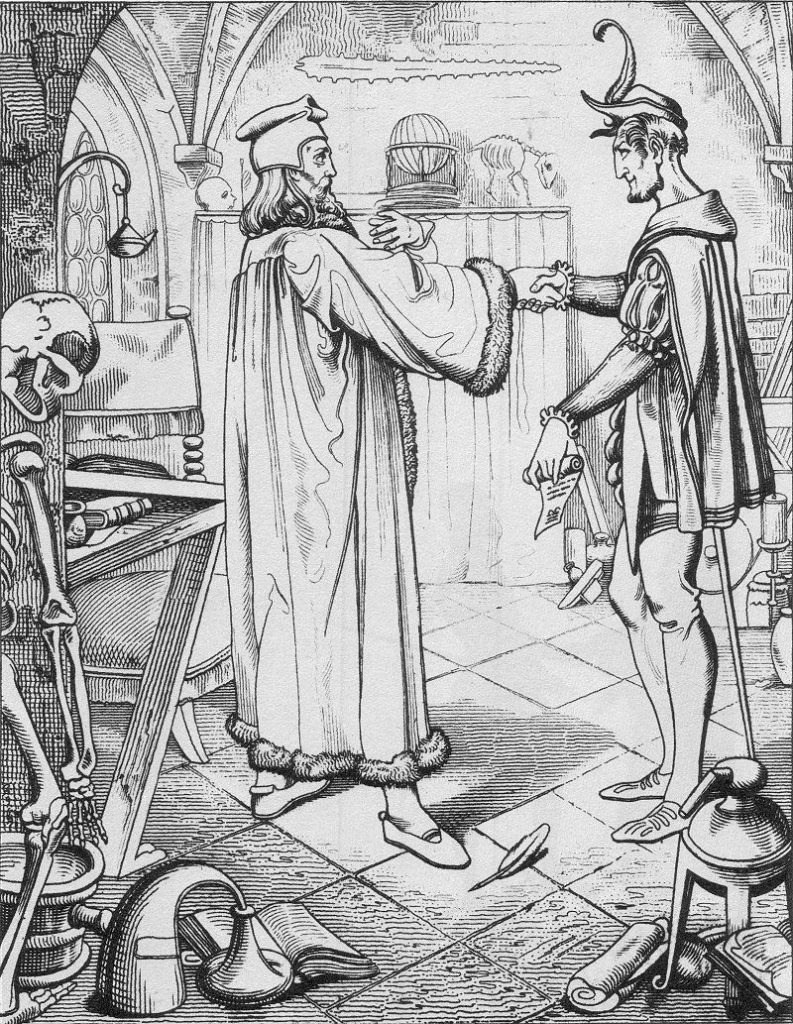 Congratulations — you are now the proud owner of a Ford Fiesta! All it will cost you is your soul!
Congratulations — you are now the proud owner of a Ford Fiesta! All it will cost you is your soul!
After the being asks if she is prepared to pay the price for his services, Addie makes the fatal promise, “I will pay anything.” The entity, be it god, devil, or something so entirely other that it cannot fit into either of those common categories, asks her why she is willing to do this. The girl replies with what amounts to her manifesto:
“I do not want to belong to someone else,” she says with sudden vehemence. The words are a door flung wide, and now the rest pour out of her. “I do not want to belong to anyone but myself. I want to be free. Free to live, and to find my own way, to love, or to be alone, but at least it is my choice, and I am so tired of not having choices, so scared of the years rushing past beneath my feet. I do not want to die as I’ve lived, which is no life at all. I –”
The being (which she will soon name Luc) cuts her short. He’s not interested in what she doesn’t want. Can she tell him what it is that that she does desire? That’s easy; Addie wants more time. Luc puts the wish into words for her — “You ask for time without limit. You want freedom without rule. You want to be untethered. You want to live exactly as you please.”
“Yes,” Addie says… but Luc declines the deal. After all, what’s in it for him? He gives her life unending, and he gets nothing? It’s hardly fair. And in that moment, Addie hears again the voices of her family and the other villagers, searching for her, growing louder, coming closer. And in that last moment, she recklessly stakes everything. “You want an ending,” she says. “Then take my life when I am done with it. You can have my soul when I don’t want it anymore.”
Deal.
The rest of the book shows us what kind of life Addie has purchased, and it does so with a forward/backward structure that alternates chapters showing that life in the eighteenth, nineteenth, and twentieth centuries (she spends most of the early eighteenth-century chapters discovering exactly what sort of covenant she has entered into), and chapters set in New York City in 2014.
What is the nature of the bargain Addie has made? (Of course, Luc’s deal comes with small print — there’s always small print.) As is common in such transactions, it soon becomes clear that Luc has given her exactly what she asked for. She wanted complete freedom, a radically unfettered life; she wanted no obligations to anyone, and her “benefactor” has found the perfect way to grant her wish.
Addie is free to go where she will, free to do what she wants, free to spend her time in the company of whomever she pleases, and people are drawn to the beautiful, bewitching young woman with the constellation-like pattern of seven freckles on her face. They love her when they’re with her. But when she leaves the room for more than a few minutes, or when they do, or when they fall asleep…
They completely forget her; she vanishes from their minds and memories as thoroughly as if she had never existed. In an especially painful twist, people are unable to even speak her real name.
As the years pass and Addie travels far and wide, she leaves her narrowly circumscribed life in her stultifying little village far behind, and she indeed sees the world — but the cruel nature of her bargain makes it impossible for the world to see her. She finds herself living a rootless, utterly transitory existence which is, in the words of John Keats’ pathetic epitaph, “writ in water.”
Through all these restless centuries, Addie lives by theft (which bothers her, but what else can she do), finds temporarily vacant houses or apartments to stay in for a day or a week, and establishes relationships as transitory as the lives of mayflies. For the first few decades, Luc appears every year to see if Addie is ready to surrender her soul. She always refuses, even as she finds herself looking forward to these visits — who else can she have a real conversation with? Luc’s visits eventually become much more sporadic (despite the hints of a growing and ambiguous attraction between the two, especially on Luc’s part; perhaps it is not good for even a god to be alone). Neither the human nor the inhuman are in a hurry; after all, they both have nothing but time.
Even in the midst of her exile, Addie takes heart from knowing that she has managed to leave some subterranean traces in the world after all, in the works of artists she has briefly known. Luc has been unable to prevent a ghostly record of Addie from appearing in a painting here, or in a song there. This helps her to hang on despite her unassuageable weariness. (That, and she’s just damned stubborn.)
The story makes a major shift in the second half of the book, when, in present-day New York, Addie meets a young man named Henry who works in a used bookstore. He is the one Addie has been waiting hundreds of years for; miraculously, he can remember her. (Addie discovers this when she tries to steal a book.)
Addie and Henry quickly fall in love, or at least, Addie sees that as a real possibility. (For her, he’s the only game in town.) But why is he different? Why can he remember her? The answer turns out to be simple — he, too, has made a deal, and is therefore living outside the boundaries of normal human existence.
Henry’s dilemma was the opposite of Addie’s — the youngest son of a prosperous, successful family, he always felt overlooked, ignored, invisible. No one ever saw him for who he really was. When he proposes to a young woman he has fallen in love with, she turns him down, making it clear that he’s nice and all that, but ultimately he’s not all that important to her. Shattered, Henry decides to commit suicide, but before he can complete the act, Luc appears with an offer: instead of being a person people see through, Henry will become a man no one can miss. Whenever anyone looks at him, they will see whatever they most desire. To everyone he meets, he will be the most important person in the world.
You see the problem, don’t you? Henry, of course, doesn’t, and he accepts the deal.
Now when people look at him, speak to him, have sex with him with glaze-eyed delight, they’re not really seeing him at all; they’re seeing an embodied fantasy that has nothing at all to do with the actual Henry Strauss, and the young man ultimately finds himself more even isolated and desolate than he was before.
This why Henry can remember the ephemeral Addie and why Addie can see the actual Henry — the bargains that they struck perfectly complement each other; their hells dovetail seamlessly.
One difference, though, is that Henry didn’t drive a very hard bargain; his contract isn’t open-ended, and when he meets Addie, the bill is about to come due. Henry has just over a month to live.
A few days before Henry is to die, Luc appears to Addie for the first time in thirty years. Does he know that he finally has her where he wants her? Maybe so, because Addie then finds out the terms of Henry’s contract, and having at last found someone she can willingly sacrifice herself for, she proposes a new bargain: she asks Luc to give Henry (who is “the one piece of her story that she can save”) his life back.
If Luc does this for her, Addie tells him, “I will be yours, as long as you want me by your side.”
Done.
The story ends two years later with Addie browsing in a London bookstore. She hears a customer ask for a copy of a hot new novel that’s making quite a stir. Written by an anonymous author, it is titled The Invisible Life of Addie LaRue.
Finding a copy herself, Addie tremblingly looks at the dedication page; it bears just three words: I Remember You.
Addie knows then that she has won her gamble, and when Luc appears and they walk out of the bookstore together, she thinks that the god who seemingly brought her to bay has been too clever by half. She has an unlimited amount of time in front of her, all the time in the world, time enough to work on Luc as he worked on her, time to “ruin him,” to “break his heart,” to “drive him mad, drive him away.” All the time there is, to make him willingly “cast her off.”
Then, and only then, Addie LaRue will have what she desperately desired so long ago. Finally, she will be free.
The Invisible Life of Addie LaRue is an engaging and highly imaginative book, but I do have a couple of quibbles. Addie’s discontent and (especially) the way she thinks about it and acts on it seem more like that of someone born at the end of the twentieth century than of someone born at the end of the seventeenth. Truly entering into the thought-world of a person of such a radically different era is a difficult task (perhaps especially so in our highly “presentist” age) and I can’t say that Schwab has entirely pulled it off. (I also think that kind of portrait wasn’t something she was really aiming at.)
Also, I was less than enthralled with the second half of the book’s “current-day” sections, which largely became one long episode of Young Brooklyn Romance, which, if it isn’t a hit new Netflix series, probably soon will be. In any case, it’s not the sort of thing that winds up at the top of my watch list. With the entrance of Henry, the book moves from things I’m more interested in (explorations of what freedom is and what it’s for, and of the relationship between community and identity — to what extent do we even exist except in relation to other people?) to something I’m less interested in (urban love among the achingly trendy). I say this understanding that I’m not a part of the target demographic of either the novel or the hypothetical show — and by the way, if anyone uses my title, they had better pay me.
Those complaints aside, the story Schwab tells is consistently engaging and entertaining, and at times even thought-provoking. The Invisible Life of Addie LaRue gains much of its power from being a lively new variant on a very old tale and by maintaining its connection with countless myths and stories that have gone before; the novel contains echoes of Faust, The Picture of Dorian Gray, The Wandering Jew, The Flying Dutchman, The Devil and Daniel Webster, and Peter Pan, to name just a few, and Addie can stand unembarrassed in their august company.
Two more recent stories that Addie LaRue also reminded me of are Lolly Willowes, Sylvia Townsend Warner’s 1926 novel of a woman who becomes a witch and sells her soul to the Devil in order to do exactly what Addie wanted — live her own life. Warner was a major writer in many different modes and Lolly Willowes is a masterpiece of double-edged irony, but even though Schwab’s book operates on a less profound level than Warner’s, it’s still not a stretch to speak of them both in the same breath.
Also, Luc strikes me as being at least a cousin of that malevolent aristocrat of Faerie, the Gentleman with the Thistle-Down Hair of Susanna Clarke’s wonderful Jonathan Strange and Mr. Norrell, though the Gentleman is frightening in ways that Luc can’t begin to match. (No person in their right mind would contemplate for an instant having a relationship, romantic or otherwise, with the Gentleman.)
Reading The Invisible Life of Addie LaRue and thinking about the questions it raises brought to mind something that Carl Jung, the founder of analytical psychology, once wrote:
People do not realize just how much they are putting at risk when they don’t accept what life presents them with, the questions and tasks that life sets them. When they resolve to spare themselves the pain and suffering, they owe a debt to their nature. In so doing, they refuse to pay life’s dues and for this very reason, life then often leads them astray. If we don’t accept our own destiny, a different kind of suffering takes its place… One cannot do more than live what one really is. And we are all made up of opposites and conflicting tendencies. After much reflection, I have come to the conclusion that it is better to live what one really is and accept the difficulties that arise as a result — because avoidance is much worse.
Addie challenges the status quo and pushes the boundaries of freedom and in doing so, she gets more than she bargained for… or does she? In making her initial deal, is she avoiding her destiny or accepting it? It’s possible to come down on either side of the question. It wouldn’t surprise me if one of these days, Schwab writes a sequel that gives us a more definitive answer.
I’ll definitely be there for it… but the world is wide and there’s no limit to places you can set a book, so can we stay out of Brooklyn? Please? I’d give almost anything…
 Abandon all hope, ye who enter here
Abandon all hope, ye who enter here
Thomas Parker is a native Southern Californian and a lifelong science fiction, fantasy, and mystery fan. When not corrupting the next generation as a fourth grade teacher, he collects Roger Corman movies, Silver Age comic books, Ace doubles, and despairing looks from his wife. His last article for us was Life Lessons from David Cronenberg
Houses of Ill Repute: Witchcraft for Wayward Girls by Grady Hendrix and Starling House by Alix E. Harrow
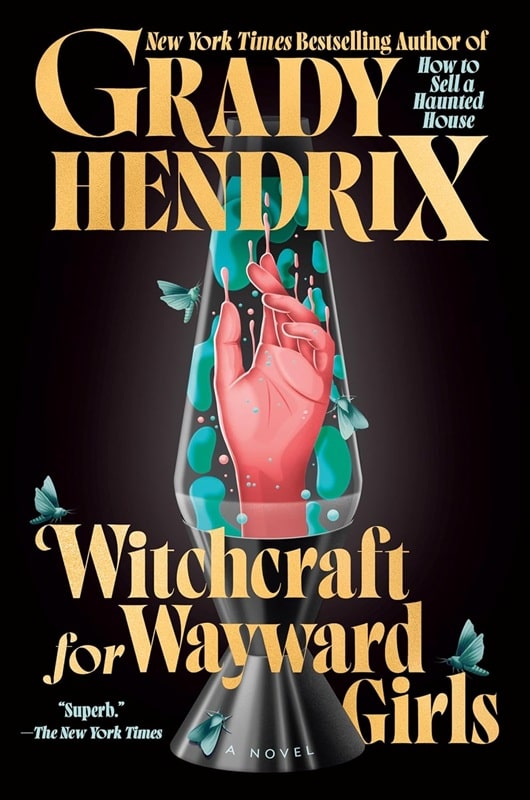
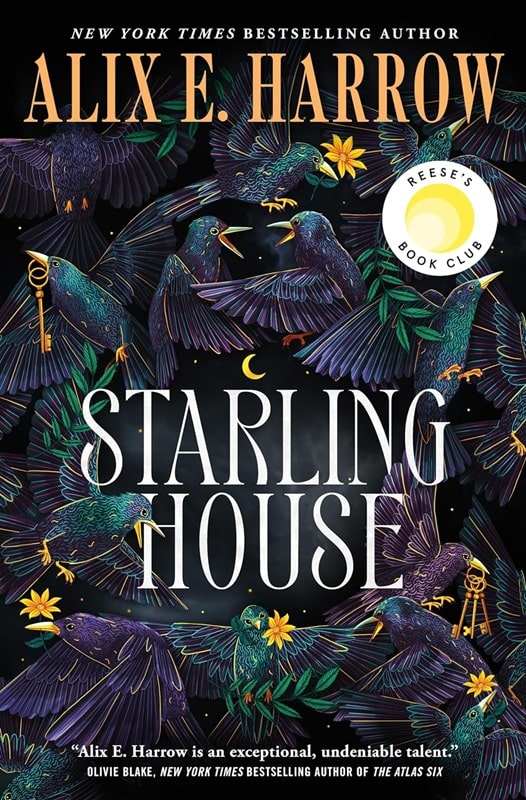
Witchcraft for Wayward Girls by Grady Hendrix (Berkley, January 14, 2025) and
Starling House by Alix E. Harrow (Tor Books, October 3, 2023). Covers: uncredited, Micaela Alcaino
No, not that kind of house of ill repute (though I confess I thought the semi-salacious implication of the headline might get some of you to read a bit further, though of course not you who are reading this now, just all those others). Rather the gothic trope of the creepy house, the mansion where ancestral secrets lie, where bad things happen. From The House of Seven Gables to The Fall of the House of Usher to Wuthering Heights to more contemporary (all the more so because they actually existed) houses of horror such as Colson Whitehead’s Nickel Academy and Tananarive Due’s Dozier School of Boys, these are places that present a facade of safety, but are far from it.
That’s the kind of house found in Grady Hendrix’s Witchcraft for Wayward Girls. Don’t be put off by the middle school YA sounding title. Homes for “wayward girls” actually existed in mid-20th century Florida. It was where unmarried pregnant teenagers were sent to have their babies, give them up for adoption, and then return to “normal” life with their and their family’s “reputations” intact.
The adolescent pregnant girls, literally abandoned by her parents for committing a sexual and “moral” offense (to my knowledge, there were no homes for boys who fathered out-of-wedlock babies and put the mothers in this position) became subject to “we know what’s best for you” treatment and holier-than-thou attitudes. In all too many cases, preserving the girl’s good name and future marriageability provided cover for the lucrative practice of selling newborns to adoptive parents on top of charging parents for room and board and, above all, discretion.
As Hendrix points out in an afterword,
Most homes confined their girls to the property… [some] forbade the use of makeup, censored the girls’ mail, charged them extra for dessert, and refused to allow them any communication with the outside world…Girls who changed their minds about adoption and tried to keep their babies would be subject to a tactic a tactic informally known as “The Bill.” At the last minute, a caseworker or staff member would inform the girl that her accumulated charges had to be paid before she could go home with their child. The Bill was usually so high that a girl had no hope of paying and so, whether she wanted to or not, she had to allow her baby to be put up for adoption.
This kind of house already earns its horrific bona fides without need of supernatural intervention (indeed, Hendrix says the first two drafts didn’t contain any fantastical elements). Adding witchcraft, however, layers a metaphor for women’s empowerment, albeit one that carries a price, that is closely associated in folklore with childbirth. As Hendrix notes,
There’s a popular [though discredited] myth that the Catholic Church targeted midwives as witches… In fairy tales, witches are constantly eating or stealing babies. In the fevered popular imagination, witches crown their black sabbaths with a child sacrifice.
The story centers on Fern (all the girls are given an arbitrary plant-based pseudonym during their stays, ostensibly to preserve privacy, but actually to depersonalize them), a 15 year old in effect kidnapped by her father to endure her pregnancy at the Wellwood House in St. Augustine, Florida in the summer of 1970. Her situation is not, needless to say, a happy one.
No one would write, no one would call, no one outside this house even knew where she was, except her dad, and he hated her. She never felt more alone. She would do whatever they wanted her to say, eat whatever they told he to ear, just so long as they let her of back to the way thing were before.
The smart-assed (if ultimately superficial) hippie-styled resistance of a fellow wayward girl provides some hope of eventual escape from the home’s adult “benefactors.” But it is a bookmobile librarian who hands Fern a tome entitled How to be a Groovy Witch that leads to the invocation of witchcraft to avenge mistreatment.
Unfortunately, to paraphrase Peter Parker, with great power comes unexpected consequences and questions of responsibility. And just as it’s one thing to proclaim hippie slogans and quite another to actually adhere to them in the real world, practicing witchcraft also comes with significant moral compromises. Which Fern must balance against the familial and social stigma of unwed pregnancy, of being forced to give birth and then relinquish her child. As once of the wayward girls now an adult and long after giving up her baby puts it:
There’s a part of me that’ll always be seventeen. A part of me that’ll be seventeen forever, locked away in that Home, cut off from the world.
That’s a house you can run away from, but never escape.
Locked away and cut off from the world is also the predicament in Alix E. Harrow’s The Starling House. Instead of the proverbial madwoman in the attic, it’s a male recluse in the titular creepy home containing disturbing secrets. Another kind of forced habitation is the stifling town, the ironically named Eden, Kentucky, modeled somewhat after the equally ironically named and actual Paradise, Kentucky immortalized in the John Prine song about a family-owned coal company that exploits the land and resident workers. It’s a place Kentucky native Harrow knows as “a place of very mixed experiences that I love very, very, very much, and which has just an incredible violence and terror to it.”
Our heroine, Opal, is a social malcontent and for the most part first-person narrator (there are also point of view shifts and even footnotes and a bibliography!), a high school dropout working a dead-end job in a dead end town. Orphaned following her mother’s death in a car crash, she is trying to save up money to send younger brother Jasper to a private school and get a better life out of Eden. But kind of hard to do on a Tractor Supply cashier’s salary and some petty larceny.
Walking to work, Opal finds herself strangely (of course) drawn to the ancestral home of the Starling family, one of whom wrote a dark fantasy for children called The Underland (the book’s illustrations appear throughout) and disappeared under, of course, mysterious circumstances. Part of the house’s appeal to Opal is how the shapes on the front gate remind her of the creatures depicted in The Underland.
The gates of Starling House don’t look like much from a distance — just a dense tangle of metal half-eaten by rust and ivy, held shut by a padlock so large it almost feels rude — but up close you can make out individual shapes: clawed feet and legs with too many joints, scaled backs and mouths full of teeth, heads with empty holes for eyes.
Opal feels compelled to look inside the old neglected house, managing to convince the current Warden, Arthur Starling, despite his initial misgivings, to hire her as a housekeeper. Opal soon discovers a special strange connection to the equally strange house. And to Arthur.
Sinister forces soon intercede, however. The aptly named Gravely Power company wants to acquire the Starling House property by means fair or foul. And then there are supernatural entities literally right out of The Underling. All of which jeopardize Opal’s already problematic relationship with Arthur.
The Starling House has rooms for just about everything — Southern gothic horror, classic fairy tale, corporate evil, environmental and class issues, a love story even (it’s not coincidental that Harrow makes a point of mentioning in the Acknowledgement that her mother “read every version of Beauty and the Beast with me”), all wrapped together in a single, ahem, attractive property. It’ll particularly resonate with anyone who grew up in a small town or boring subdivision who tried to run away from the horror of humdrum existence.
David Soyka is one of the founding bloggers at Black Gate. He’s written over 200 articles for us since 2008. His most recent was a review of The Bright Sword by Lev Grossman.
A (Black) Gat in the Hand: Weird Tales Rings in Conan
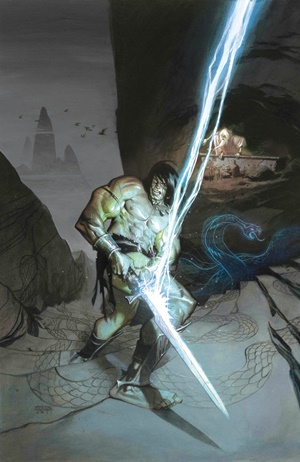 “You’re the second guy I’ve met within hours who seems to think a gat in the hand means a world by the tail.” – Phillip Marlowe in Raymond Chandler’s The Big Sleep
“You’re the second guy I’ve met within hours who seems to think a gat in the hand means a world by the tail.” – Phillip Marlowe in Raymond Chandler’s The Big Sleep
(Gat — Prohibition Era term for a gun. Shortened version of Gatling Gun)
Back in 2018, I started A (Black) Gat in the Hand because I wanted to share my love of hardboiled Pulp. I’ve had some friends join in, and they’ve added some non-hardboiled Pulp, while I’ve expanded my coverage. I’m currently working on my third Kirby O’Donnell essay, and my first on Harold Lamb, which takes us to the Adventure Pulps. And I’m starting another Robert E. Howard Weird Menace post, looking at his occult investigators, Conrad and Kirowan.
One of those stories has a direct link to Conan! A key part of that one is The Ring of Thoth Amon. And if you like the mighty-thewed Cimmerian, you know that ring is integral to the very first Conan tale, “The Phoenix on the Sword.”
Two years before I kicked off my Pulp series under the first title of With A (Black) Gat, I wrote one of the very first essays for Hither Came Conan. Six years ago now, I ruminated on “The Phoenix on the Sword.” I like that story quite a bit. So, we’re bringing that post back for the Summer Pulp series, while I work on the second life of The Ring of Thoth Amon.
I’m pretty sure “Phoenix” was the first Conan story I read. Now, it might have been “The Thing in the Crypt,” in the first Lancer/Ace collection, which I had bought and then stuck on a shelf for at least a decade or two. But I didn’t remember that story when I started going through the Ace books, AFTER exploring Conan via the Del Rey trilogy. So, I think it was “Phoenix.”
The Phoenix on the Sword
It is well known that “The Phoenix on the Sword,” the first story of Conan the Cimmerian, was a rewrite of a previously unsold tale of an earlier Howard character, Kull, an exile from Atlantis.
Howard sold three Kull stories to Weird Tales, appearing in the August and September issues of 1929, and finally, in November of 1930. Howard also wrote nine more tales about the character, which were not published until after his death. So, only 25% of his Kull stories sold. Not exactly a money-maker.
However, “By This Axe I Rule!”, which had failed to sell to Argosy and Adventure, was dusted off to feature a less-philosophical barbarian.
I struggled through the Kull Canon. I definitely prefer Conan, Solomon Kane, and El Borak. The Kull stories seem, to me, to be overly philosophical and full of metaphysical meanderings. “The Mirrors of Tuzun Thune,” which actually appeared in Weird Tales, is one of my least favorite of Howard’s published work. Kull stares in mirrors all day, waxing thoughtful. It’s mind-numbingly dull.
SPOILER ALERT – You absolutely should already have read the original REH story, before reading this essay. Reading on before reading Howard’s “The Phoenix on the Sword” makes no sense at all. You’re definitely gonna ruin the story. END OF SPOILER ALERT.
The heart of “Axe!” and “Phoenix” is the same. A barbarian has taken the kingship of a civilized nation by the sword. He is hailed as a liberator at first, but his status as an outsider and a savage undermines his rule. A coalition of malcontents, led by one Ascalante, plots to assassinate him in his rooms at night: both stories include a banished former noble now outlaw; a useless noble with a faint trace of royal blood in his veins; a dwarf noble with waning influence and declining wealth; an ambitious military commander; and a fool-headed minstrel. That part of the story is all but the same, even to a bribed officer of the guard leading away the royal bodyguard and disappearing forever (smart guy).
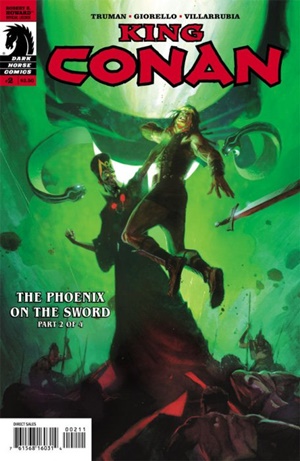 The fight, when the conspirators, with 16 nameless rogues to help, invade the royal bedchamber, is pretty much the same in both stories. Well, to a point…
The fight, when the conspirators, with 16 nameless rogues to help, invade the royal bedchamber, is pretty much the same in both stories. Well, to a point…
Where the “Phoenix” varies is that, in replacing Kull with Conan, Howard makes it a sword and sorcery story. The subplot in “By This Axe I Rule!” involves a young noble, Seno val Dor, who wants to marry Ala, a slave girl. However, such a union is forbidden by Valusian law. And law is inviolate. Even the king is helpless to change it. Seno and Ala cannot wed.
Kull fights off the almost two-dozen invaders, until only Ascalante remains. The rebel has the advantage, until Seno arrives and slays the would-be assassin with a thrown dagger. Ala had overheard the plot and gone to her beloved, who gathered up his men and rushed to the king’s aid.
Kull, wounded and weak, orders the tablet regarding the law of slaves to be brought to him. Once that’s done, he lets his thoughts be known:
“Hear you! I am weary of this business! I am no king but a slave! I am hemmed in by laws, laws, laws! I cannot punish malefactors nor reward my friends because of law – custom – tradition! By Valka, I will be king in fact as well as name!”
He declares that Seno and Ala saved his life, and they may marry. This does not go over well with the traditionalists, as you can well imagine. The king is… unperturbed.
‘”I am the law!” roared Kull, swinging up his axe; it flashed downward and the stone tablet flew into a hundred pieces. The people clenched their hands in horror, waiting dumbly for the sky to fall.’
Thinking outside the box was not exactly encouraged in Valusia.
The speech continues as Kull drives his point home, tossing aside the royal scepter and brandishing the bloody axe. At the end of the story, it’s clear he will rule, enforcing those laws he declares just and discarding those he does not. It certainly seems like the blueprint for an unchallenged despot.
It’s actually a decent enough read and not a bad story.
But for “The Phoenix on the Sword,” Howard completely tosses out the noble-slave love story and the discourse on the suffocating effects of unalterable law. Instead, he brings in the fantastic, making it a sword and sorcery tale.
Now, Conan does wax eloquent on the duties of kingship, just as Kull did. This:
“The trouble with me, Brule – I did not dream far enough. I always visualized merely seizing the throne -I did not look beyond. When King Borna lay dead beneath my feet, and I tore the crown from his gory head, I had reached the ultimate border of my dreams. From there, it has been a maze of illusions and mistakes. I prepared myself to seize the throne – not to hold it.”
Became this:
“I did not dream far enough, Prospero. When King Numedides lay dead at my feet and I tore the crown from his gory head and set it on my own, I had reached the ultimate border of my dreams. I had prepared myself to take the crown, not to hold it. In the old days all I wanted was a sharp sword and a straight path to my enemies. Now the path is straight and my sword is useless.”
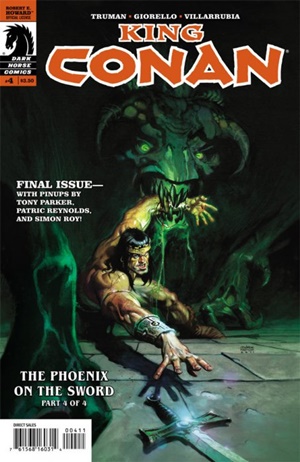 Pretty much the same thing. Though, the writing is a little bit better in the second version. Howard continually honed his skill.
Pretty much the same thing. Though, the writing is a little bit better in the second version. Howard continually honed his skill.
But while the focus of the remainder of the Kull story is instead of fretting over his limitations as king, Howard has Conan dream.
Now, this little dream interlude matters, because Ascalante has a slave named Thoth-Amon. A Stygian, he was once a powerful sorcerer, but he had lost his magical Ring of Set, and was now weak, and in hiding. He is sent to accompany Dion, the totally useless noble, to make sure that the latter doesn’t expose the plot. Dion, who is beyond clueless, has the very ring Thoth Amon seeks. Quickly reclaiming it with a dagger, the sorcerer turns to revenge against Ascalante, using his once-lost dark arts. Unfortunately for Conan, he’s only a few feet away from the potential royal usurper. He’s definitely in the neighborhood of being collateral damage.
Howard was the best prose writer I’ve discovered yet in the fantasy field. He just had a fantastic way with words:
“There was a movement about him, such a swirl as is made in water when some creature rises to the surface. A nameless, freezing wind blew on him briefly, as if from an opened Door. Thoth felt a presence at his back, but he did not look about. He kept his eyes fixed on the moonlit space of marble, on which a tenuous shadow hovered. As he continued his whispered incantations, this shadow grew in size and clarity, until it stood out distinct and horrific. Its outline was not unlike that of a gigantic baboon, but no such baboon ever walked the earth, not even in Stygia. Still, Thoth did not look, but drawing from his gridle, a sandal of his master – always carried in the dim hope that he might be able to put it to such use – he cast it behind him.”
From Thoth Amon staring at the ring he has longed for, through the beast passing by a stunned guard at the palace (which ends chapter three), this is a terrific sequence of writing.
Meanwhile, asleep in his chamber, Conan travels to a magnificent tomb. There he meets the long-dead sage, Epemitrius, who, during his life, fiercely battled the evil snake-god, Set. Epemitrius etches the symbol of a phoenix onto Conan’s sword. Then, Conan wakes in his room and hears stealthy footsteps in the corridor and begins to prepare himself for combat.
The battle scene is similar in both versions, with Kull and Conan trying to avoid harming the mad minstrel (I found that whole ‘a minstrel is greater than a king’ something more fitting for de Camp and Carter than Howard, myself).
With all the rogues either dead or fled (hey, that rhymed!), Ascalante gains the advantage and is about to kill Kull in the original version. Only to have Sena save the day. But there is no Sena and Ala in Conan’s version. And while I think it has been good up to this point, it is here that “The Phoenix on the Sword” really shines and we see Robert E. Howard’s emergence as one of the greatest fantasy writers.
Conan uses his axe-arm to wipe blood from his eyes at precisely the wrong moment. Ascalante, alone and with nothing to lose, rushes at him. The would-be assassin doesn’t quite make it there:
“But even as he began his charge, there was a strange rushing in the air and a heavy weight struck terrifically between his shoulders. He was dashed headlong and great talons sang agonizingly in his flesh. Writhing desperately beneath his attacker, he twisted his head about and started into the face of Nightmare and lunacy. Upon him crouched a great black thing which he knee was born in no sane or human world. Its slavering black fangs were near his throat and the glare of its yellow eyes shriveled his limbs as a killing wind shrivels young corn. The hideousness of its face transcended mere bestiality.”
“In those abhorrent features the outlaw’s dilated eyes seemed to see, like a shadow in the madness that enveloped him, a faint and terrible resemblance to the slave Thoth-Amon.”
I mean, WOW!!! (Yeah, I know. My keen analysis is breathtaking…)
Ascaltante dies of sheer terror: “Then, Ascalante’s cynical and all-sufficient philosophy deserted him, and with a ghastly cry he gave up the ghost before those slavering fangs touched him.”
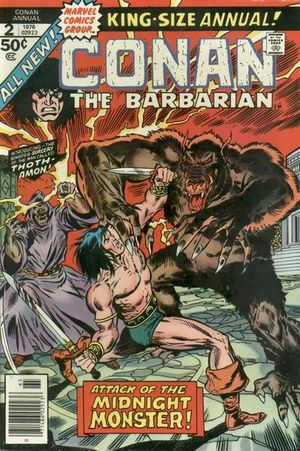 Howard had developed Ascalante in this short story. He is not just a paper-thin supporting character. And he did a fantastic job of having the man, in the absolute horror of his final moments, get at least a flickering understanding that his slave had gotten his revenge. And then, he dies. It’s brilliant work.
Howard had developed Ascalante in this short story. He is not just a paper-thin supporting character. And he did a fantastic job of having the man, in the absolute horror of his final moments, get at least a flickering understanding that his slave had gotten his revenge. And then, he dies. It’s brilliant work.
Which leaves a ‘frozen’ Conan to face this new threat. And in just THREE paragraphs, Howard gives us a marvelous fight between the Cimmerian and the supernatural creature. At this point, I think that “Phoenix” is simply a much more interesting and entertaining story than “Axe!” was.
The creature would have killed Conan, if not for the phoenix etched on his sword by Epimetrius. That allowed the weapon, even though broken earlier in the fight, to fatally wound it.
I think that “By This Axe I Rule!” Is a good enough story. Though, it’s not one I would turn back to very often. Whereas, I’ve re-read “The Phoenix on the Sword” quite a few times. In large part, because I like the swords and sorcery aspect of it.
Thoth Amon was the catalyst, though not actually present, in “The God in the Bowl.” So, Howard had him in mind for two of the first three Conan tales. But he never again used the Stygian sorcerer. And since “Bowl” was rejected by Wright and not published until 1952, he was effectively a one-shot character in the authentic Conan Canon.
That changed, however, when L. Sprague de Camp decided to make him the main antagonist in the barbarian’s life, as he laid out the original and ‘new’ tales as a Conan Saga. The Marvel comics also utilized Thoth Amon, so that he is now generally considered ‘the’ Conan villain.
While it’s not the best Conan story written by Howard, I do think it’s the perfect introduction to Conan. He already has many exploits behind him and is now a king. It’s got a royal assassination plot: and sorcery. And it has the quality writing characteristic of much of Howard’s work.
2025 (3)
Shelfie – Dashiell Hammett
Windy City Pulp & Paper Fest – 2025
Will Murray on Who was N.V. Romero?
2024 Series (11)
Will Murray on Dashiell Hammett’s Elusive Glass Key
Ya Gotta Ask – Reprise
Rex Stout’s “The Mother of Invention”
Dime Detective, August, 1941
John D. MacDonald’s “Ring Around the Readhead”
Harboiled Manila – Raoul Whitfield’s Jo Gar
7 Upcoming A (Black) Gat in the Hand Attractions
Paul Cain’s Fast One (my intro)
Dashiell Hammett – The Girl with the Silver Eyes (my intro)
Richard Demming’s Manville Moon
More Thrilling Adventures from REH
Prior Posts in A (Black) Gat in the Hand – 2023 Series (15)
Back Down those Mean Streets in 2023
Will Murray on Hammett Didn’t Write “The Diamond Wager”
Dashiell Hammett – ZigZags of Treachery (my intro)
Ten Pulp Things I Think I Think
Evan Lewis on Cleve Adams
T,T, Flynn’s Mike & Trixie (The ‘Lost Intro’)
John Bullard on REH’s Rough and Ready Clowns of the West – Part I (Breckenridge Elkins)
John Bullard on REH’s Rough and Ready Clowns of the West – Part II
William Patrick Murray on Supernatural Westerns, and Crossing Genres
Erle Stanley Gardner’s ‘Getting Away With Murder (And ‘A Black (Gat)’ turns 100!)
James Reasoner on Robert E. Howard’s Trail Towns of the old West
Frank Schildiner on Solomon Kane
Paul Bishop on The Fists of Robert E. Howard
John Lawrence’s Cass Blue
Dave Hardy on REH’s El Borak
Prior posts in A (Black) Gat in the Hand – 2022 Series (16)
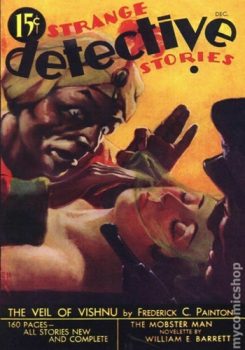 Asimov – Sci Fi Meets the Police Procedural
Asimov – Sci Fi Meets the Police Procedural
The Adventures of Christopher London
Weird Menace from Robert E. Howard
Spicy Adventures from Robert E. Howard
Thrilling Adventures from Robert E. Howard
Norbert Davis’ “The Gin Monkey”
Tracer Bullet
Shovel’s Painful Predicament
Back Porch Pulp #1
Wally Conger on ‘The Hollywood Troubleshooter Saga’
Arsenic and Old Lace
David Dodge
Glen Cook’s Garrett, PI
John Leslie’s Key West Private Eye
Back Porch Pulp #2
Norbert Davis’ Max Latin
Prior posts in A (Black) Gat in the Hand – 2021 Series (7 )
The Forgotten Black Masker – Norbert Davis
Appaloosa
A (Black) Gat in the Hand is Back!
Black Mask – March, 1932
Three Gun Terry Mack & Carroll John Daly
Bounty Hunters & Bail Bondsmen
Norbert Davis in Black Mask – Volume 1
Prior posts in A (Black) Gat in the Hand – 2020 Series (21)
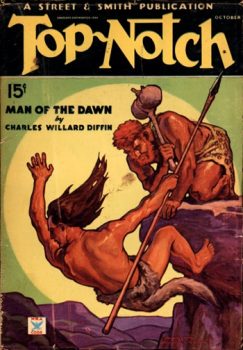 Hardboiled May on TCM
Hardboiled May on TCM
Some Hardboiled streaming options
Johnny O’Clock (Dick Powell)
Hardboiled June on TCM
Bullets or Ballots (Humphrey Bogart)
Phililp Marlowe – Private Eye (Powers Boothe)
Cool and Lam
All Through the Night (Bogart)
Dick Powell as Yours Truly, Johnny Dollar
Hardboiled July on TCM
YTJD – The Emily Braddock Matter (John Lund)
Richard Diamond – The Betty Moran Case (Dick Powell)
Bold Venture (Bogart & Bacall)
Hardboiled August on TCM
Norbert Davis – ‘Have one on the House’
with Steven H Silver: C.M. Kornbluth’s Pulp
Norbert Davis – ‘Don’t You Cry for Me’
Talking About Philip Marlowe
Steven H Silver Asks you to Name This Movie
Cajun Hardboiled – Dave Robicheaux
More Cool & Lam from Hard Case Crime
A (Black) Gat in the Hand – 2019 Series (15)
Back Deck Pulp Returns
A (Black) Gat in the Hand Returns
Will Murray on Doc Savage
Hugh B. Cave’s Peter Kane
Paul Bishop on Lance Spearman
A Man Called Spade
Hard Boiled Holmes
Duane Spurlock on T.T. Flynn
Andrew Salmon on Montreal Noir
Frank Schildiner on The Bad Guys of Pulp
Steve Scott on John D. MacDonald’s ‘Park Falkner’
William Patrick Murray on The Spider
John D. MacDonald & Mickey Spillane
Norbert Davis goes West(ern)
Bill Crider on The Brass Cupcake
A (Black) Gat in the Hand – 2018 Series (32)
George Harmon Coxe
Raoul Whitfield
Some Hard Boiled Anthologies
Frederick Nebel’s Donahue
Thomas Walsh
Black Mask – January, 1935
Norbert Davis’ Ben Shaley
D.L. Champion’s Rex Sackler
Dime Detective – August, 1939
Back Deck Pulp #1
W.T. Ballard’s Bill Lennox
Erle Stanley Gardner’s The Phantom Crook (Ed Jenkins)
Day Keene
Black Mask – October, 1933
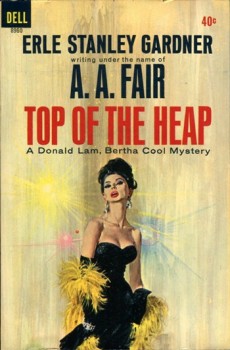 Back Deck Pulp #2
Back Deck Pulp #2
Black Mask – Spring, 2017
Erle Stanley Gardner’s ‘The Shrieking Skeleton’
Frank Schildiner’s ‘Max Allen Collins & The Hard Boiled Hero’
A (Black) Gat in the Hand: William Campbell Gault
A (Black) Gat in the Hand: More Cool & Lam From Hard Case Crime
MORE Cool & Lam!!!!
Thomas Parker’s ‘They Shoot Horses, Don’t They?’
Joe Bonadonna’s ‘Hardboiled Film Noir’ (Part One)
Joe Bonadonna’s ‘Hardboiled Film Noir’ (Part Two)
William Patrick Maynard’s ‘The Yellow Peril’
Andrew P Salmon’s ‘Frederick C. Davis’
Rory Gallagher’s ‘Continental Op’
Back Deck Pulp #3
Back Deck Pulp #4
Back Deck Pulp #5
Joe ‘Cap’ Shaw on Writing
Back Deck Pulp #6
The Black Mask Dinner

Bob Byrne’s ‘A (Black) Gat in the Hand’ made its Black Gate debut in 2018 and has returned every summer since.
His ‘The Public Life of Sherlock Holmes’ column ran every Monday morning at Black Gate from March, 2014 through March, 2017. And he irregularly posts on Rex Stout’s gargantuan detective in ‘Nero Wolfe’s Brownstone.’ He is a member of the Praed Street Irregulars, founded www.SolarPons.com (the only website dedicated to the ‘Sherlock Holmes of Praed Street’).
He organized Black Gate’s award-nominated ‘Discovering Robert E. Howard’ series, as well as the award-winning ‘Hither Came Conan’ series. Which is now part of THE Definitive guide to Conan. He also organized 2023’s ‘Talking Tolkien.’
He has contributed stories to The MX Book of New Sherlock Holmes Stories — Parts III, IV, V, VI, XXI, and XXXIII.
He has written introductions for Steeger Books, and appeared in several magazines, including Black Mask, Sherlock Holmes Mystery Magazine, The Strand Magazine, and Sherlock Magazine.
You can definitely ‘experience the Bobness’ at Jason Waltz’s ’24? in 42′ podcast.
A Challenge Worth Smiling About: Tim Waggoner on Writing Conan

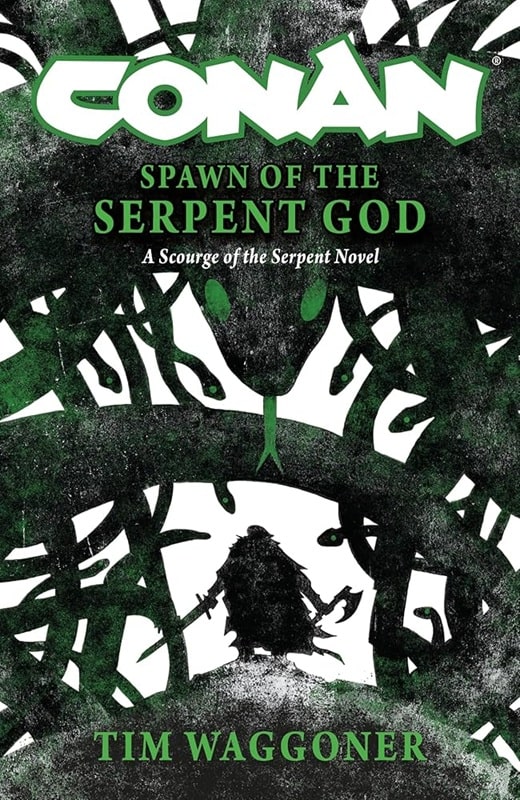
Tim Waggoner, and his upcoming novel Conan: Spawn of the Serpent God (Titan Books, October 28, 2025)
On a non-descript day I am intercepted on entering a coffee shop. It turns out to be a happy accident, an old colleague, eager to join me as I wait for my next interview to begin. The distraction is welcome but doesn’t help much. My interviewee isn’t late but they aren’t early either and I’m beginning to get nervous.
“You’re waiting for him, aren’t you?” the friend asks.
Neither of us mentioned his name because we didn’t have to. Some things, in certain contexts, go together like cheese and tortillas. With four Stoker Awards and many great novels to his name, Tim Waggoner has developed that kind of reputation in this part of Ohio. If Massachusetts is Lovecraft Country then downtown Dayton is Waggonerstan.
[Click the images for Conan-sized versions.]
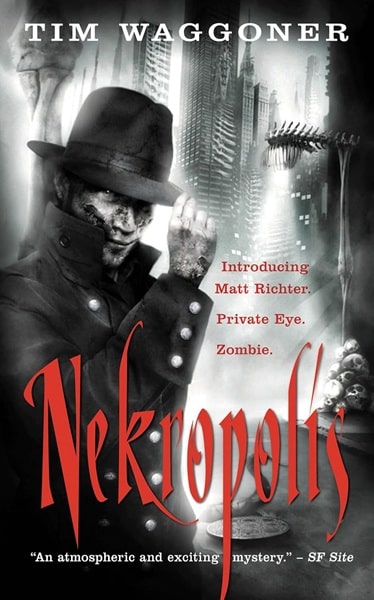
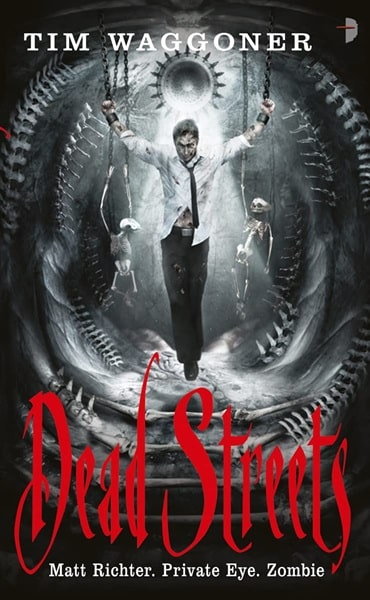
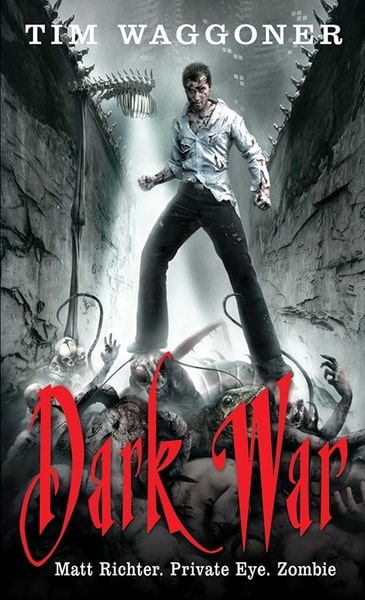
The Nekropolis series by Tim Waggoner: Nekropolis, Dead Streets, and
Dark War (Angry Robot, 2009, 2010, and 2011). Covers by Vincent Chong
“What’s the interview about?”
I swerve the question because this former colleague is a journalist too. When it comes to what Waggoner has to say about the novel we’ve come to talk about, I’d rather get it in Black Gate first. A book the author later estimates is the 62nd or 63rd of his career.
That brief period of forbearance is soon rewarded when Waggoner arrives. I can tell he’s been busy cooking up something special with his new novel. It does not take long before coffee and talk of Conan begins to flow.
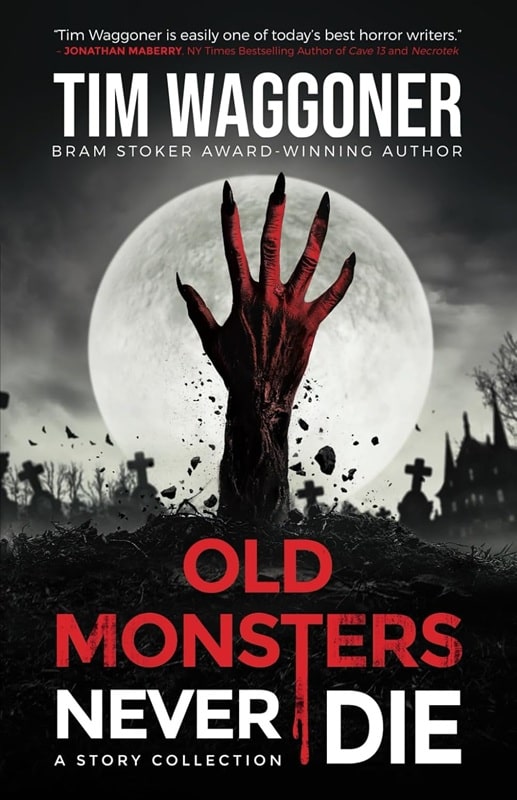
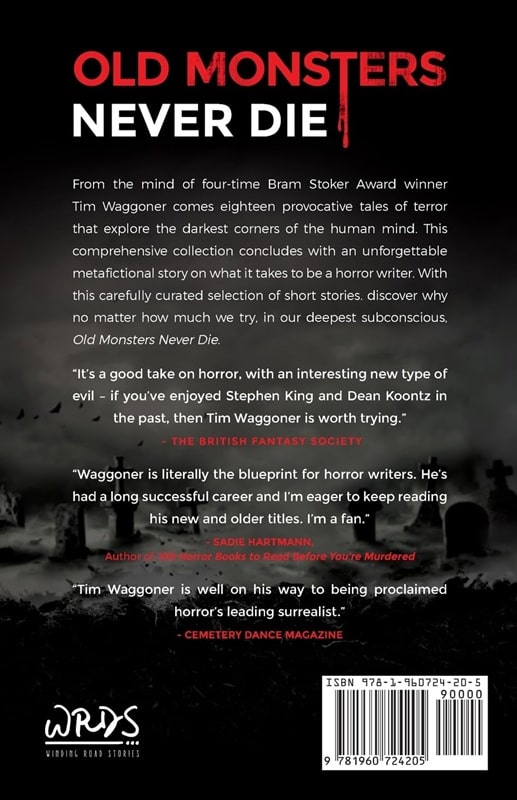
Old Monsters Never Die: A Story Collection by Tim Waggoner
(Winding Road Stories, May 24, 2024). Cover art uncredited
Anyone familiar with Waggoner’s literary career knows he’s worn many hats over the years, dipping his proverbial toe in one genre or another. There’s the Nekropolis series, the fantasy Blade of the Flame novels, and award-winning books on the craft of writing such as Writing in the Dark. Even among those massive projects, trilogies, and the travails every writer faces, working on a Conan novel was a special challenge. In fact, that’s exactly why the first time opportunity came knocking he said no.
“My agent told me Titan was doing Conan and asked if I was interested. I just thought there was no way I could do it because it’s not just about Conan but also the world he inhabited. It’s a very realized world with multiple countries. I just didn’t know if I could do it. After saying no the first time, when I was asked again I just had to do it. I said yes and immersed myself in all the Conan stories I could,” Waggoner told me.
That meant diving deep into the lore of the famous barbarian, going back to the original stories and working his way up to Titan’s ongoing series. It’s clear, however, that like many fantasy fans Waggoner was not coming to Conan blind. This certainly wasn’t his first time in the Hyborian Age.
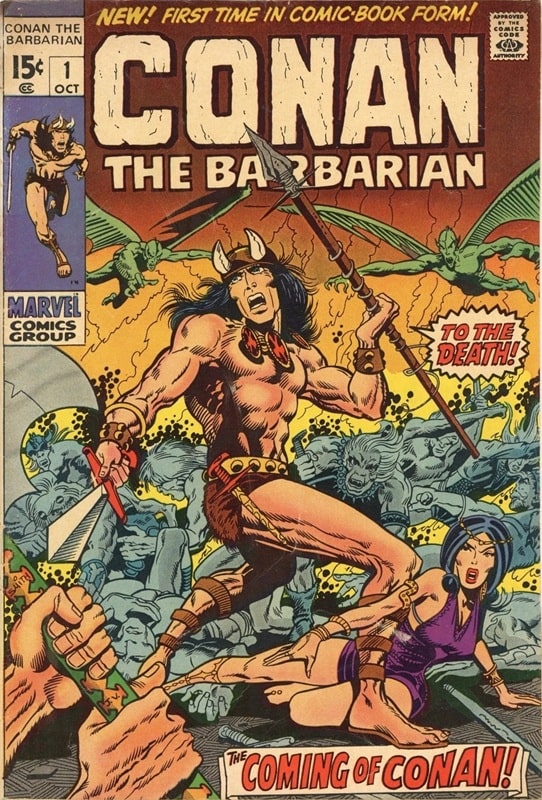

Marvel Comics Conan the Barbarian, issue #1 (Marvel Comics, October, 1970). Cover by Barry Windsor-Smith
“Most of my experience with Conan had been with the comics. As a kid I knew him mostly through Marvel Comics. I had the very first issue for years and wish I’d kept it. I don’t know what happened to it. Probably fell apart I read it so often.”
Through cultural osmosis he learned more about the character through films and other comics. But going back to the original well of creativity that spawned one of fantasy’s greatest protagonists taught him a lot that would serve him well during the writing process. He listened to them on audiobook and read them at home. Waggoner also went on to read the King Kull stories, El Borak, and even Solomon Kane. But it was the stories about Conan that were most integral.

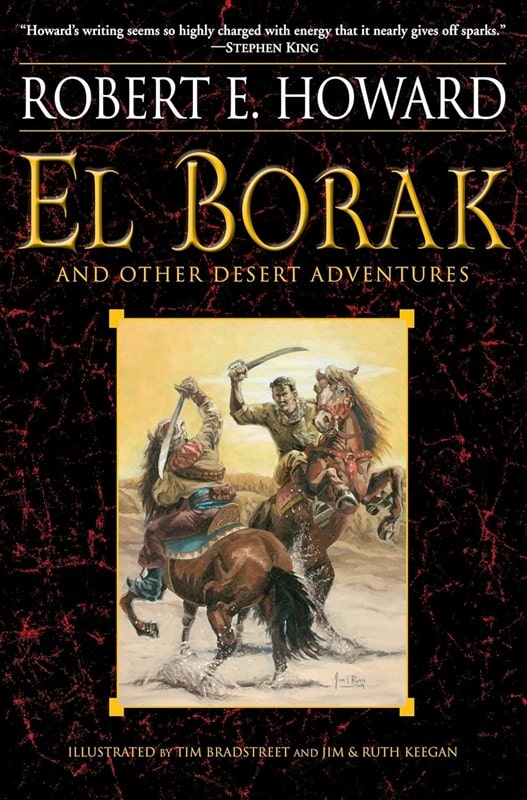
Two Del Rey Robert E. Howard volumes: Kull: Exile of Atlantis, and El Borak and Other Desert
Adventures. (October 31, 2006, and February 9, 2010). Covers by Justin Sweet, and Jim & Ruth Keegan
“It really helped me because the one thing I didn’t get in the comics or in the movies is how much a part of the story the setting is,” he said. “It took me forever to get started on it. I couldn’t figure out where to start but eventually it clicked overall. But a big part of it was realizing the setting was a big part of the story.”
Writing the book was an experience Waggoner described as ‘intimidating’. Who can blame him? Even with decades of experience, taking on a character with such a rich history and fans spanning the globe would challenge anyone.
“I had to try and think of what my version of Conan was because no matter what I knew I wouldn’t be able to write his,” said Waggoner in reference to Howard. “Part of what I did is work that out on the page. Here’s this guy who will critique civilization even as he is drawn to it. I asked myself, ‘why does he do that?’”
One aspect of Conan that fascinated Waggoner is his evolution over time, from thief to pirate to mercenary and eventually king. As the author explains, Cimmerians generally don’t travel outside Cimmeria. Finding out where that thirst for adventure came from was integral to understanding the character.

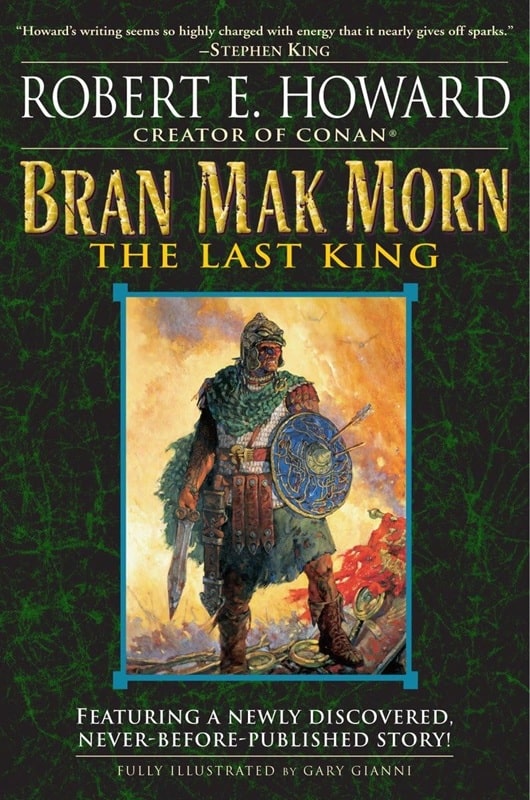
Two more Del Rey Howards: The Savage Tales of Solomon Kane and
Bran Mak Morn: The Last King (July 2004 and June 2005). Covers by Gary Gianni
“I did find out that in a letter Robert E. Howard wrote that Conan’s grandfather had traveled some, told him stories as a kid, and that was of what woke that in him. While he (Howard) never wrote it in a story that helped me see where part of that aspect of Conan came from. But part of that is just his nature too,” Waggoner explained.
The novel, according to Waggoner, will show readers two sides of the barbarian with the story focused on Conan’s life at 17 and 32. It’s a two-part story separated by 15 years, which helped the author show the titular character’s growth over time. This can be seen in his natural cursiotiy as a teenage thief as well as in his expansive knowledge of other languages and cultures later on. Conan’s interactions with religion and the origin of his unique sense of chivalry are also touched on in the book.
“That’s because when I write any kind of tie-in like this I try to imagine them as real people. If I’m trying to write about Conan being real then I have to ask myself why does he do these sorts of things and why are they so important to his character?”
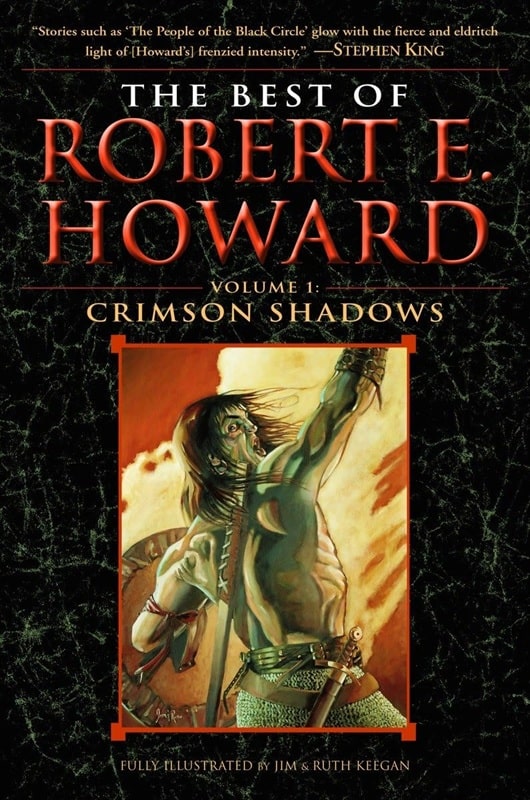

The Best of Robert E. Howard, Volumes 1 & 2: Crimson Shadows and Grim Lands
(Del Rey, August 31, 2009 and December 2007). Covers by Jim Keegan and Ruth Keegan
Its an approach that has worked well in the past and allowed him to touch on a part of Conan a some have missed in the past.
“I think one thing some of the comics and movies miss is that while he (Conan) is dour and grim, that’s not all he is. Howard says in that one description ‘gigantic mirths and gigantic melancholies’. The mirth part you don’t see very much. I tried to put some of that in there. I also tried to show how he had a lot more anger and was quicker to violence at 17 than he was at 32. Over time, he becomes a lot more skilled.”
Of course, given the amount of time left between now and the book’s listed Oct. 27 publication date, things may change and edits might be made. Waggoner admits that some of what he wrote might be edited out though he is hopeful. Midway through the conversation I mention Conan’s connection to Cthulhu and Waggoner’s answer leaves me hopeful too.
“I tried to include some of that too,” he said with a smile.
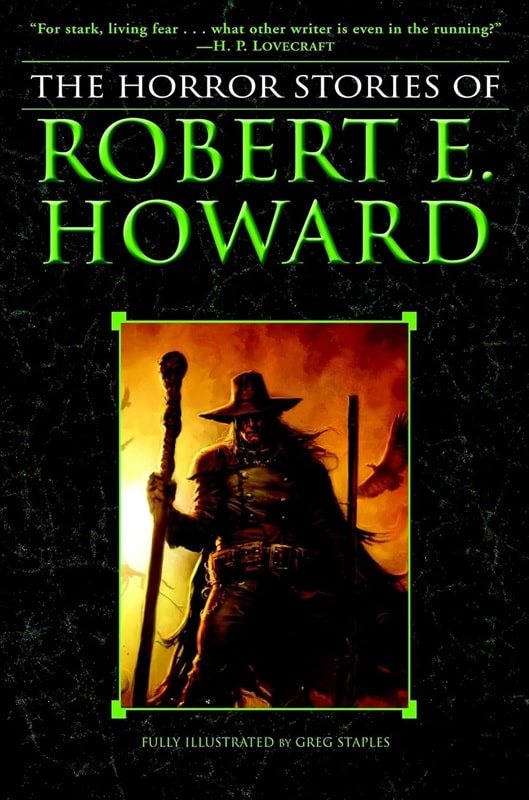
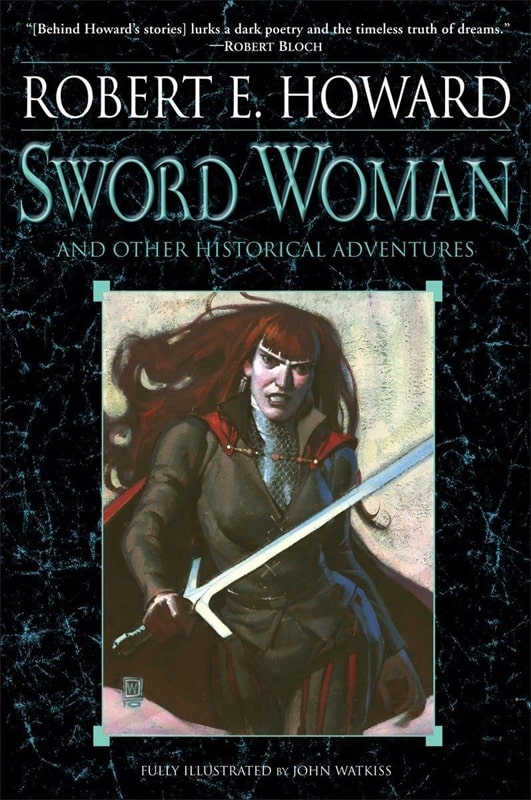
The Horror Stories of Robert E. Howard and Sword Woman (Del Rey,
July 29, 2008 and January 25, 2011). Covers by Greg Staples and John Watkiss
Regardless, its clear a ton of work has gone into making the novel as best as it can be. When Conan: Spawn of the Serpent God does come out, it will be a welcome addition to many bookshelves around the world. And if Titan’s release schedule is anything to go by, the beloved sword-wielding warrior shows no signs of slowing down. Conan, its no exaggeration to say, is thriving.
“I think he’s endured so long because he’s the same sort of character, ultimately, as the lone gunslinger or the private eye. He’s the individual that is true to himself and can be himself in whatever society he’s in,” Waggoner said.
But there is one other ingredient the author feels separates Conan from the pack. One so important it leaves other legacy characters like Sam Spade and The Shadow in the dust.
“With Conan his motive ultimately is adventure. It’s living life and experiencing it absolutely to the fullest. You don’t see that in a lot of warrior type characters. You don’t see that in the lone gunslinger. The private eye is usually depressed. Conan, however, I don’t think we even know what happens to him at the end of his life because eventually he tells his son ’you be king, I’m out of here’ and just goes adventuring all over again,” Waggoner said with a laugh.
Ismail D. Soldan is an author, journalist, and poet. His work has previously appeared in Illustrated Worlds, LatineLit, and The Acentos Review among other publications. A proud explorer of both real and imagined worlds, his most recently published short story can be read in the January 2025 issue of Crimson Quill Quarterly, and his last article for Black Gate was New Adventures for the World’s Favorite Barbarian.
Tubi Dive, Part V


Meatball Machine and Meatball Machine Kodoku (TLA Releasing, 2005 and 2017)
50 films that I dug up on Tubi.
Enjoy!
Meatball Machine (2005) and Meatball Machine Kodoku (2017)It’s a double-header in more ways than one, as I settled down to watch a couple of films that bookend a period known to cinephiles as Gonzo Japanese Splatter. Between these films, we were served up classics such as Tokyo Gore Police, Machine Girl, and the afore-reviewed Toilet of the Dead and Dead Sushi, but those are just the tip of the grue-coated iceberg.
If you are familiar with Tetsuo: The Iron Man from 1989, you’ll already have a grasp of the themes in these films; isolation, sexual desire, transformation, body horror and extreme gore.
Meatball Machine was directed by Yūdai Yamaguchi with effects by long-time Noboru Iguchi collaborator Yoshihiro Nishimura (Nishimura would later go on to direct the Meatball sequel). It looks like it was shot on digital video, with blown out colors, and I’m not a fan, but that could also be down to the dodgy copy Tubi has.
The story concerns Yōji, a downtrodden young man who has a rubbish job and stifles his loneliness by pining for a young woman, Sachiko, whom he watches from afar during his lunch breaks. In the background of this sob story, we learn that parasites are taking over people and mutating them into killing machines, for reasons.
Yōji stumbles across the carapace of one of these creatures and takes it home. One night, after saving Sachiko from a sexual assault, they finally get to sit and talk, and discover they are both lonely. This is all building up to a sweet moment, but then the carapace springs into life, attaching itself to Sachiko and OH MY FREAKING GOD. Yamaguchi cranks everything up to 11 and covers everyone in dripping gore throughout the rest of the film. It’s wild, utterly bonkers, and ridiculously entertaining (if you like that sort of thing, you disgusting person, you). Multiple fights and plot twists ensue, and a new sub-genre is kickstarted into horrific life.
Meatball Machine Kodoku takes the idea in a completely different direction, leaning heavily into an aliens angle while also expanding upon the lore. Director Nishimura, always on the lookout to outdo himself and everyone else in the genre, goes completely potty, coming up with some of the weirdest and most wonderful body transformations I have ever seen.
In this film, Yuji, a downtrodden, middle-aged man who hates his debt collecting job, secretly pines for a cute young woman, Kaoru, who works in his local bookstore. When he saves her from a potential assault, they finally get together and, yes, you guessed it, everything goes to poop. So far, so very similar.
However, this time the parasites infest a whole city, not only that, but they trap the entire city in a giant alien bell jar, and let everyone kill each other. For reasons.
One aspect I enjoyed about this one was that when mutated by a parasite, your body’s weapon is the thing you are most recently connected to. So a construction worker gets a jackhammer for an arm, while a burlesque dancer who was eating spaghetti ends up with a fork. It’s especially fun watching the parasites control their hosts with outlandish levers in their little pod ‘brains.’ This film is actually light on horror for the first 30 minutes, and then BOOM — a chopped off willy and a bisected pair of lovers kick off the whole shebang — and it all gets set to ludicrous speed.
It’s hard to elicit any sympathy for Yōji and Yuji, as in both films they immediately objectify their love interests, but in the end you can’t help rooting for them.
Naturally, if you have an aversion to extreme body horror, writhing tendrils, copious amounts of gore, boob and pantie obsessions and tasteless deaths, then these aren’t the films for you. However, I laughed a lot, and not necessarily at the right moments.
Let me know if you watch them!
7/10 and 8/10 respectively
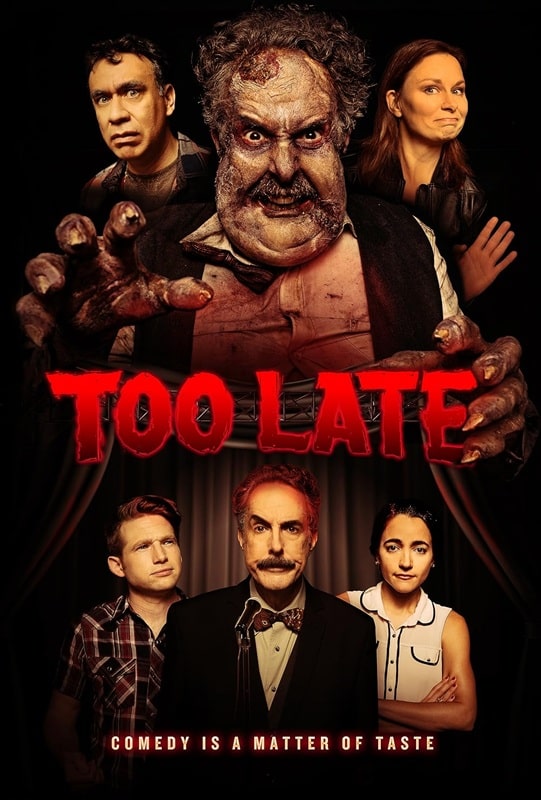

Too Late (Vanishing Angle, June 11, 2015) and Chawz (Lotte Entertainment, July 16, 2009)
Taking a break from gonzo Asian splatter-fests, I found myself settling in for what one might describe as a ‘cozy’ horror-comedy. Personally, I’d describe it as a missed opportunity, but a cursory glance at other reviews reveals I’m in the minority, so what do I know?
Violet (Alyssa Limperis) is the assistant to a famous stand-up comedian, Bob Devore (Ron Lynch), and she helps him find new talent for his late-night live show, Too Late. He doesn’t just need raw talent to entertain his crowds though, as Bob is a supernaturally old, shape-shifting monster that has to eat every four weeks. He’s been in the entertainment business a very long time, and only the most talented acts will sate his hunger. When Violet falls in love with one of his potential meals, she must find a way to terminate her contract and save herself. And that’s about the gist of it. A not-so-subtle allegory for the destructive nature of showbiz.
I’m good with this. It’s a solid concept and the film is well-shot and directed, and for the most part well acted. Fred Armisen and Mary Lynn Rajskub pop up for short cameos, mainly, I suspect, to help get the film funded and to put on the DVD cover, and the rest of the cast is filled out with the usual roster of genre types. They all do their jobs admirably. The horror itself is fairly tame, and other than a shot at the end, relatively bloodless, and I didn’t mind that either.
What I did object to though was the notion that this all takes place against the backdrop of a comedy club, and not a single one of the performers was funny. I get it. Comedy is subjective, but come on, some of this was the dullest observational humour I have ever heard. Not the main focus of the story, but it still irked me enough to get salty as I watched it.
Bottom line, OK.
5/10
Chawz (aka Chaw) (2009)The Korean title Chaw translates to ‘trap’, but this creature feature wears its influences on such a large sleeve, that it was rebranded to Chawz for its US release, capitalizing on that old shark movie.
I’ve been a sucker for giant, mutant boar movies ever since I first watched Russell Malcahy’s Razorback back in the day. Sadly, they are a bit thin on the ground, but this is a good one, so I’m glad I caught up with it.
It’s your usual monster movie fare; giant creature terrorizes a village, eats folk, is a bit of a nuisance etc., plucky group of tropes band together to hunt it down. So far, nothing new. However, this being a Korean film, it has to meet the 2 hour run time, so there is a lot more going on with a broad roster of characters. We have a fish out of water tale with Kim Kang-soo, a freshly transferred cop, a revenge tale with Chun Il-man wanting to avenge his grand-daughter’s savage death, some light comedy via a clutch of goofy cops and hangers-on, a doomed romance, a crazy lady, an incompetent official, etc etc.
It’s a lot to follow, and the film would benefit from a bit of pruning, but on the whole I had fun with it. The monster effects are fine; a combination of puppetry and B-tier CG, and there are plenty of homages littered throughout to prompt a drinking game.
It’s no The Host, but still worth a look.
7/10
 Monster Seafood Wars (Pal Entertainments, June 6, 2020)
Monster Seafood Wars (2020)
Monster Seafood Wars (Pal Entertainments, June 6, 2020)
Monster Seafood Wars (2020)
Never one to turn my nose up at a kaiju slam-fest, I started this one with some trepidation, and was wise to do so. It’s all rather maddening. Stuck inside this ‘comedy’ is a decent monster flick idea; a young slacker scientist creates a serum that can make creatures grow huge in an effort to cure world hunger. His invention is stolen by a nefarious rival, who also steals his shrine offerings (a squid, an octopus and a crab), which are then mutated to ridiculous size and promptly go on a rampage.
The aspect I really enjoyed was the fact that the populace discovers these kaiju are delicious, and so they are happy to let them fight while they control them with vinegar cannons, so that chunks get knocked off and turned into gourmet dishes. That’s what the story should have focused on — it’s a great hook that could allow some excellent moral dilemmas, but instead we have to wade through a tedious love triangle and unnecessary ‘mockumentary’ interviews with the witnesses to the shenanigans.
It also doesn’t help that the monsters themselves are cutesy mascot-style designs with googly eyes and fixed expressions. I wonder how awesome this film could be with realistic creatures and a focus on their deliciousness.
Oh well.
5/10


Blood Surf (Trimark Pictures, December 4, 2000) and Body Melt (Beyond Distribution, December 15, 1993)
If you know me by now, I’m always up for a killer crocodile/alligator flick, and when I learned that the late, great John Carl Buechler was responsible for the reptile effects, I got mistakenly excited.
You see, it’s a film about a hugely unlikable group of MTV brats who want to film themselves surfing with chum-crazed sharks, but instead get roped into a croc of shit. The effects are not good, lots of dodgy superimposition, and the filmmakers had no idea how to shoot the big croc puppet. The script is aggressively dumb, the actors deliver their stupid lines with zero interest, and the whole thing is a crushing bore.
What with a Jürgen Prochnow ordered off of Wish, a Matthew Lilliard/Seann William Scott hybrid, and two girls flashing their tits at the beast before one says, “I guess that’s what you call a croc tease,” I was done with it all.
The one single redeeming feature was that one character was called Melba, which allows me to make a ‘Melba was quickly toast’ joke.
Bah.
1/10
Body Melt (1993)Here’s a strange one from down under — a gonzo, sci-fi, body-horror goo-a-thon starring Ian (Harold Bishop from Neighbours) Smith as an evil doctor. Brilliant bit of casting.
The story is about an immoral pharmaceutical company that doles out free pills to the residents of a small community, and then records the various side-effects. Side effects include: exploding body parts (heads, willies, that sort of thing), sentient placentas, randomly placed tentacles, cannibalism, and various amounts of melting.
As you might be able to discern, there are no set rules to the side-effects, and this is the downside to the film. Rather than tell a coherent story, it plays out more as a series of gloopy vignettes, and we really don’t have a main protagonist to follow.
That said, it’s quite ridiculously fun, and there’s plenty of weird stuff going on (and one or two big laughs), so I’m recommending it to all the weirdos out there.
6/10
Previous Murkey Movie surveys from Neil Baker include:
Tubi Dive, Part I
Tubi Dive, Part II
Tubi Dive, Part III
Tubi Dive, Part IV
What Possessed You?
Fan of the Cave Bear
There, Wolves
What a Croc
Prehistrionics
Jumping the Shark
Alien Overlords
Biggus Footus
I Like Big Bugs and I Cannot Lie
The Weird, Weird West
Warrior Women Watch-a-thon
Neil Baker’s last article for us was Part IV of Tubi Dive. Neil spends his days watching dodgy movies, most of them terrible, in the hope that you might be inspired to watch them too. He is often asked why he doesn’t watch ‘proper’ films, and he honestly doesn’t have a good answer. He is an author, illustrator, teacher, and sculptor of turtle exhibits. (AprilMoonBooks.com).
Tor Doubles #5: Poul Anderson’s No Truce with Kings and Fritz Leiber’s Ship of Shadows
 Cover for No Truce with Kings by Royo
Cover for No Truce with Kings by RoyoCover for Ship of Shadows by Robin Wood
Both Poul Anderson’s No Truce for Kings and Fritz Leiber’s Ship of Shadows originally appeared in issues of The Magazine of Fantasy and Science Fiction, Not only did their initial publication occur in the same periodical, but both of those original issues sported covers painted by Ed Emshwiller.
No Truce for Kings was originally published in F&SF in June, 1963. It won the Hugo Award and received a Prometheus Hall of Fame Award in 2010. No Truce for Kings In is the first of three Anderson stories to be published in the Tor Doubles series.
Colonel James Mackenzie is the commander of Fort Nakamura in a post-apocalyptic California who receives a message that Judge Brodsky has been deposed and replaced by Judge Fallon. This message is the indication to Mackenzie that a civil war has broken out. Although Mackenzie and his troops are loyal to the old regime, the letter makes it clear that Mackenzie’s son-in-law, Thomas Danielis, is aligned with the rebels, as well as serving as a hostage for the troops who are coming to relieve Mackenzie of his command.
The story alternates between Mackenzie’s and Danielis’ actions in the subsequent war, and although Anderson includes many indicators of what the old regime looked like, with a series of local feudal lords called bossmen, and the attempts to destroy that society by the forces of Fallon and his allies, the use of time jumps throughout the story give it a somewhat disjointed feel. However, the use of a Mackenzie and Danielis, as relatives, along with the occasional appearance and frequent mention of Laura, Mackenzie’s daughter and Danielis’ wife, as well as her pregnancy and the birth of her child, combine to give the discussions of tactics and strategies a more personal flavor throughout the story.
While No Truce for Kings starts out as a pretty generic post-apocalyptic story, Anderson adds in an alien element that sets it apart. His aliens, who mostly appear in conversation with themselves as observers of the actions of the humans seem as if they are a response to the psychohistorians of Isaac Asimov’s Foundation series, which was originally published twelve years before No Truce for Kings. These aliens make use of psychodynamicism to guide the events of the humans as they come out of the fall of civilizations. Furthermore, while Asimov created the religion of scientism to help guide the galaxy, Anderson’s aliens have introduced Espers, people who ostensibly have psychic abilities.
The interludes have only a minor direct impact on the action of the story, but they allow Anderson to provide the information the reader needs so the main characters can continue interacting with their world without providing a data dump and allows the reader to have additional background knowledge they don’t have. When Mackenzie comes into contact with a group of Espers, who are theoretically neutral in the war between Fallon and Brodsky, the information Anderson has provided in the discussion of his aliens provides more depth to the Espers’ actions that may seem odd to Mackenzie but can be explained away, except the reader has an understanding where he has gone wrong.
Anderson doesn’t just place Danielis and his father in law on opposite sides of the war, he provides them with a reason for being on those sides. Mackenzie grew up in the system of bossmen and thrived because of it. To him it was the natural order of things. Danielis was an orphan who had to work his way up through the system, eventually succeeding in a military career. He was helped along the way by the Espers, and although they were officially neutral, there is no point in the story that it doesn’t seem like common knowledge that they are supportive of Fallon’s rebellion.
Eventually, of course, the existence of the aliens becomes known and changes the course of the war. The forces of Fallon and Brodsky, all of whom are aware that there was once a more unified country that had collapsed and all of whom have hopes to reestablish in their own ways, suddenly become aware that there is more out there, and can offer them a higher level of technology than humans had previously had access to. This is an area that Anderson had previously explored in works like The High Crusade, published three years before No Truce for Kings. Although Anderson addresses the dichotomy of science, it is done in an almost cursory manner, providing the story with something of an anticlimax from that point of view.
At the same time, his decision to follow Danielis and Mackenzie throughout, focusing on their experiences and the stresses caused by the knowledge that they were on opposite sides of the civil war, imbues the story with a human connection that ultimately does come to a satisfying conclusion, even if the situation does not allow for a happy outcome for all who are involved.
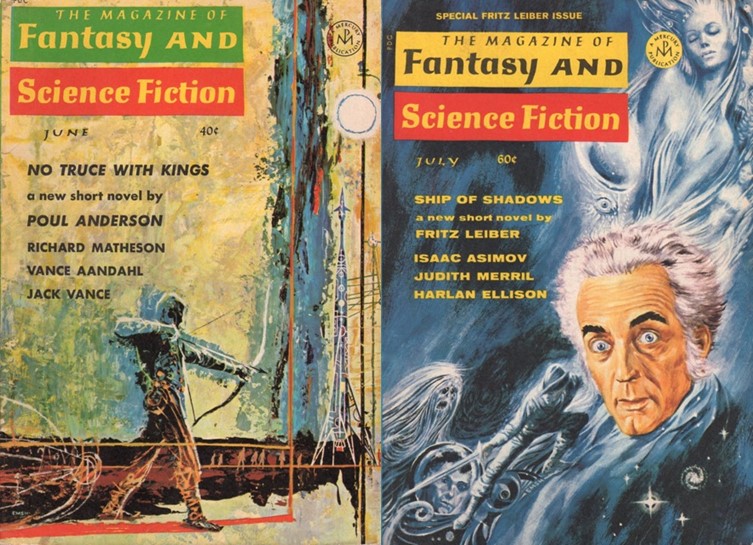 Fantasy and Science Fiction 6/63 cover by Ed Emshwiller
Fantasy and Science Fiction 6/63 cover by Ed EmshwillerFantasy and Science Fiction 7/69 cover by Ed Emshwiller
Ship of Shadows was originally published in F&SF in July, 1969, which was an issue dedicated to Fritz Leiber and included a portrait of him by Ed Emshwiller on the cover. The issue included essays on Leiber by Judith Merril and Al Lewis as well as a reprint of Leiber’s recent poem “iix. ‘Out the frost-rimmed windows peer,…’” and this original novella. Ship of Shadows was nominated for the Hugo Award and the Nebula Award, winning the former. Ship of Shadows is the first of four Leiber stories to be published in the Tor Doubles series, including two that would be published in the final official release of the series.
There is a saying that science fiction (and fantasy) stories have to teach the reader how to read the individual story. The readers must be taught which words should be taken literally and which can be understood metaphorically. Nothing about the story’s setting can be assumed and the reader should allow the author to explain where the story is taking place. Leiber is more than happy to keep the reader in the dark about the actual location in which Ship of Shadows takes place, only revealing the details slowly.
The reader’s entry into this world is Spar, an older man who works as a bartender at the Bat Rack, a dive which serves moonmist, a low grade alcohol. Spar is accompanied by Kim, a talking cat who seems to be his closest friend, although Spar also has a connection with his boss, Keeper, and several of the bar’s patrons, ranging from Doc to Crown to the various women who frequent the bar. Those relationships range from awkwardly cordial to almost adversarial.
Spar has bad teeth and can barely see. He prefers to stay in his menial job at the Bat Rack rather than explore the world around him, taking comfort in the known space, even though it is relatively clear to the reader that even those who seem to have affection for Spar do not respect him or see him as an equal. Even Kim appears to view Spar more as a means to an end.
The world he inhabits appears to be one in which witches and zombies move with impunity, a four day week is in place which includes days for work, idleness, play, and sleep. The world, referred to as Windrush, may also be a ship of some sort, although the characters are not fully aware of its nature. How much of Spar’s knowledge of his world is accurate, how much is legend, and how much is authorial misdirection only becomes partially clear as the novella continues.
Just as Spar seems to have a limited understanding of the world in which he lives, Leiber isn’t in any hurry to provide the reader with any details. It isn’t until he is sent on an errand by Keeper that the world begins to come into an sort of focus, perhaps reflective of the fact that during the errand Spar plans to make a stop to see Doc and have him provide Spar new teeth and new eyes. In his travels, Spar discovers a that Windrush has a variety of different neighborhoods which don’t quite mesh with the world he has pictured living and working in the Bat Rack.
His travels take him to the Bridge, a world of “irregularly pulsing rainbow surfaces, the closest of which sometimes seemed ranks of files of tiny lights going on and off—red, green, all colors. Aloft of everything was an endless velvet –black expanse very faintly blotched by churning, milky glintings.” This revelation, which will be recognized by readers, is strengthened by the fact that it is described through Spar’s imperfect eyesight, which further reinforces the idea that, through no fault of his own, Spar’s impressions of his world of unreliable.
Because of the amount of information Leiber keeps hidden from the reader (and his characters), Ship of Shadows is the sort of work that benefits from re-reading. The first pass lives the reader at a loss for much of the story, but once the explanations come late in the tale, they can illuminate the earlier action when read with the knowledge of what Leiber will eventually reveal.
The cover for No Truce for Kings was painted by Royo. The cover for Ship of Shadows was painted by Robin Wood.
 Steven H Silver is a twenty-one-time Hugo Award nominee and was the publisher of the Hugo-nominated fanzine Argentus as well as the editor and publisher of ISFiC Press for eight years. He has also edited books for DAW, NESFA Press, and ZNB. His most recent anthology is Alternate Peace and his novel After Hastings was published in 2020. Steven has chaired the first Midwest Construction, Windycon three times, and the SFWA Nebula Conference numerous times. He was programming chair for Chicon 2000 and Vice Chair of Chicon 7.
Steven H Silver is a twenty-one-time Hugo Award nominee and was the publisher of the Hugo-nominated fanzine Argentus as well as the editor and publisher of ISFiC Press for eight years. He has also edited books for DAW, NESFA Press, and ZNB. His most recent anthology is Alternate Peace and his novel After Hastings was published in 2020. Steven has chaired the first Midwest Construction, Windycon three times, and the SFWA Nebula Conference numerous times. He was programming chair for Chicon 2000 and Vice Chair of Chicon 7.
Goth Chick News: Exploring GalaxyCon’s Newest Addition – Nightmare Weekend
 Nightmare Weekend Chicago 2025
Nightmare Weekend Chicago 2025
One of the most entertaining aspects of working for Black Gate is hitting the road with Photog Chris Z to cover horror-themed events in the Midwest. Though many people think about Halloween during the fall months, there is an enormous subculture of vendors, artists, and fans for whom the spooky season never ends. This year, Chicago was not only the site of an entirely new show just for this audience but also the first city to host it—and we had a front-row seat on opening night.
GalaxyCon, LLC, founded in 2006 by Mike Broder and based in Fort Lauderdale, Florida, is one of the leading organizers of pop culture conventions in the United States. Initially focused on comic books, anime, and broader fan engagement, GalaxyCon has successfully expanded its portfolio to include horror-themed entertainment with its Nightmare Weekend series.
 The crowd at Nightmare Weekend Chicago 2025
The crowd at Nightmare Weekend Chicago 2025
The expansion into horror began in response to the genre’s increasing popularity, particularly its blend of nostalgia, cult fandom, and crossover appeal to mainstream audiences. With Nightmare Weekend, GalaxyCon has carved out a distinct identity in the horror convention scene, blending celebrity meet-and-greets, specialized vendors, themed parties, and curated entertainment.
The Nightmare Weekend events (of which there are four more in other cities this year) reflect Broder’s business philosophy of engaging fans across diverse interests. “Horror is not just a genre; it’s a lifestyle for many fans,” Broder explained in a recent interview. “Nightmare Weekend is our way of celebrating the culture and giving horror enthusiasts a place to connect and indulge their passion.”
 Best. Cosplay. Ever.
Best. Cosplay. Ever.
We were thrilled to get an invite to cover the inaugural event in Chicago last weekend. To start, there was an impressive lineup of celebrities, including William Shatner, Jeremy Renner, and Barry Bostwick just to name a few. Unfortunately, many of the top names only appeared on Saturday and Sunday so we missed them. Chris Z did get to meet his favorite cosplayer, Ashlynne Dae and we both had a chance to catch up with our favorite Munster, Butch Patrick, who is starting to feel like a member of the family.
Though GalaxyCon hasn’t released official stats for Nightmare Weekend Chicago, we counted roughly 100 artists in the “Artists Alley” area and over 150 vendors, who together occupied one of the largest halls in the Rosemont Convention Center. We inevitably saw a few people and products we had seen at other shows. However, we were thrilled at all the uniqueness we found. Here’s few in no particular order…
 Soheyla Seiff and her incredible wreaths
Soheyla Seiff and her incredible wreaths
Seiffs Wreaths: Based in South Elgin, Illinois, Soheyla Seiff has been crafting handmade, custom wreaths since 2024. The company specializes in creating unique deco mesh wreaths that cater to a variety of themes, including holidays, special occasions, pop culture, and horror fandoms. Each wreath is meticulously designed to reflect its theme, offering customers a personalized touch to their decor. Notably, Seiff’s Wreaths has gained recognition for its horror-themed wreaths, featuring designs inspired by classic horror films and characters, making them a favorite among genre enthusiasts. Customers can explore and purchase these handcrafted creations through Seiff’s official website or their Etsy shop, where each piece is made with attention to detail and a passion for thematic artistry.
 Wynnwood Farms Teas, Elixirs & Bitters
Wynnwood Farms Teas, Elixirs & Bitters
Wynnwood Farms Teas, Elixirs & Bitters: This boutique tea and apothecary brand, based in Houston, Texas, and owned by Alexandria and Debbie Wynn, offers a unique fusion of storytelling and sensory indulgence through their “Dead to Me Collective” collection. This curated selection features horror and storybook-themed teas, elixirs, and bitters, each crafted to transport consumers into a world of imagination and flavor.
The “Midnight Horror” tea line pays homage to classic horror narratives, with blends like “Dr. Frankenstein,” “Final Girl,” and “The Raven,” inviting tea enthusiasts to experience tales of terror and intrigue with every sip. Complementing these are their handcrafted elixirs and bitters from “The Spellbound Alchemist” series, meticulously produced in small batches by a mother-daughter duo. These concoctions, such as “The Lovers” cocktail bitters — a blend of chocolate, cherry bark, and vanilla — are designed to elevate both wellness routines and mixology experiences.
 Crystallo Card Game
Crystallo Card Game
Crystallo Card Game: It wouldn’t be a convention without one of us picking up a new game. Though this isn’t “horror” per se, it is still a very cool concept. Plus, the shiny things attracted my attention. Crystallo, designed by Liberty Kifer, is a solo card game where players rescue magical creatures trapped by the Black Dragon’s crystal magic. Combining set collection and tile placement, the game challenges players to form crystal patterns and ultimately trap the dragon. With stunning artwork, tactile acrylic gems, and a 30-minute playtime, Crystallo offers an engaging and replayable experience for solo gamers. Expansions like “Untold Fortune” and “Den of Dragons” add depth and complexity to this enchanting adventure.
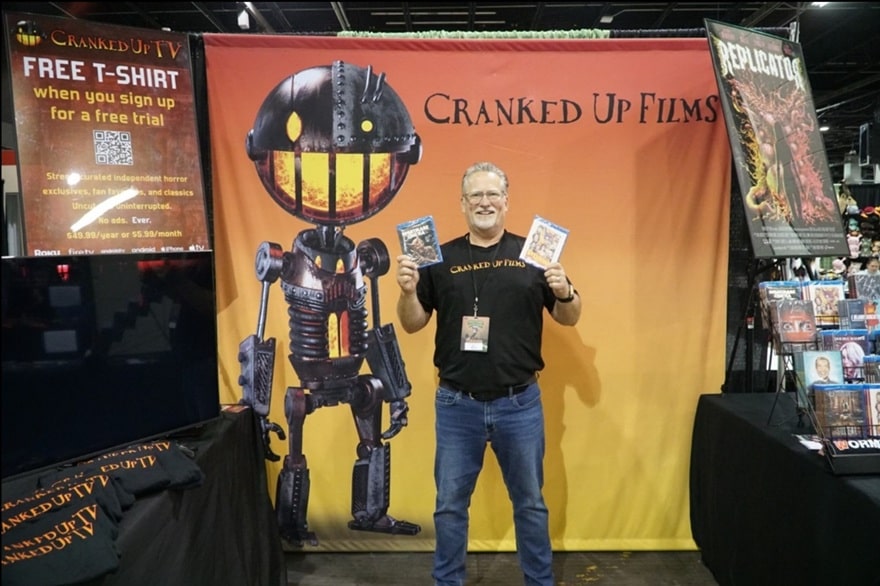 Scott Donley and Cranked Up Films/TV
Scott Donley and Cranked Up Films/TV
Good Deed Entertainment: Scott Donley is the founder and CEO of Good Deed Entertainment (GDE), an independent film studio established in 2012 and headquartered in Ashland, Ohio. Under Donley’s leadership, GDE has built a reputation for producing and distributing character-driven content across various platforms, including film, television, and digital media. The company is perhaps best known for releasing the Academy Award-nominated animated feature Loving Vincent, which tells the story of painter Vincent van Gogh in his signature style. In addition to Loving Vincent, GDE has distributed titles such as Karmalink, Carmen, and Some Freaks, along with the Independent Spirit Award-nominated To Dust and the Annie Award-nominated Charlotte.
Recognizing the growing interest in genre films, Donley launched Cranked Up Films, a division of GDE that focuses on high-concept horror, grounded sci-fi, and speculative fiction. This initiative has led to the production and distribution of films like Nightmare Cinema, a horror anthology featuring segments directed by notable filmmakers such as Mick Garris (Sleepwalkers, Critters 2) and Joe Dante (Gremlins, The Howling). Donley was at Nightmare Weekend promoting his newest venture, Cranked Up TV, the premier destination for ad-free, independent horror, so we now know where our next binge-watch will come from.
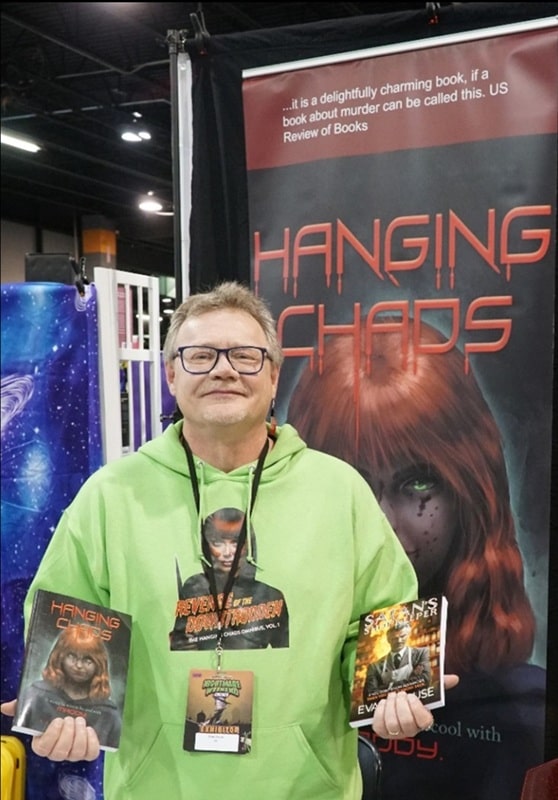 Author Evan Clouse of Hanging Chad Books
Author Evan Clouse of Hanging Chad Books
Hanging Chads Books: Evan Clouse, a former social worker turned author, has made a notable entry into the horror genre with his Hanging Chads series. Launched during what he humorously refers to as his “2/3-life crisis,” Clouse’s writing delves into dark, satirical narratives that blend horror, political commentary, and dark humor. The series follows Maddy Sommers, a vigilante serial killer targeting abusers and oppressors, offering readers a mix of gruesome justice and emotional depth. Clouse’s work has been recognized for its unique approach to horror, combining elements of mystery, love, and social critique.
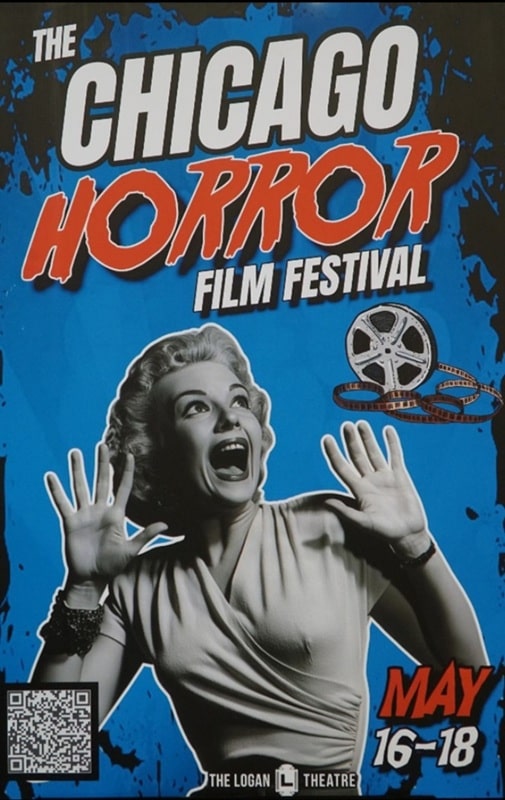 The Chicago Horror Film Festival 2025
The Chicago Horror Film Festival 2025
Last, we had to tell you about two other Midwest events coming soon. The Chicago Horror Film Festival 2025 celebrates its 26th year at the Logan Theater May 16-18. Touted as one of the top 10 horror festivals worldwide, CHFF showcases a curated selection of independent horror films from around the globe, including local and international shorts and features. Tickets start at just $10, with full weekend passes available for $68.99.
The Milwaukee Horror Con returns for its “Fall Frightmare” edition from September 5–7, 2025, at the Four Points by Sheraton Milwaukee Airport Convention Center. As Wisconsin’s only dedicated horror convention, this three-day event promises an immersive experience with horror legends, indie film screenings, themed vendors, cosplay contests, and late-night thrills.
As for GalaxyCon, they are aggressively broadening the reach of Nightmare Weekend to new cities in 2025, including:
- Nightmare Weekend Cleveland: August 29–31, 2025, at the Huntington Convention Center in Cleveland, Ohio.
- Nightmare Weekend Des Moines: September 12–14, 2025, at the Iowa Events Center in Des Moines, Iowa.
- Nightmare Weekend Richmond: October 17–19, 2025, at the Greater Richmond Convention Center in Richmond, Virginia.
- Nightmare Weekend Savannah: November 14–16, 2025, at the Savannah Convention Center in Savannah, Georgia.
A huge thanks to Justin Burkhardt and the Nightmare Weekend promotions team for including us in this first-ever event. We can’t wait for next year.
Life Lessons from David Cronenberg
Let me begin with two assertions, each of which is, in the immortal words of Vincent Vega, “a bold statement.” First: David Cronenberg is one of our greatest directors, and there is nothing he has done that isn’t worth seeing. Second: I am the dumbest, most suicidally foolhardy person you will ever meet. The first statement is arguable, ultimately a matter of opinion, but the second is not, because I can prove it. In fact, I can use the first proposition to establish the validity of the second one.
In case you’ve been living under a rock for the past fifty years, David Cronenberg is the Mutant King of body horror; in stomach-churning, Manson Family date movies like Rabid (an extremely icky form of vampirism), The Brood (nasty little “rage monsters” popping right out of poor Samantha Eggar), Scanners (you want exploding heads — you’ve got exploding heads), and Videodrome (I… I can’t even talk about it, and to this day, neither can James Woods) he set new standards in shockingly gross special effects and in the number of times he forced audience members to barf in their popcorn buckets or make panicked rushes to the restroom.
I thought all these movies were terrific (and not just because of the wild effects — wipe off all the blood and underneath you’ll find a sharp, mordant intelligence with something serious to say), so when Cronenberg’s version of The Fly hit the multiplexes in 1986 it was a must-see for me, and it was with high hopes that I took my lovely wife of barely eighteen months to see it. We were both looking forward to a fun night at the movies. Well…
I had a great time.
Marianne, on the other hand, checked out when Geena Davis gave birth to a bouncing baby maggot (which, to be fair, happened in a dream, so I don’t think it really counts) and spent the last twenty minutes of The Fly hunched over in her seat with her eyes tightly closed, waiting for me to give her the all clear, so she missed John Getz getting his hand dissolved into a bloody stump by fly-spit, Jeff Goldblum’s final insect form emerging while big chunks of his raw red flesh fell off and went splat on the floor, and the bug’s tragic end when his head gets blown to smithereens by a shotgun blast. (She assures me that hearing it all was just as nauseating as seeing it would have been.)
Hey, it was just one rocky evening at the movies; it could have happened to anyone. The main thing is to learn from an experience like that, right?
Fast-forward to 1988. Now the movie creating all the buzz isn’t The Fly — it’s a little something called Dead Ringers. Yeah, I know who directed it, but there are no exploding heads or weird vaginal apertures appearing where they have no business being in this movie. This one is a showcase for serious acting; it’s a character study, you know?
So it was that I persuaded my wife to go to another David Cronenberg movie. (I actually forgot to mention that he was the director. I guess it just slipped my mind.) Not only that, but I also convinced two of our closest friends to come along, women my wife taught school with. This will be great! Diane and Susan are going to love this movie, honey! It’s based on a true story! (Obviously, my motto is, “Be stupid. Be very stupid.”)
I wasn’t lying; Dead Ringers is a great movie, and it is indeed a brilliantly-acted character study. By any measure it’s a darkly seductive, ravishingly shot knockout.
So far, so good. There’s just one problem. Dead Ringers is also, first and foremost, a David Cronenberg movie. And there lies the rub.
Dead Ringers is about identical twin brothers, Elliot and Beverly Mantle, both played by Jeremy Irons. Elliot is smooth, socially ambitious, self-assured and confident (often too much so), while Beverly is introverted, cautious, and much more emotionally vulnerable than his glib twin.
The two characters share a lot of screen time, and one of the best things about the movie is how well Cronenberg employs all the tricks of the trade to make it seem as if Irons really is two different people in the same room together, a task made easier by Irons’ brilliance at subtly differentiating the brothers. (Whenever we see him alone, we instantly know which one he is.)
They are a peculiar pair, these two, and extremely close to each other, even for identical twins. They live together and are in business together, and often one brother seamlessly takes the other’s place when they have to appear at professional functions and the like, and no one is ever the wiser. (Remember The Patty Duke Show?) However, complications ensue when they start sharing the same lover, Claire Niveau, a movie actress played by Geneviève Bujold. The problem is that, for quite a while, Claire doesn’t know that she’s dealing with two separate people, and when she finds out, she’s not happy. Ooops.
The bulk of the movie is taken up with showing how first Beverly and then Elliot start to come apart under the pressure of their extraordinary personal and professional charade, with both brothers eventually becoming delusional drug addicts and descending into outright madness. As you might guess, it doesn’t end well, and things really go downhill when the fraternal craziness starts to manifest itself at the workplace; the whole ghastly situation is made far worse because of the unique nature of the twins’ profession.
What? I didn’t mention what the Mantle brothers do for a living? How careless of me.
No, they’re not architects. They don’t work at the DMV. They’re not certified public accountants or major league baseball players or long-haul truck drivers.
They’re gynecologists.
You begin to appreciate the depth of my folly, don’t you?
I began to think that I had made a mistake during the opening credits, which feature medieval woodcuts of women cross-sectioned to show the children they’re carrying against a background of antique medical instruments that look like they were found lying around Torquemada’s garage; the implications were not comforting.
My growing unease turned to outright panic when an increasingly demented Beverly uses a bulky surgical retractor to conduct an examination on an unfortunate woman; I don’t know if the lady was a method actress, but her winces and grimaces certainly seemed to be coming from someplace real. Halfway through this excruciating scene, I started looking around for an escape route, but I knew it was hopeless; they would drag me down before I made it halfway to the exit.
Then Beverly starts to believe that there’s “something wrong” with “the insides” of all of his patients, that all of the women he’s examining are actually mutants, and he commissions an avant-garde artist to make him a set of “gynecological instruments for working on mutant women.” They look like fruit hanging from a tree on some nightmare alien planet.
The twins operate a fertility clinic (judging from the body of his work — no pun intended — you have to believe that for Cronenberg, birth holds more horror than death), and when Beverly shows up for an operation with these grotesque instruments and actually tries to use them on a patient, he almost kills the woman and the career of the acclaimed Mantle brothers comes to an abrupt and ignominious end.
Despite my sense of impending personal doom, I was powerfully moved by the film’s somber ending, with the outcast brothers lying dead in each other’s arms, as close as they were in their mother’s womb, as close as they had always been during their tragic lives. It almost brought me to tears, in fact.
The tears on the faces of my wife and our friends, however, were of an altogether different kind. They say that it can get to almost fifty below zero in Antarctica. That’s positively balmy compared to the chill I felt walking out of the theater and in the car on the way home, and I was soon to learn that no lamed and bitter ex-cavalry officer can put as much rage and loathing into the word “stirrups” as your average woman can. Some things, I suppose, are just too personal for art.
Well, it was all a long time ago and all those fine ladies eventually forgave me for making them watch a gynecological horror movie, and I did learn a lesson. A year later, the shoe was on the other foot when I sat in the theater with the same group watching Steel Magnolias, and despite my agony, I knew better than to say a single word. I like having all my limbs.
Three or four years ago, I picked up a beautiful Criterion Collection edition of Cronenberg’s 1996 film of J.G. Ballard’s novel, Crash, which I missed when it was in the theater. When I read the book decades ago, my jaw hung open the whole time; it’s the most radically, shockingly transgressive thing I’ve ever read. Of course David Cronenberg made a movie of it. The Blu-ray has been sitting on the shelf since I bought it; I’ve never yet been able to work up the courage to actually watch it. Once seen, some things can never be unseen.
But I do wonder; some evening soon, Marianne is going to ask, “What are we going to watch tonight?”
What do you think? Should I…
Thomas Parker is a native Southern Californian and a lifelong science fiction, fantasy, and mystery fan. When not corrupting the next generation as a fourth grade teacher, he collects Roger Corman movies, Silver Age comic books, Ace doubles, and despairing looks from his wife. His last article for us was Odd Old Indie: Night Tide







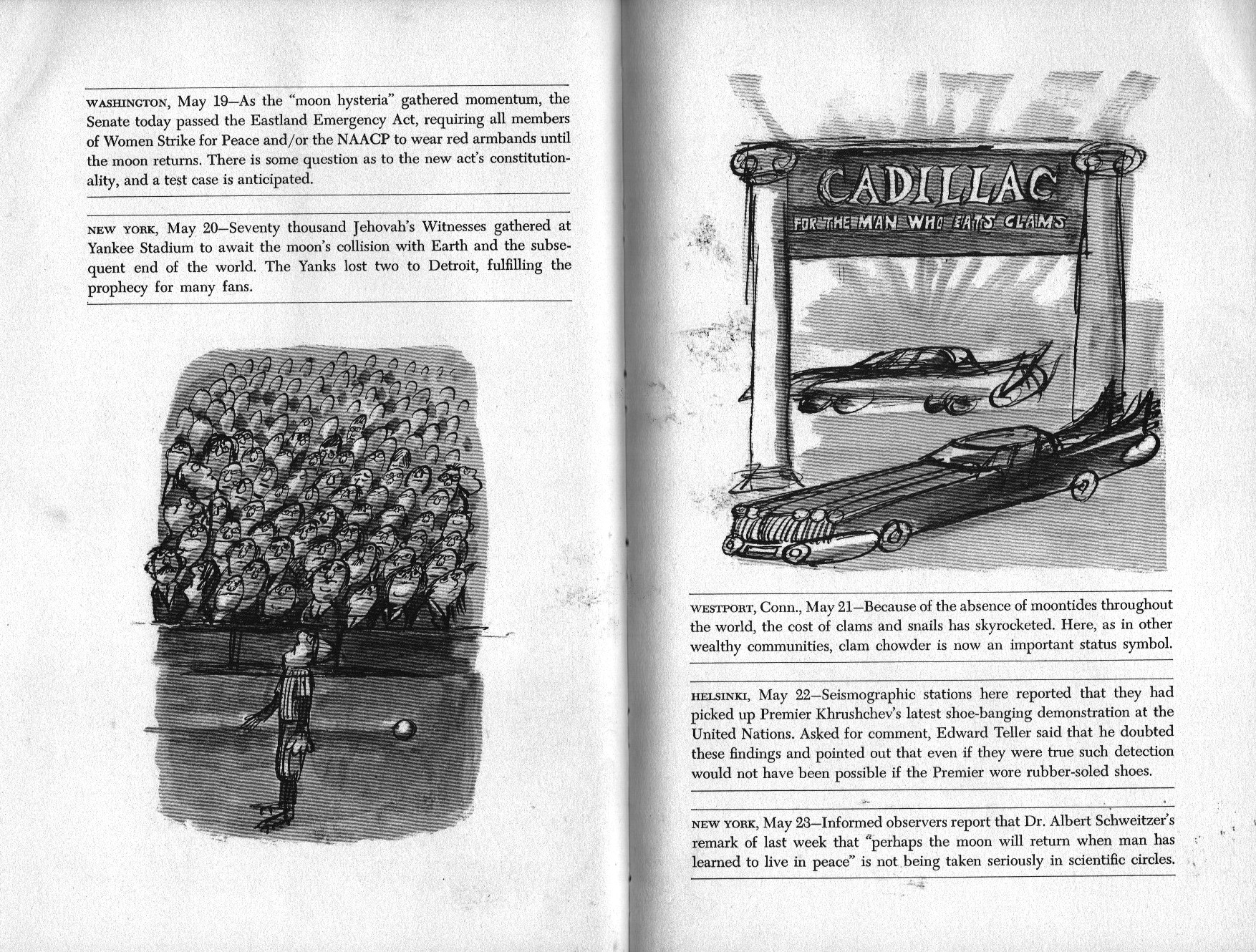
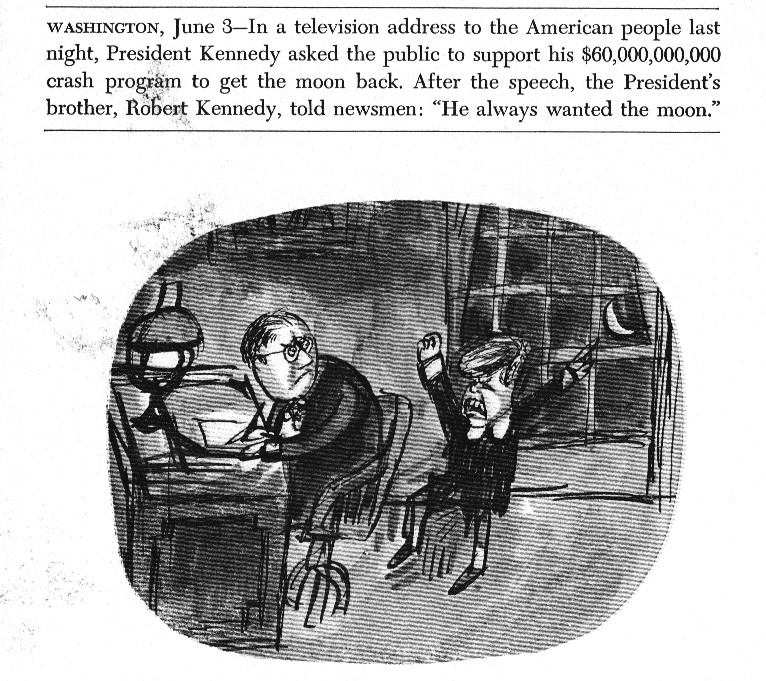
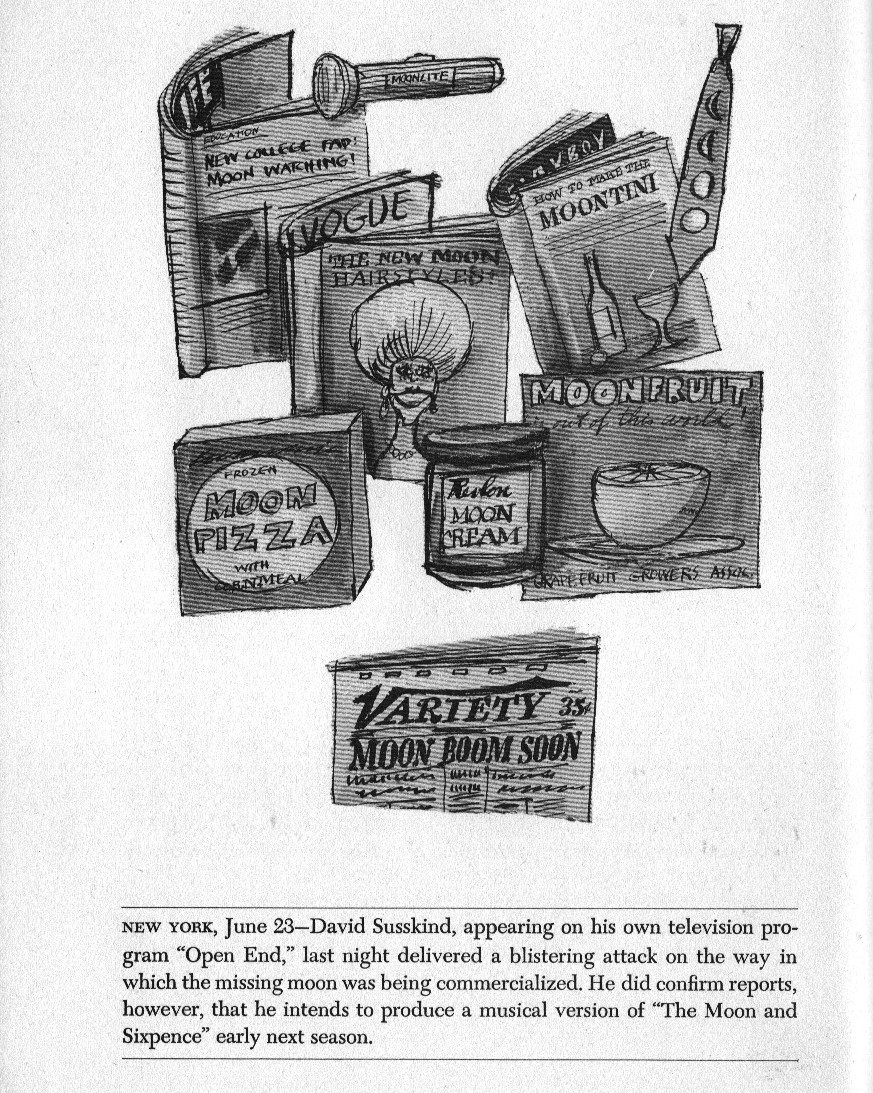
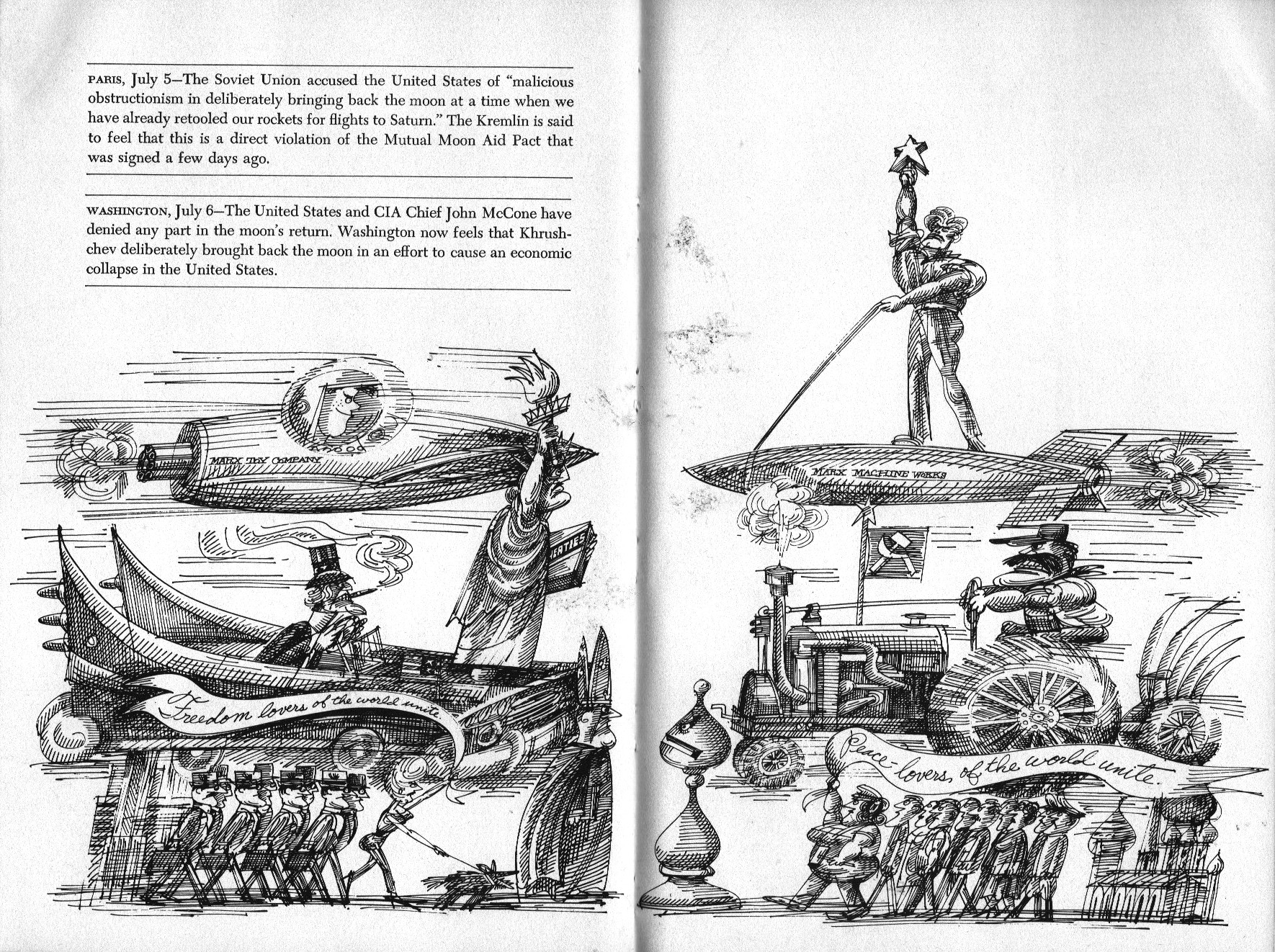
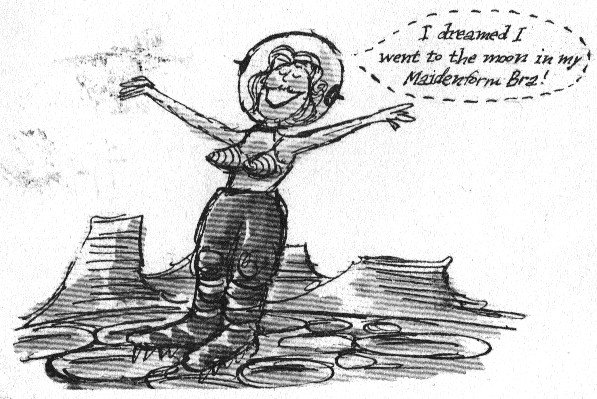



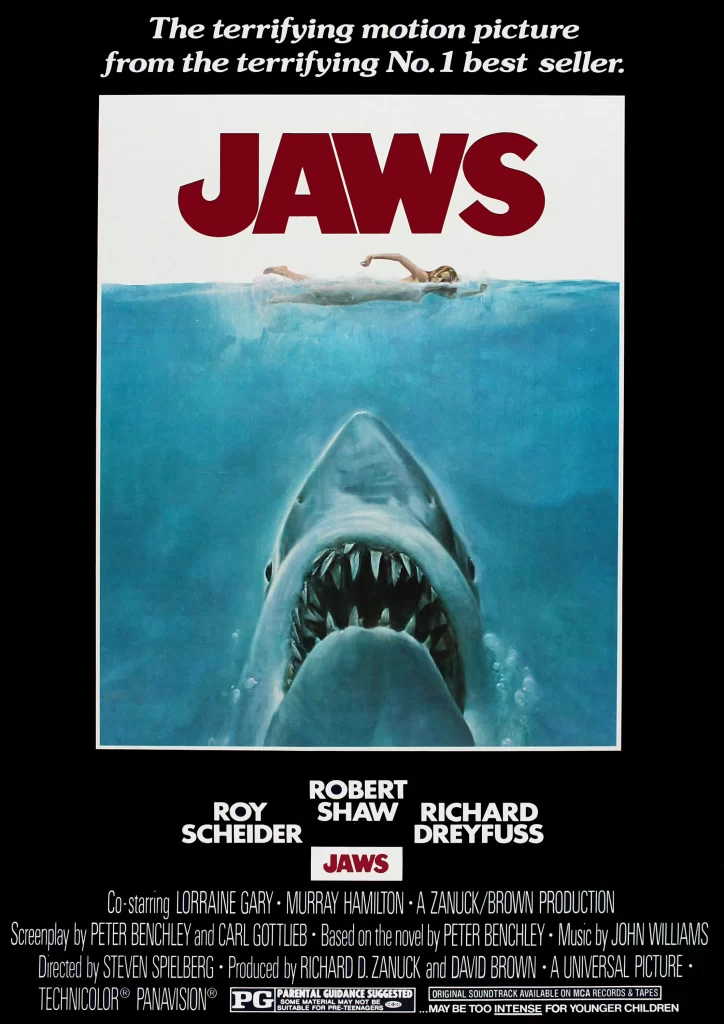
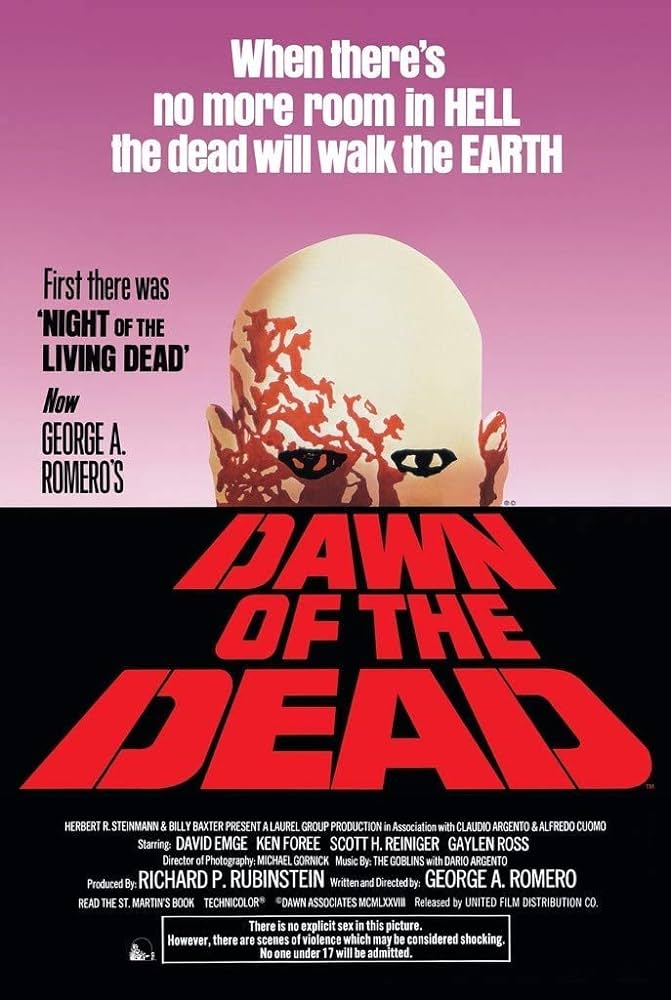

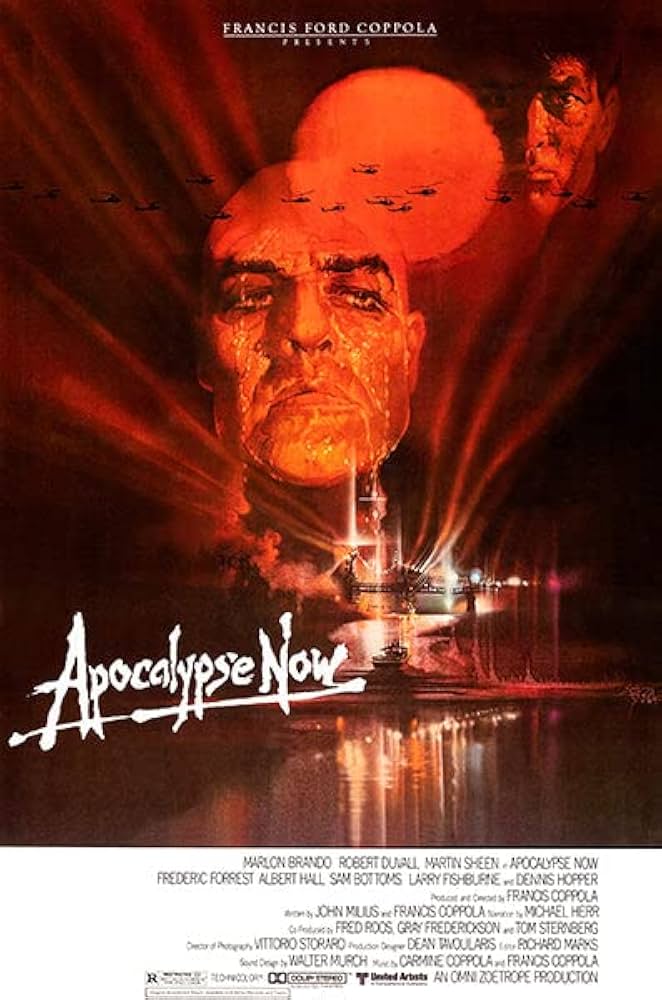
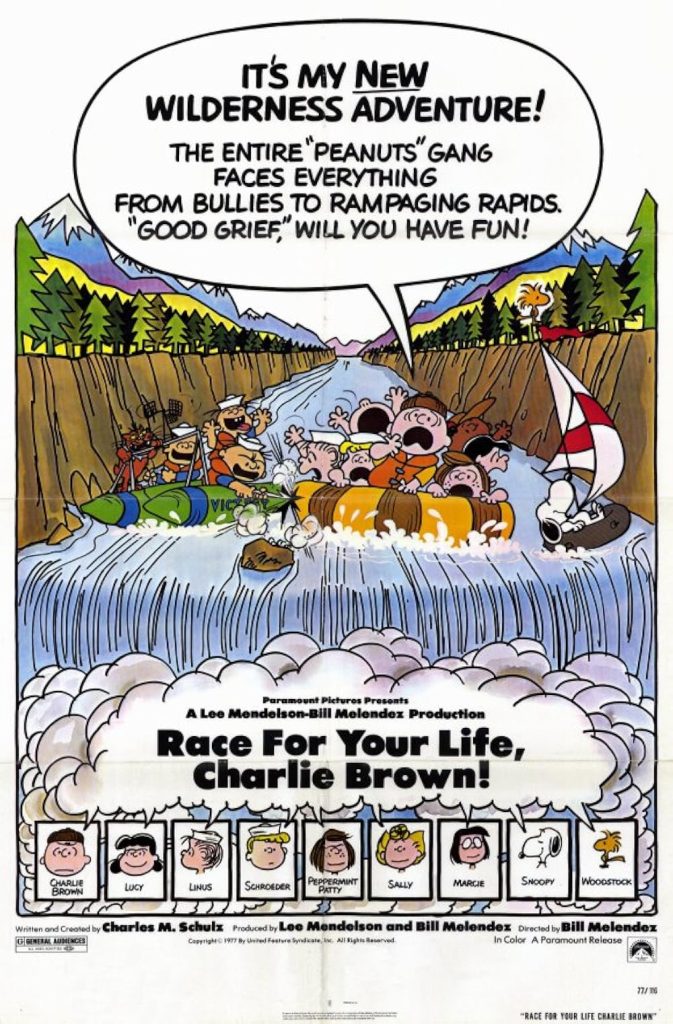

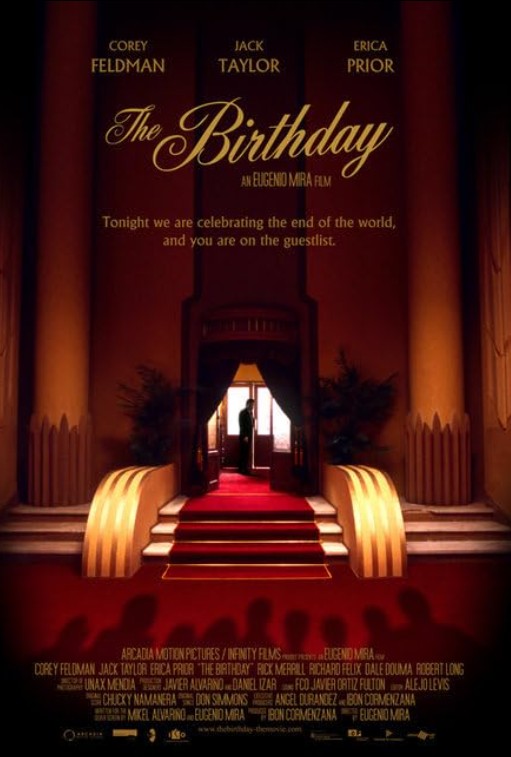

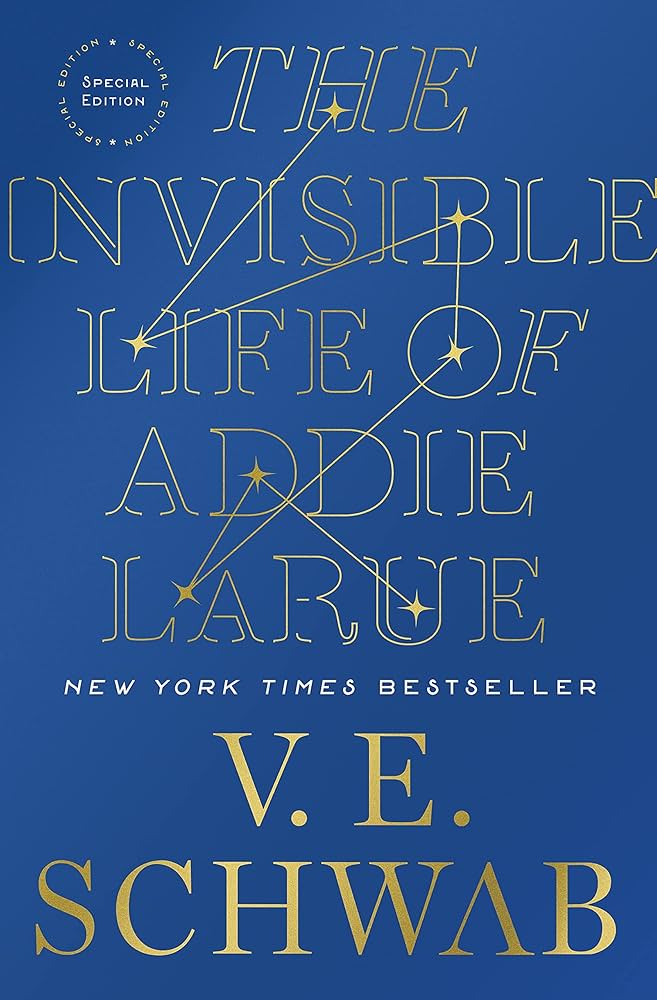


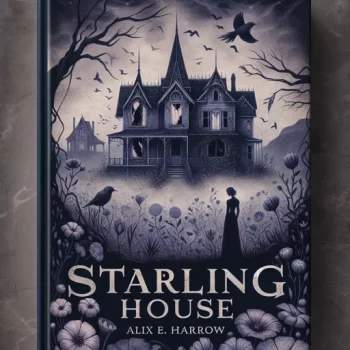

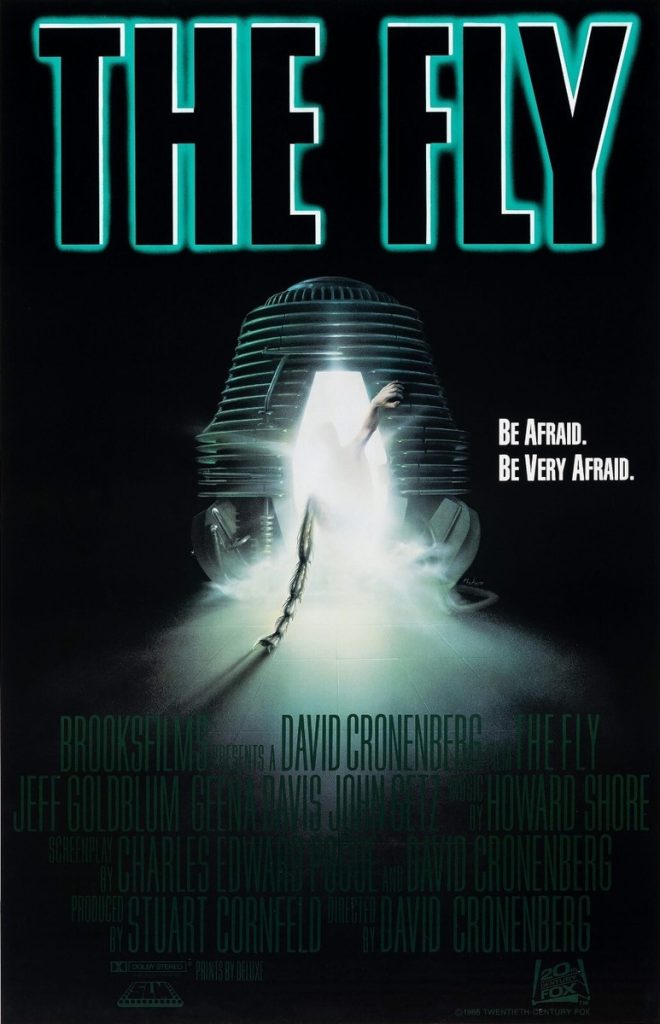
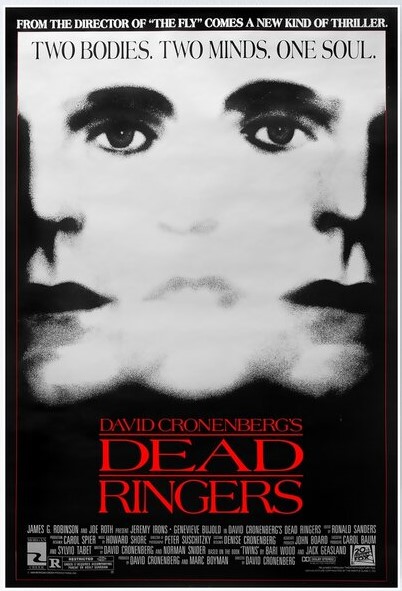
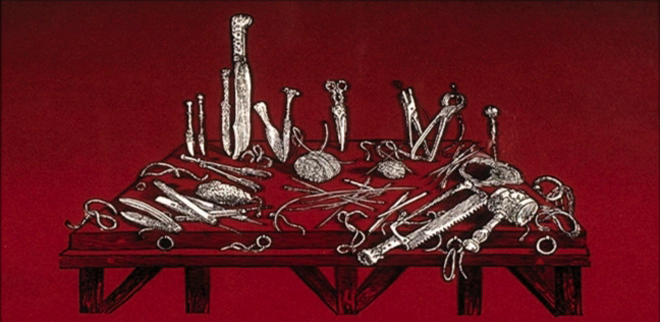
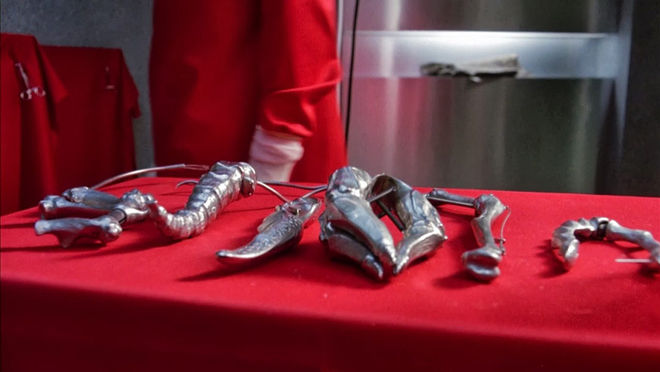
Recent comments